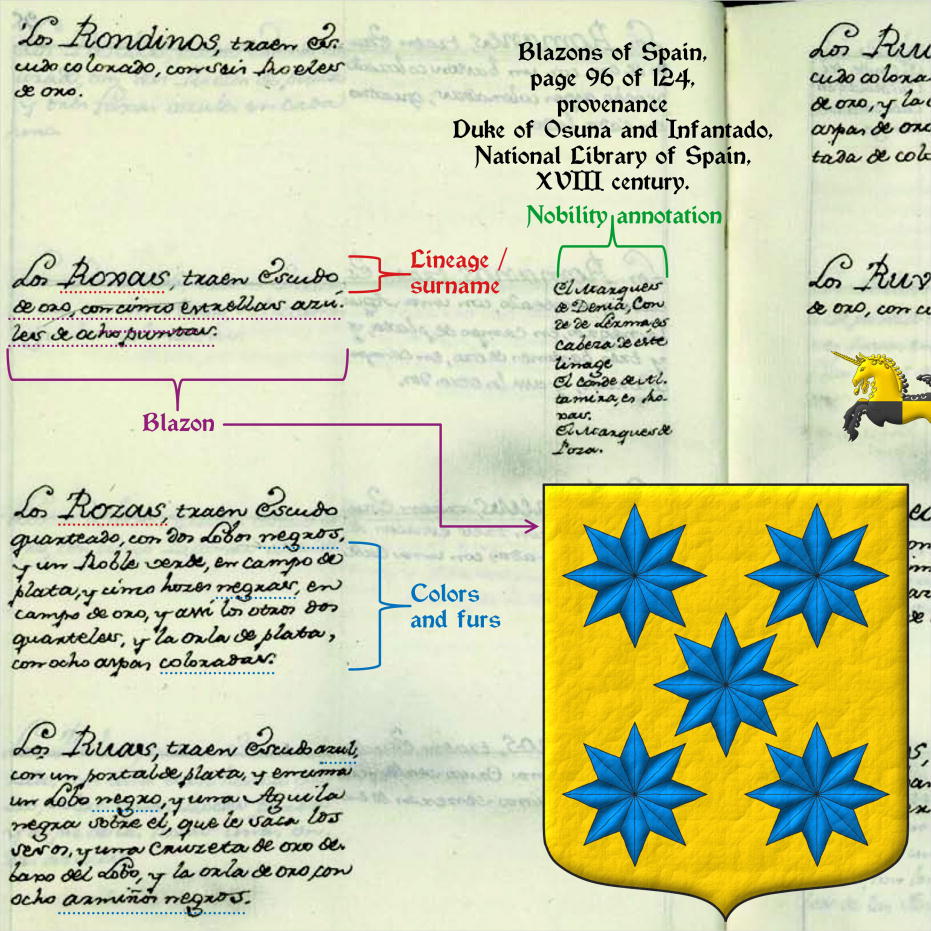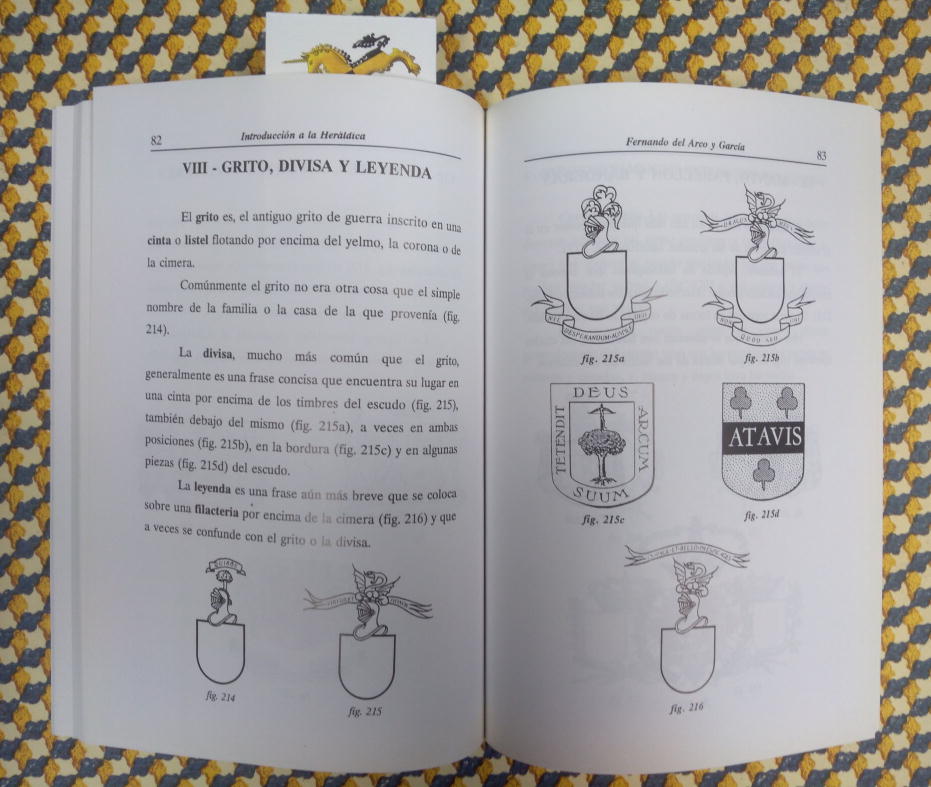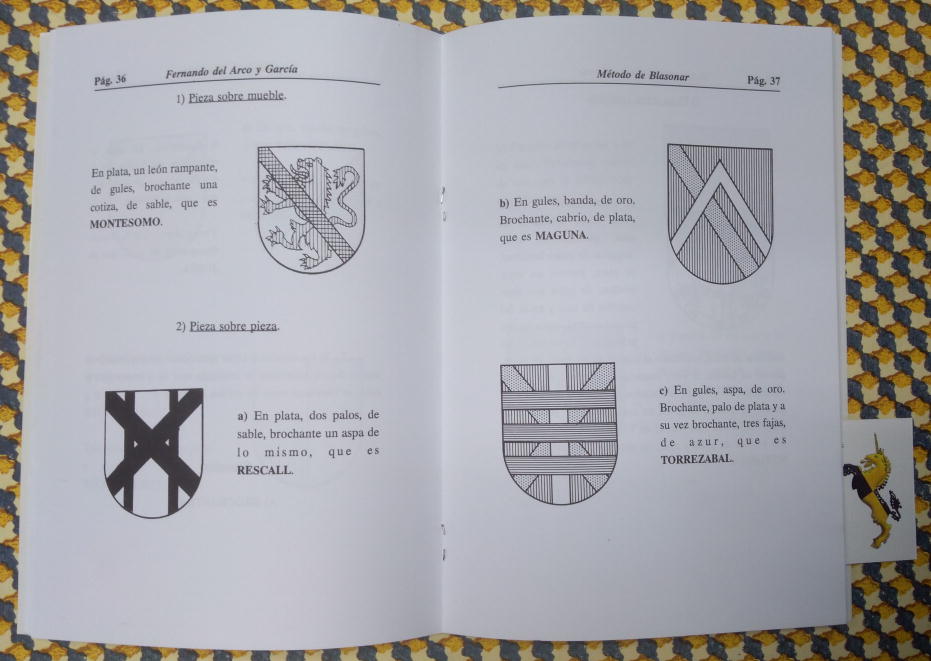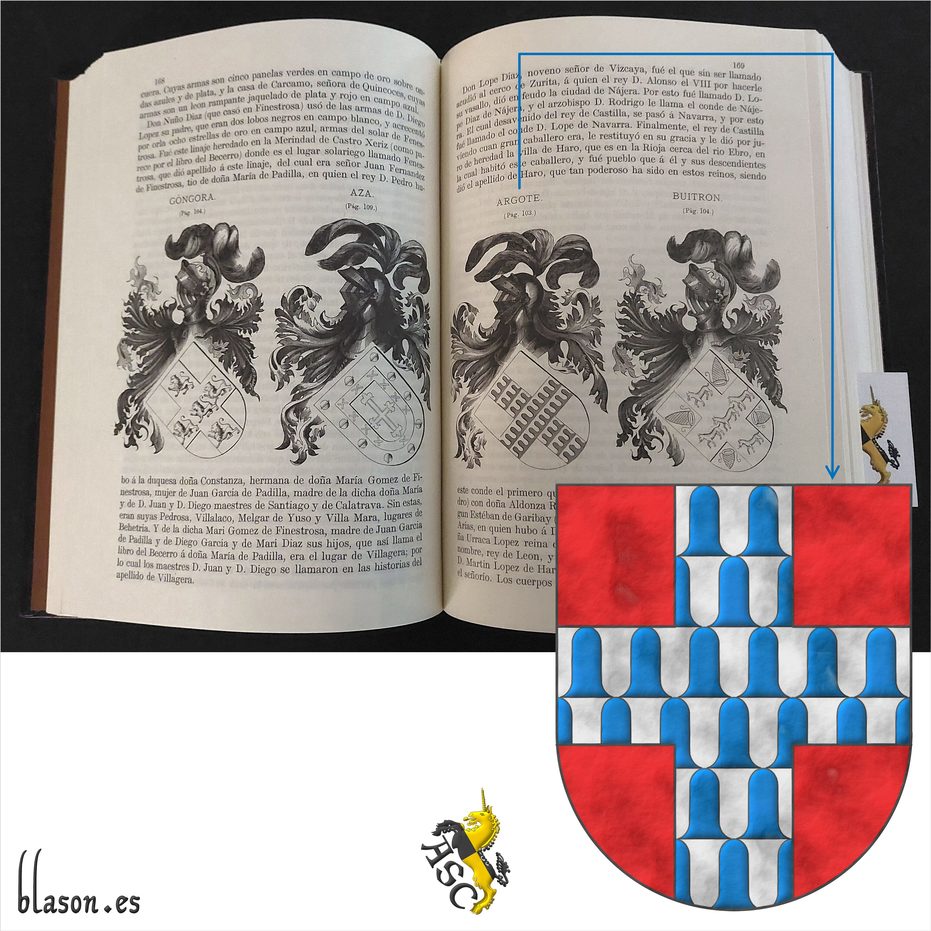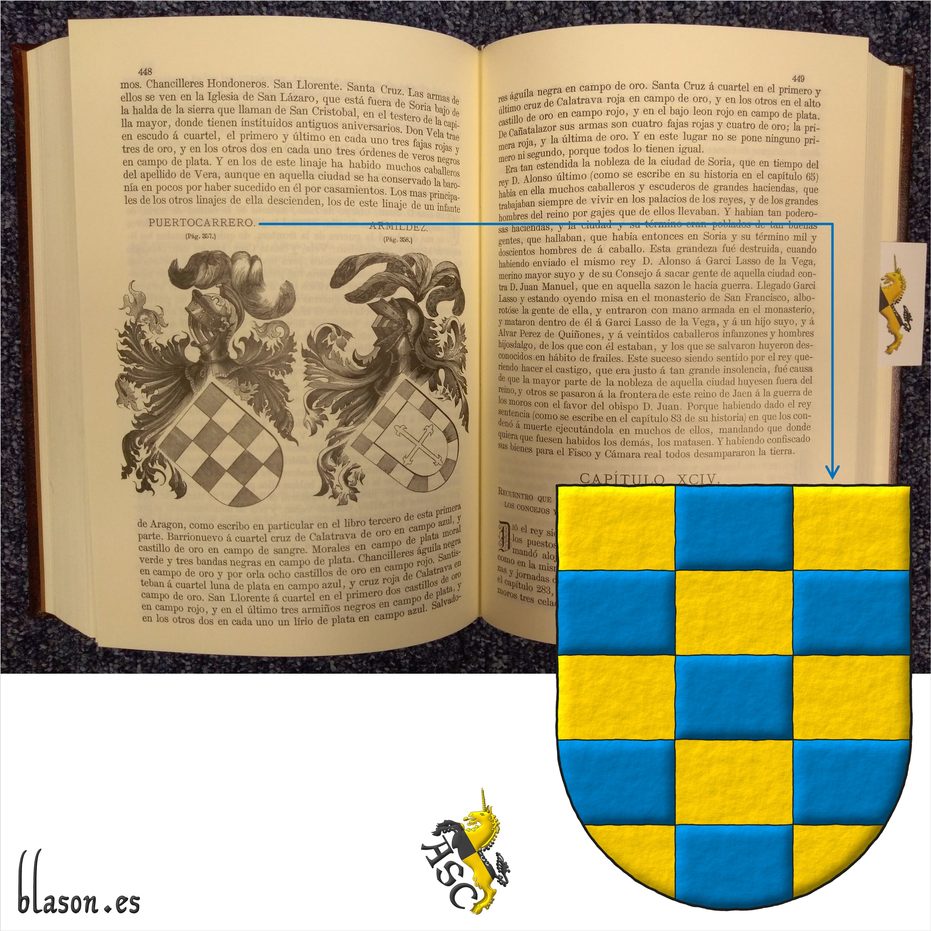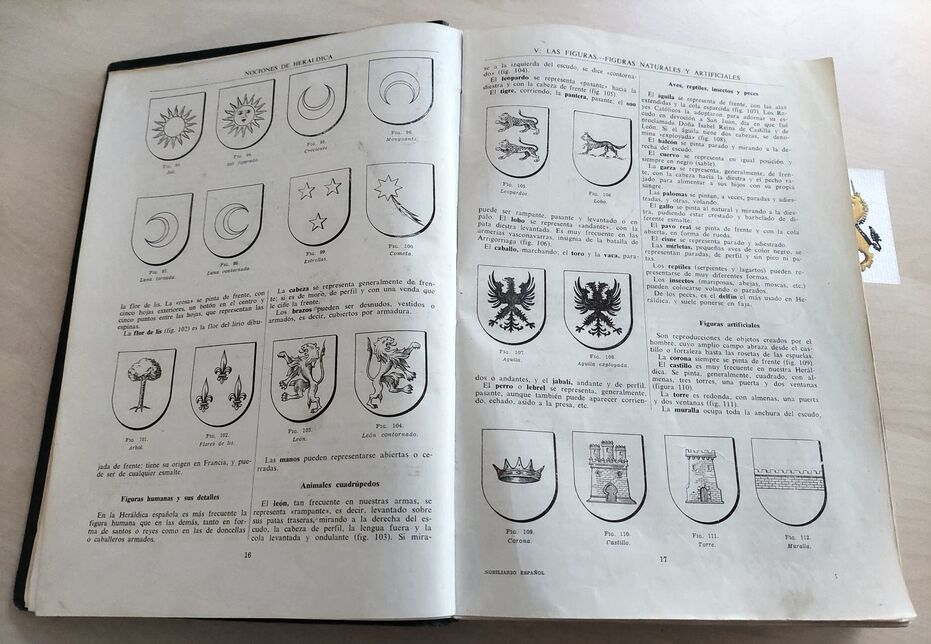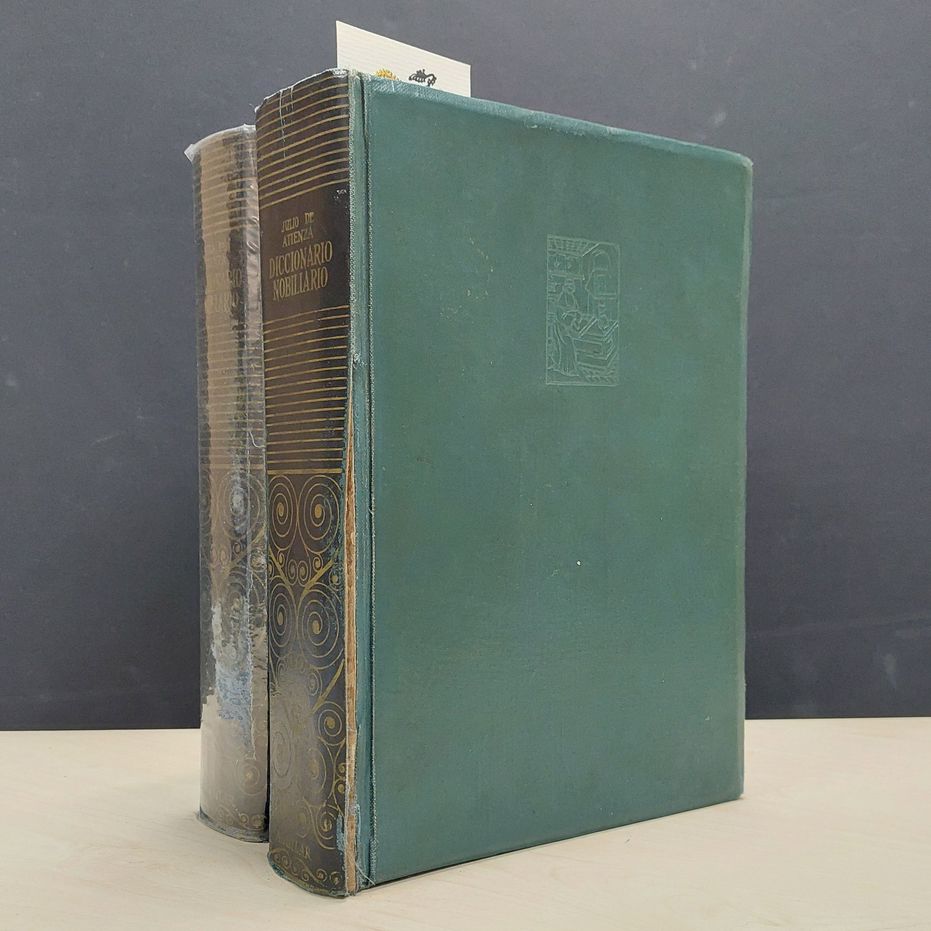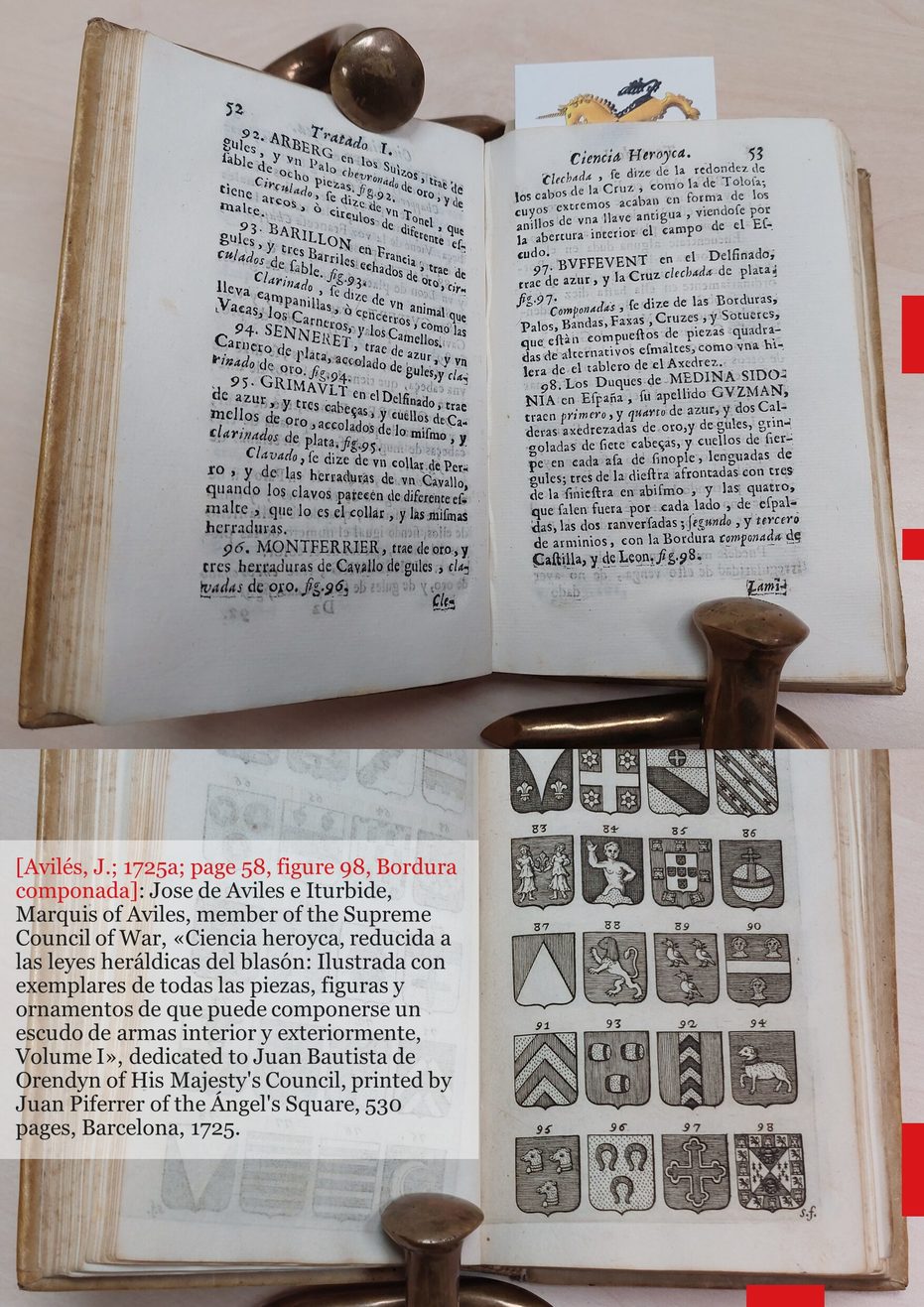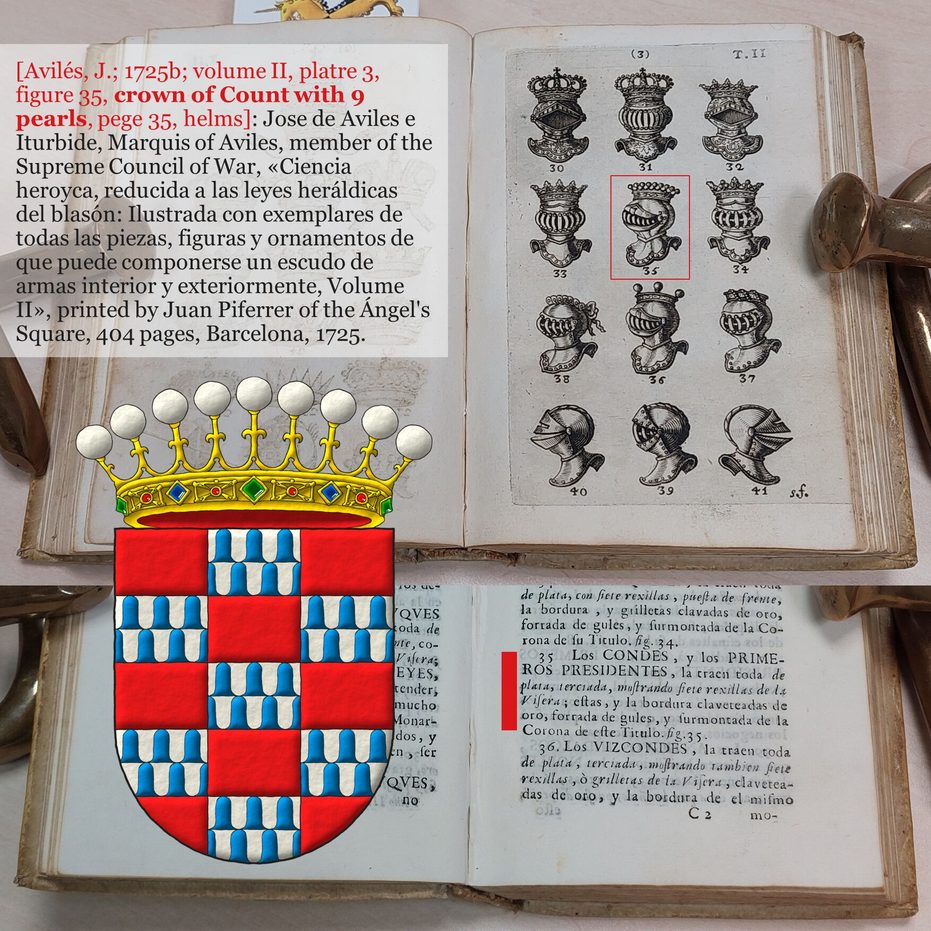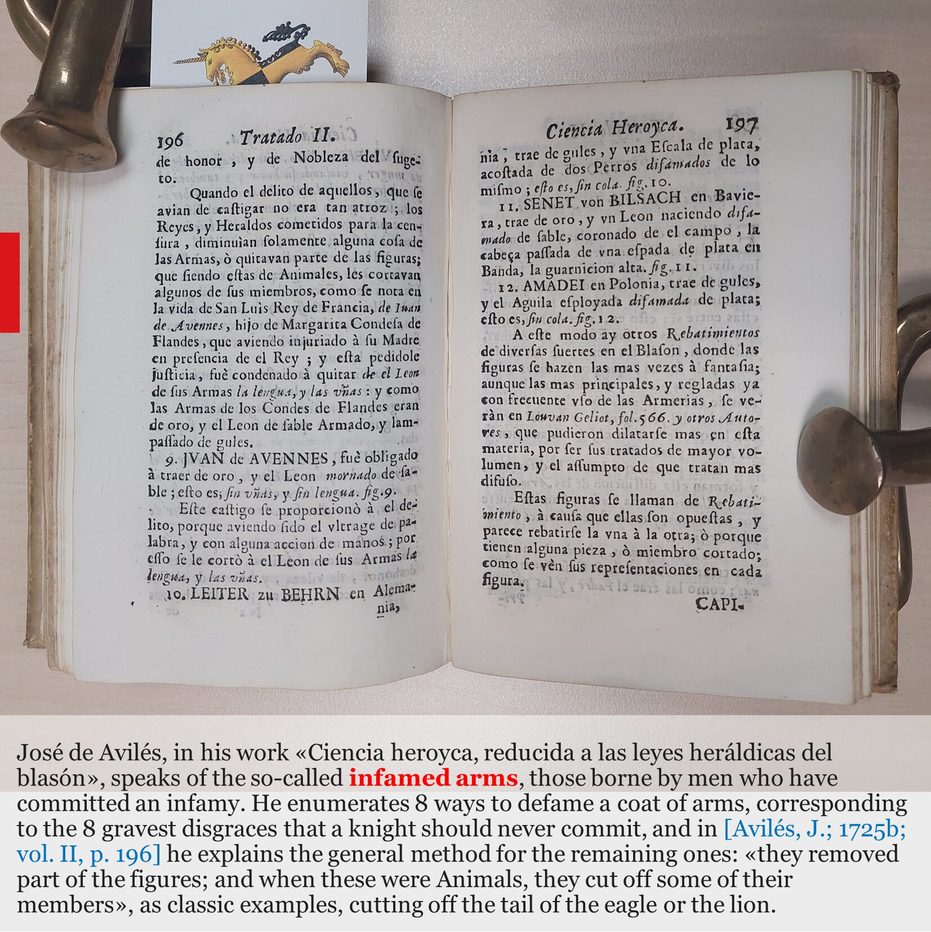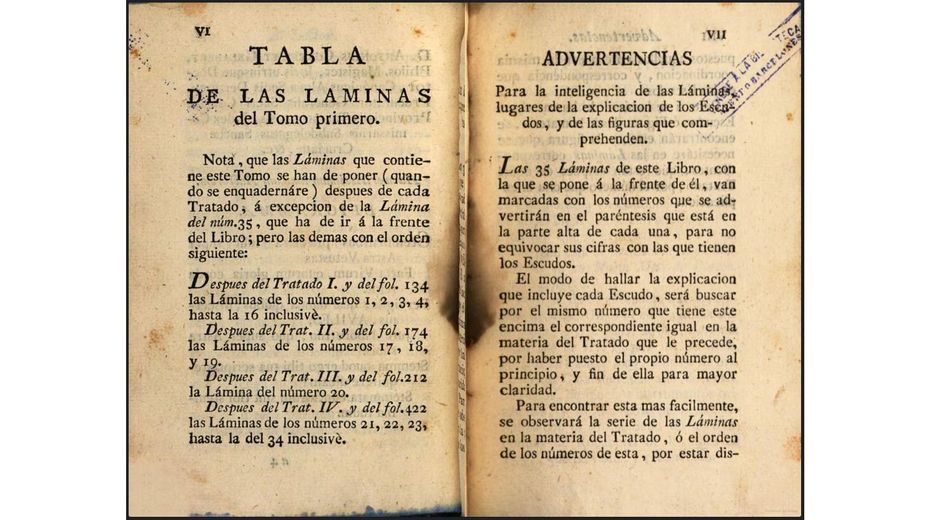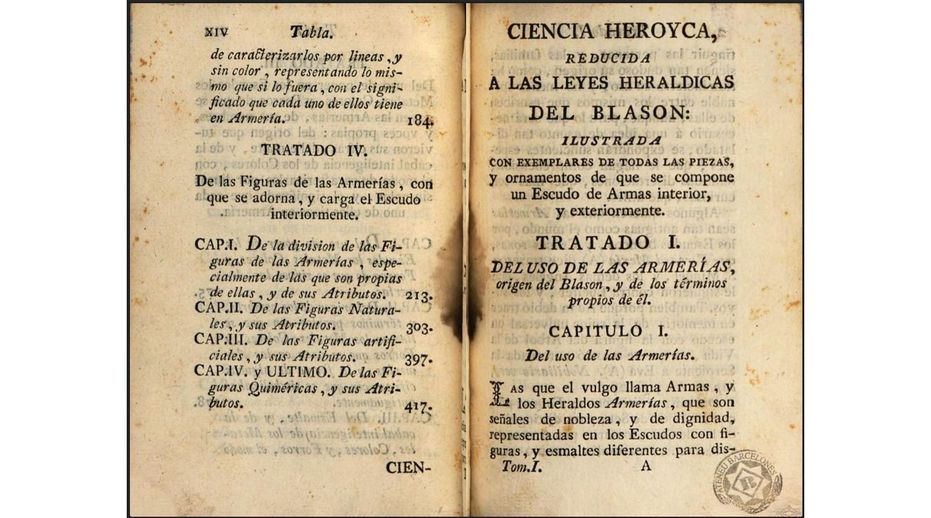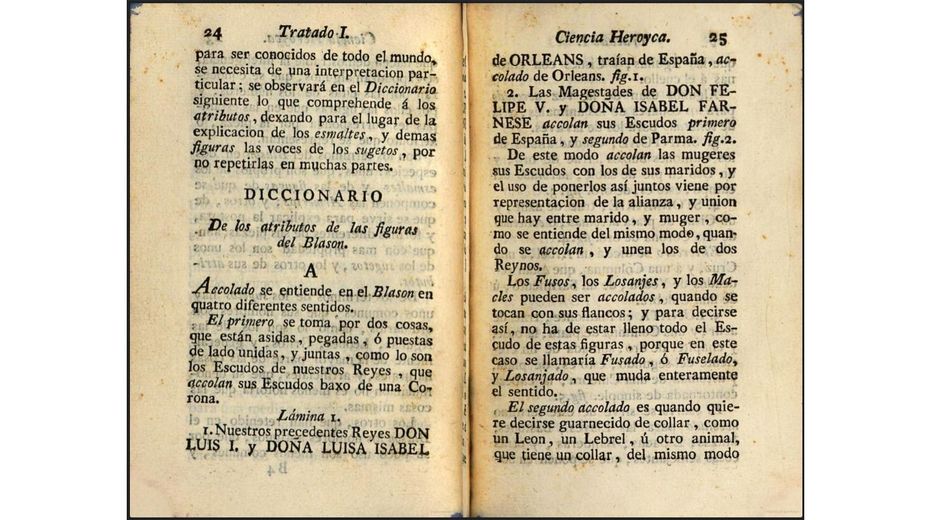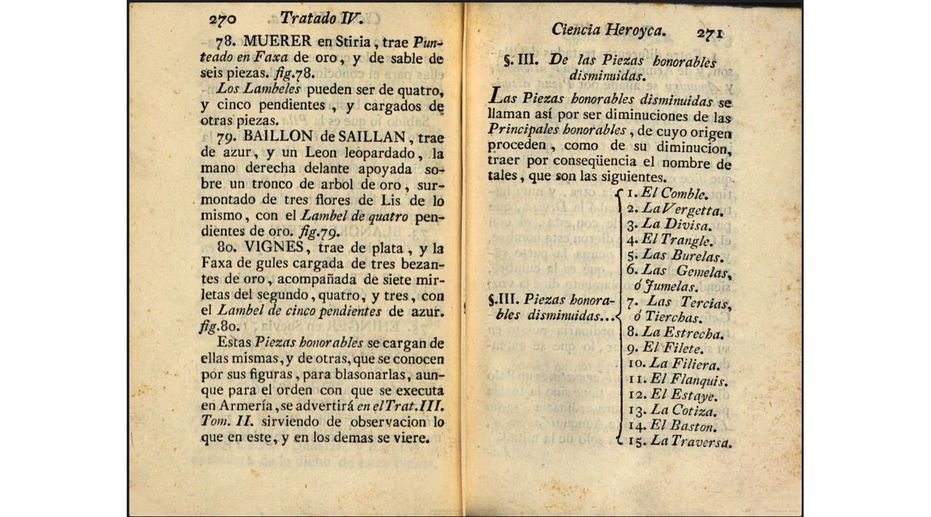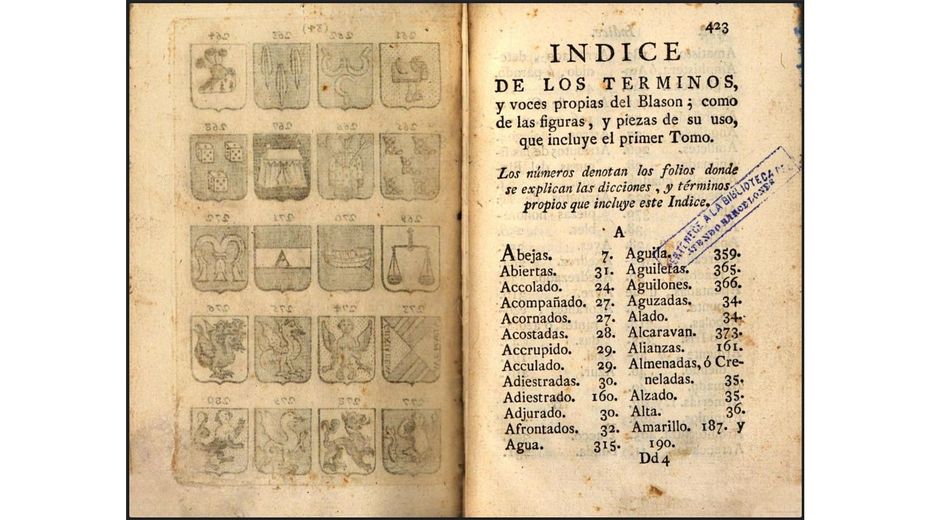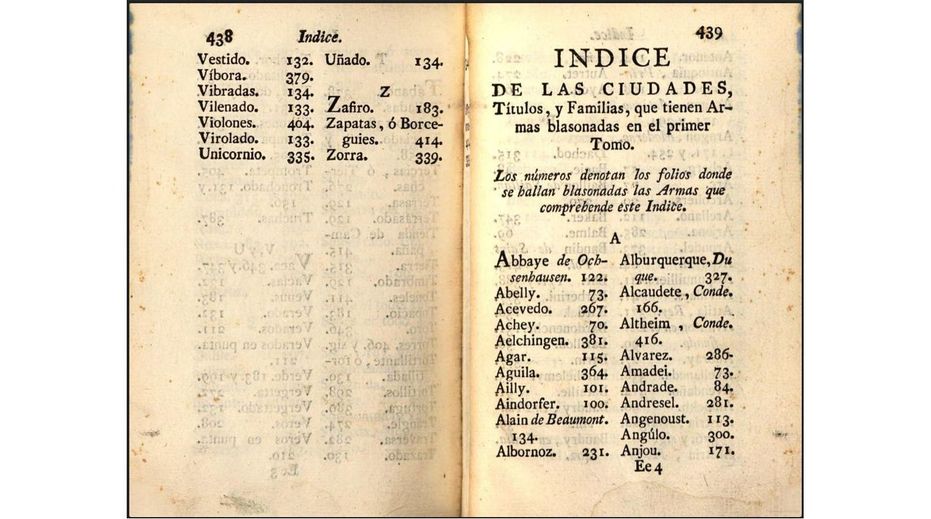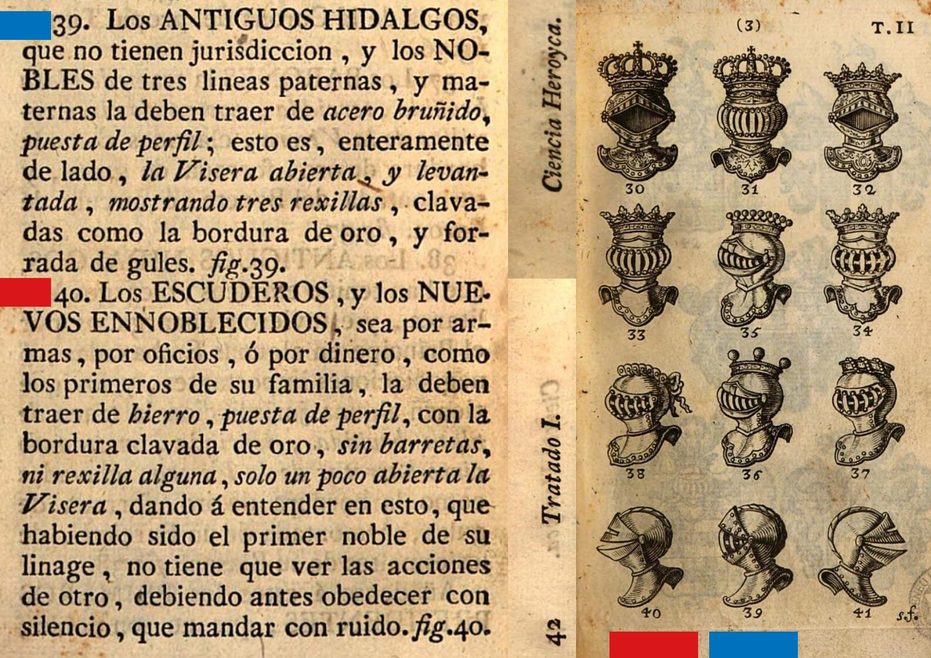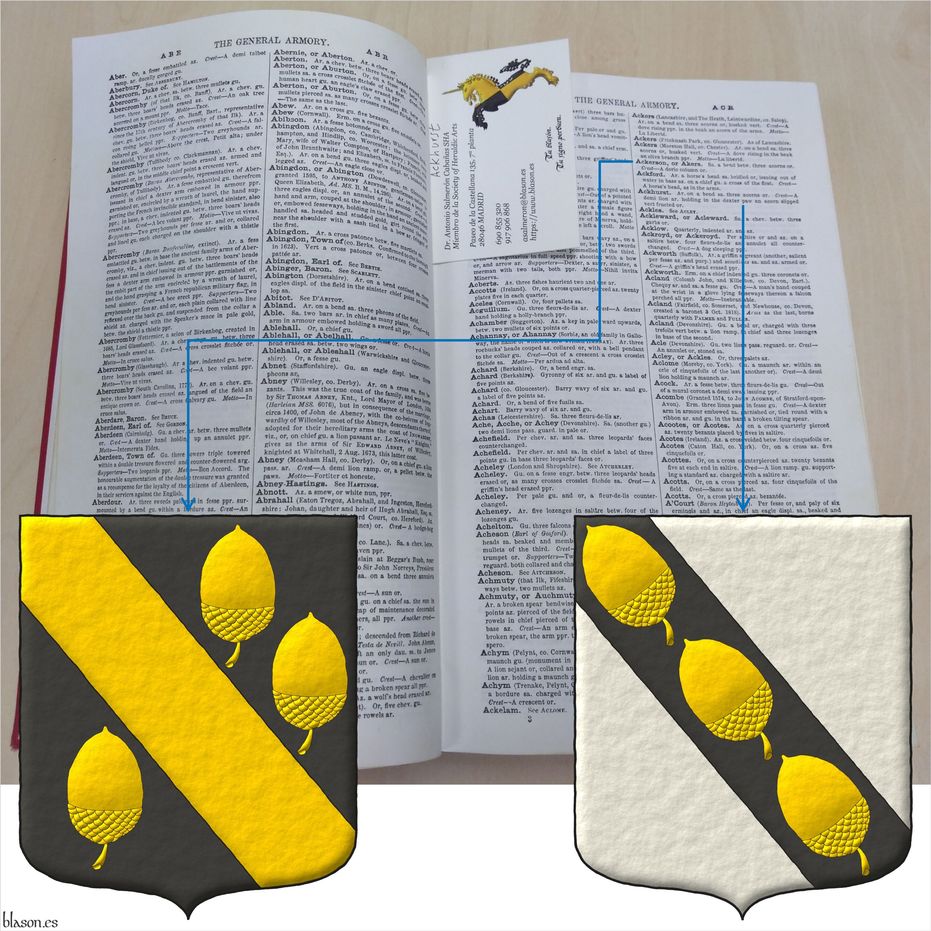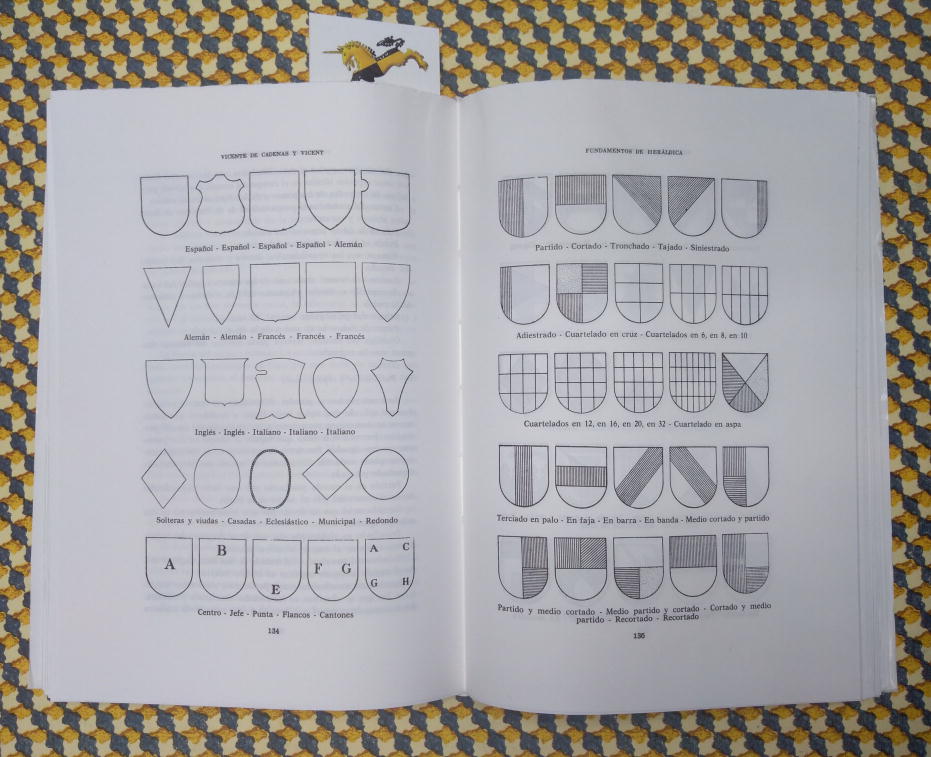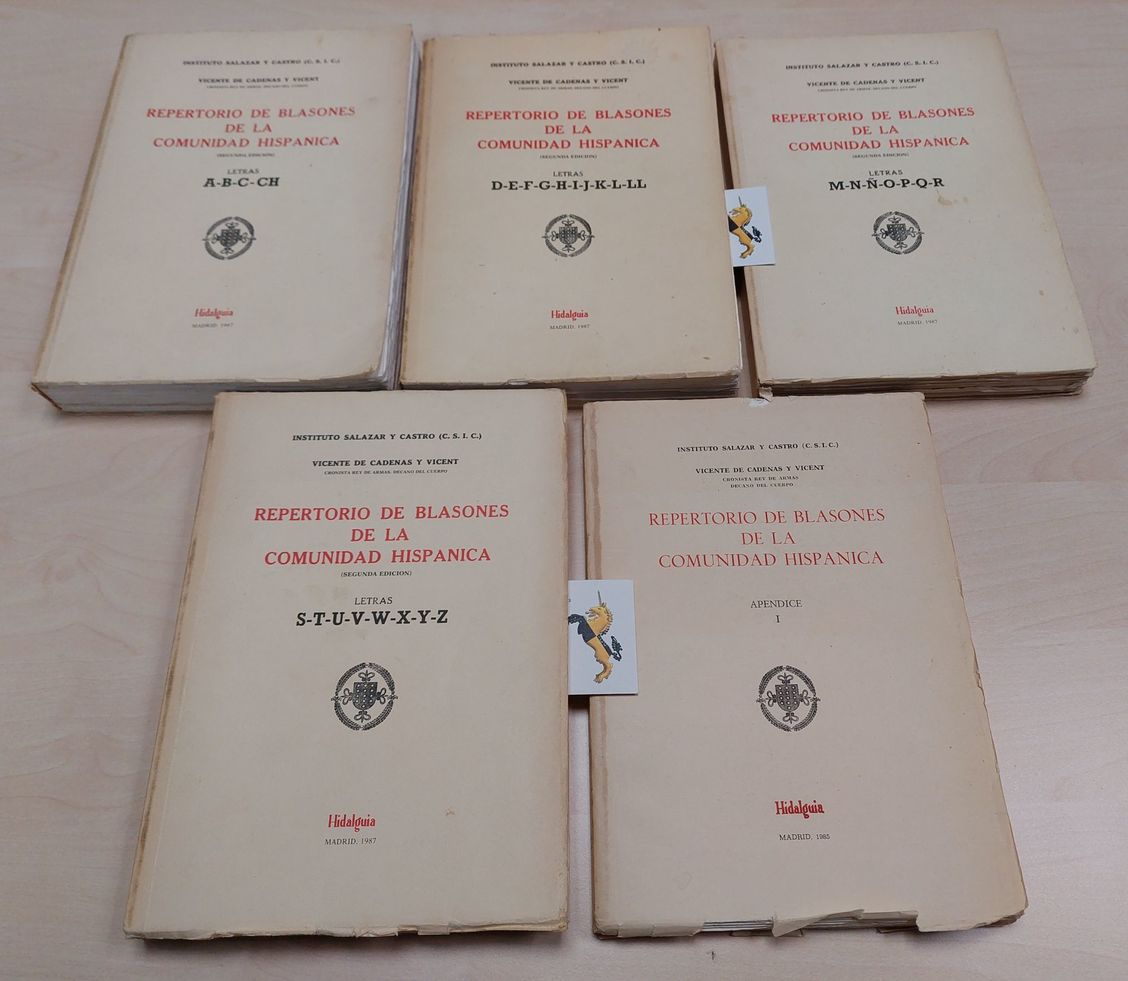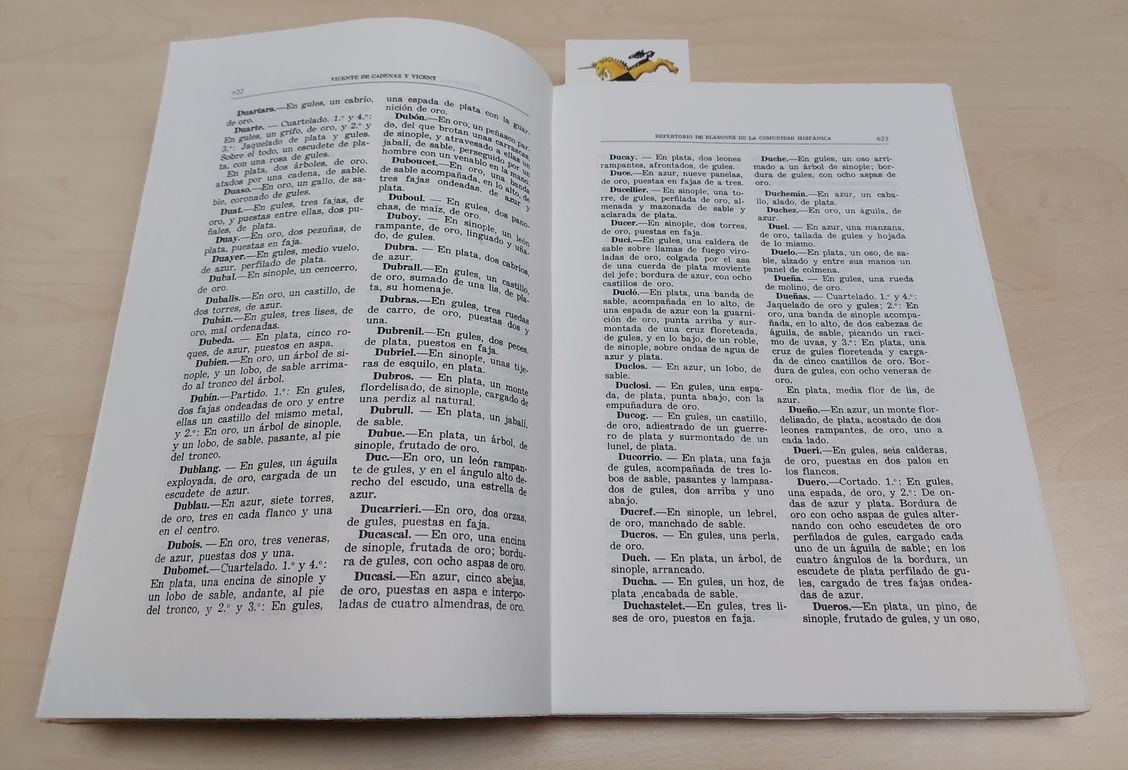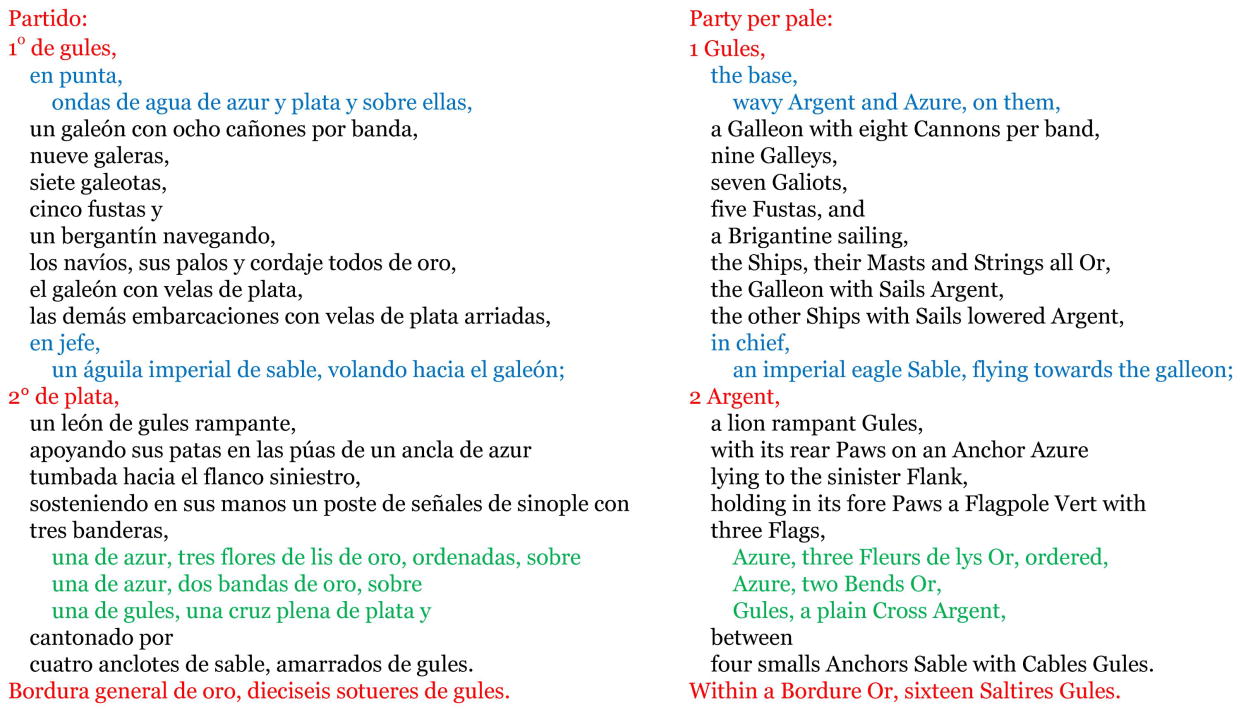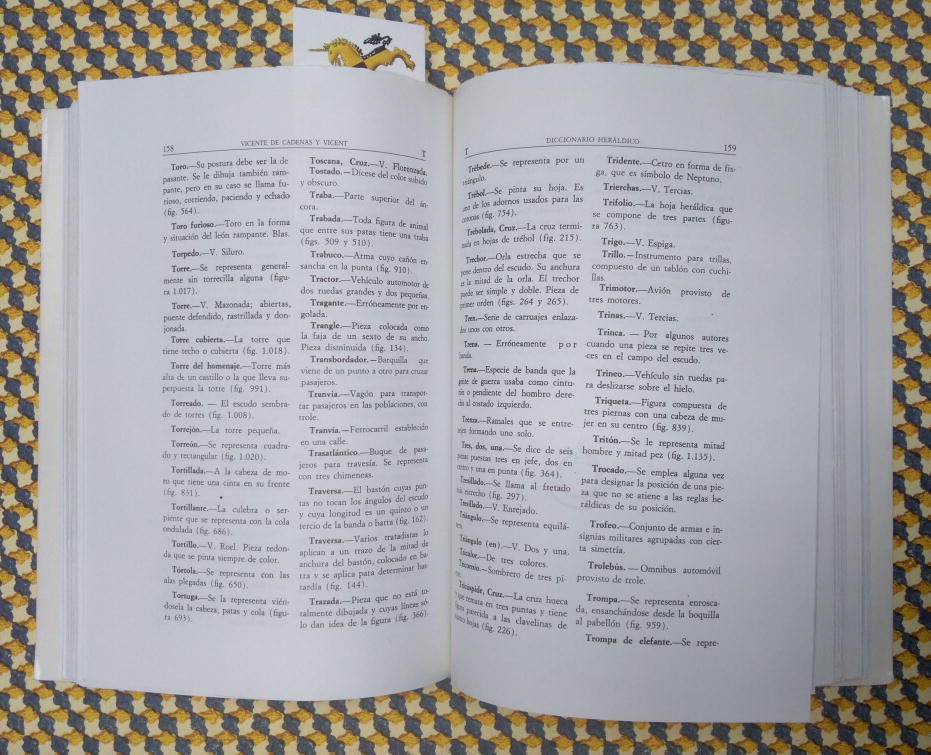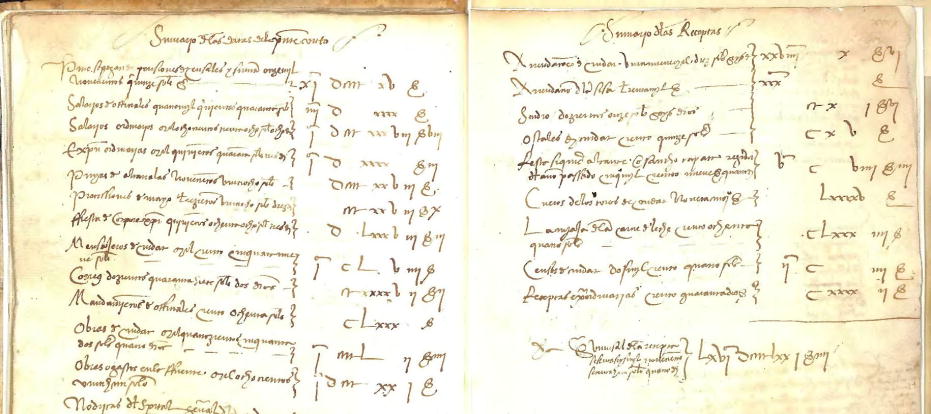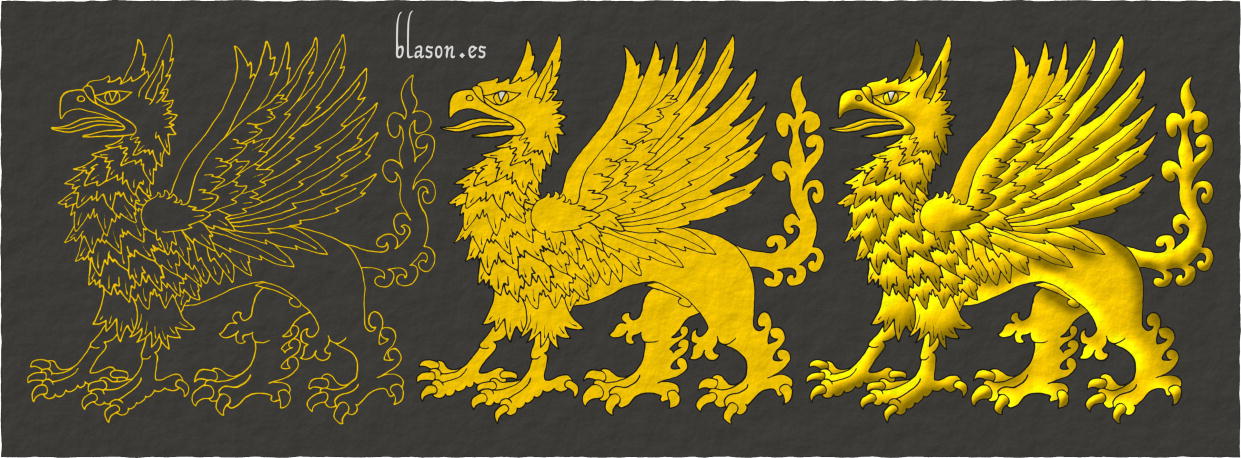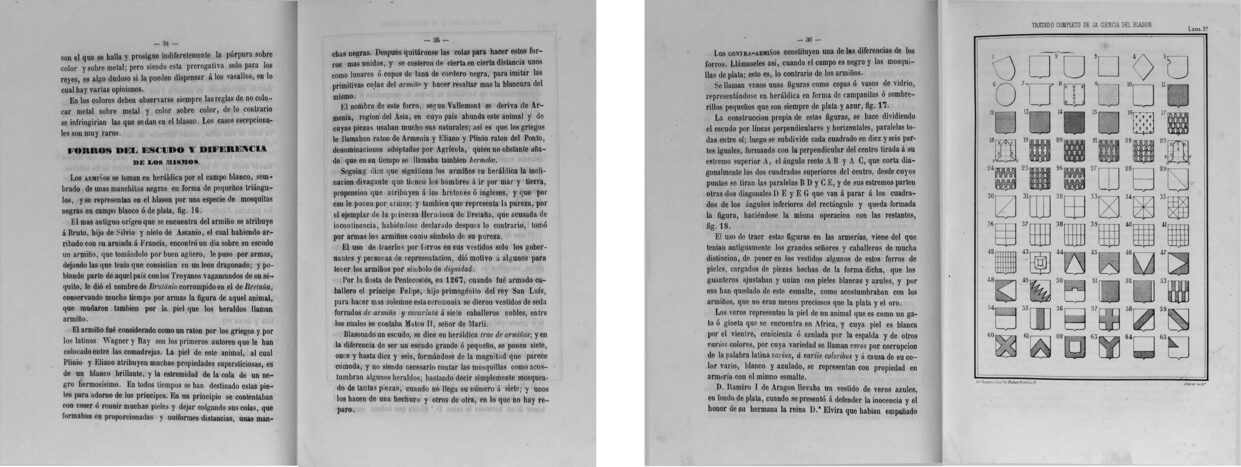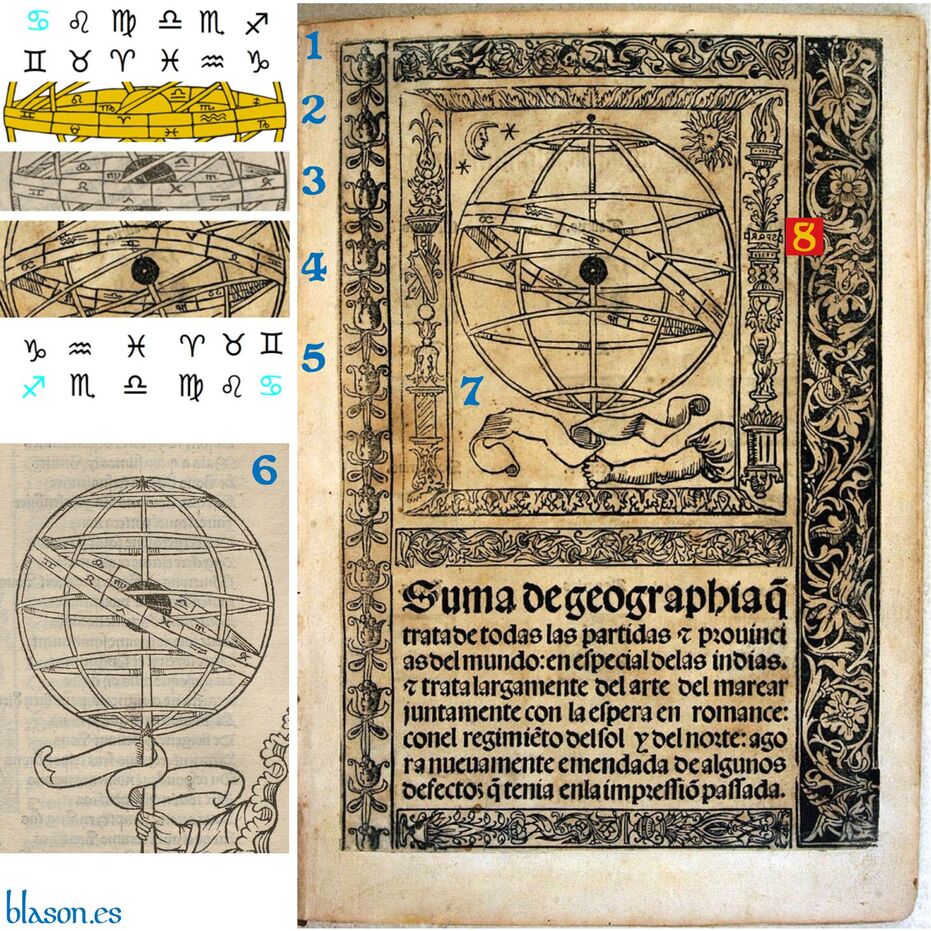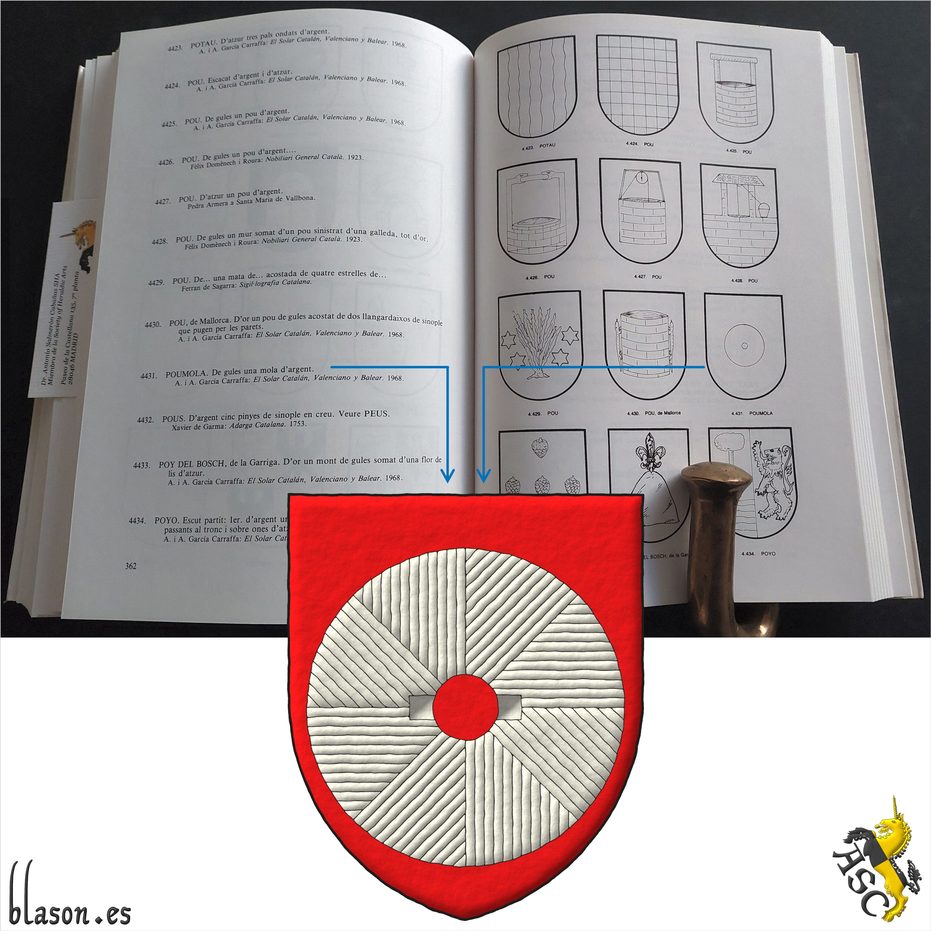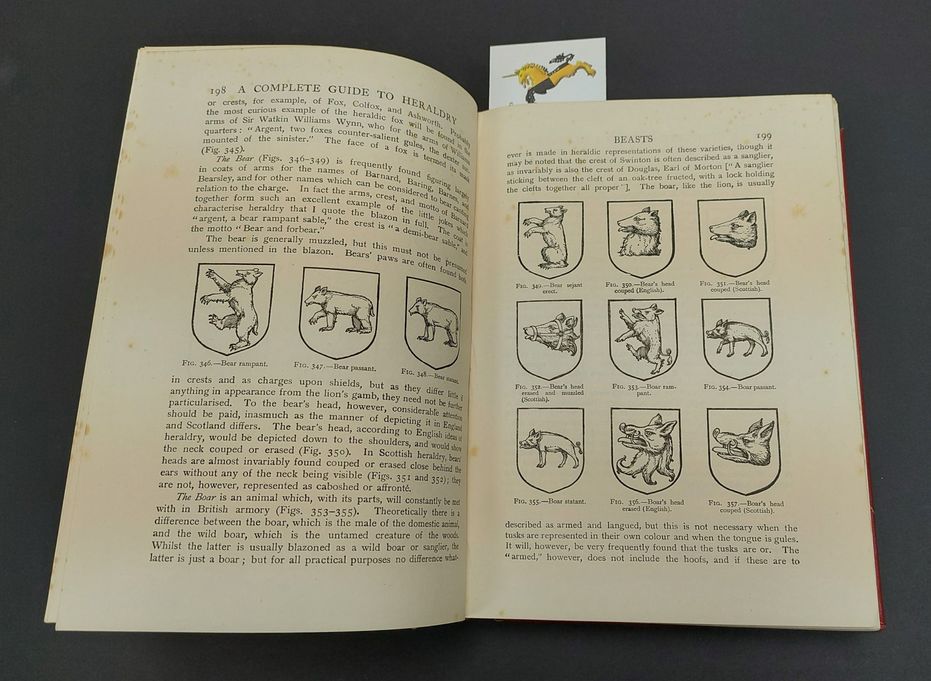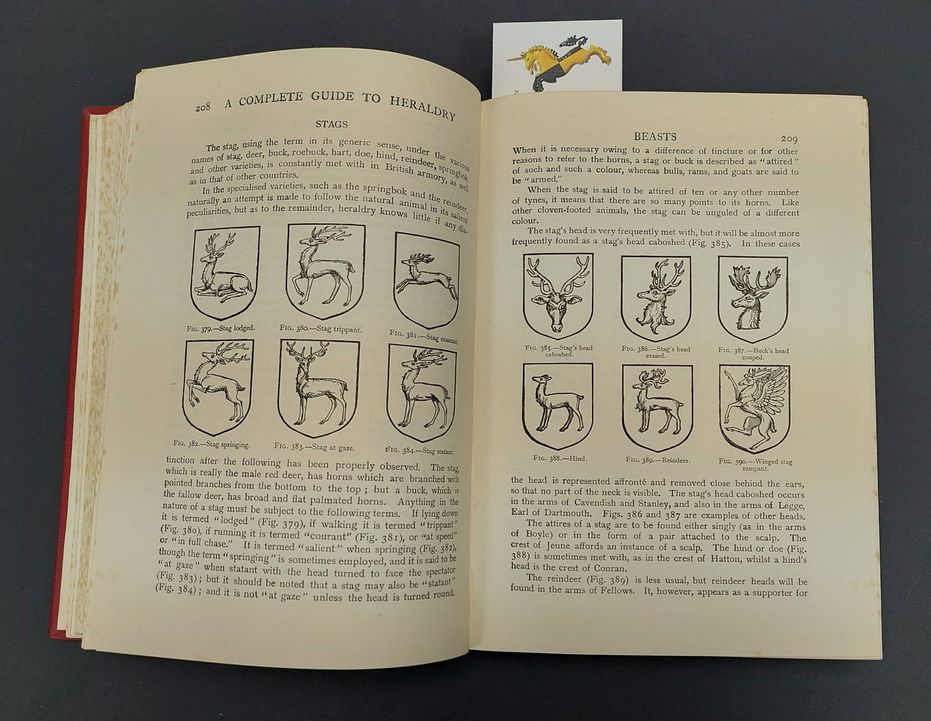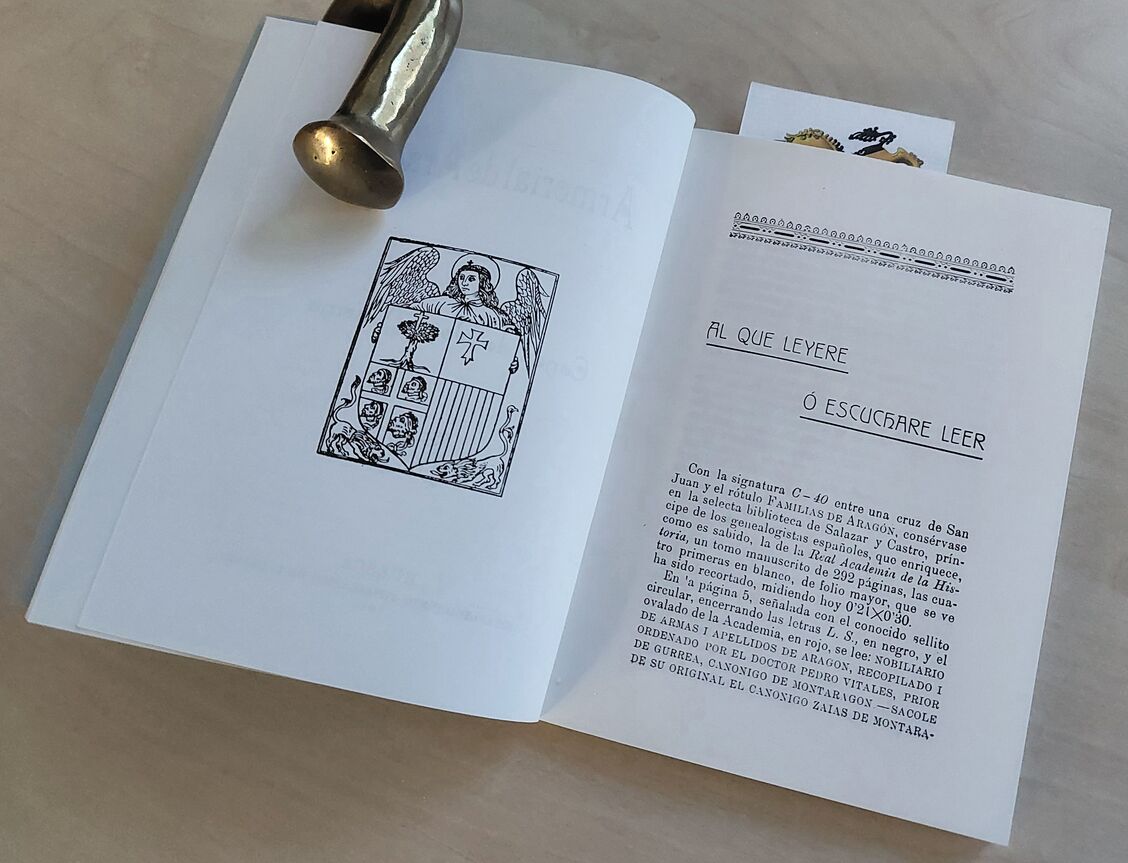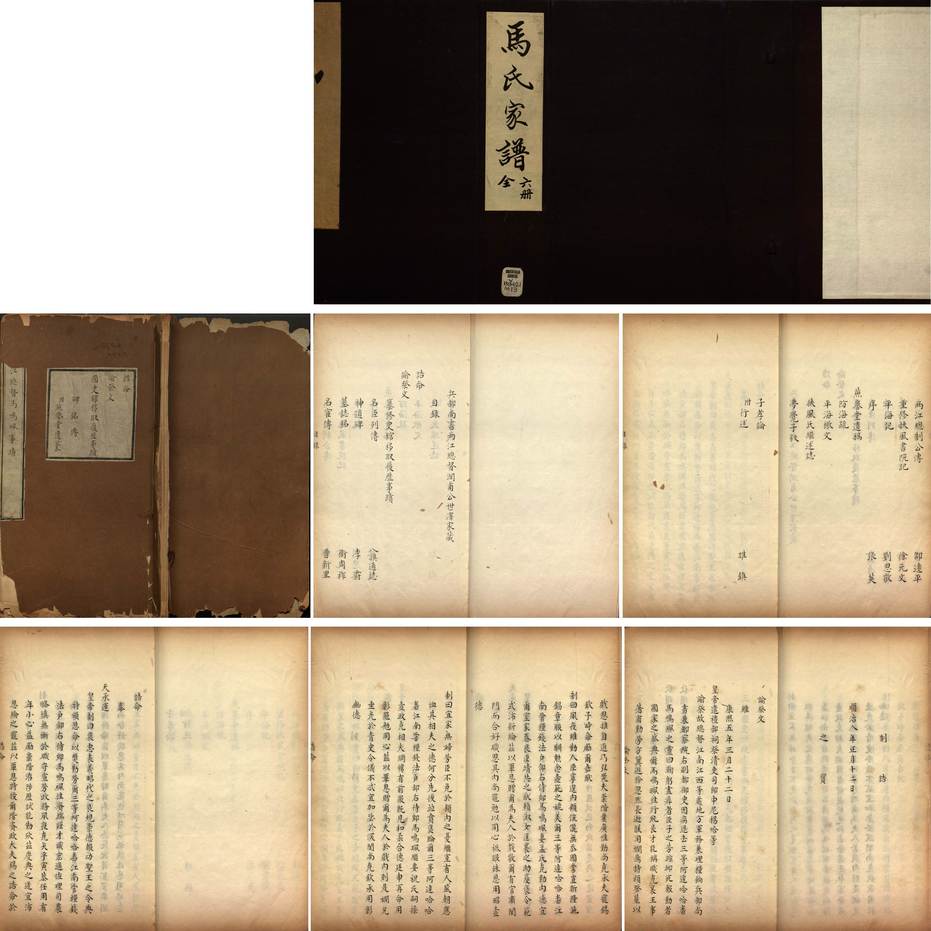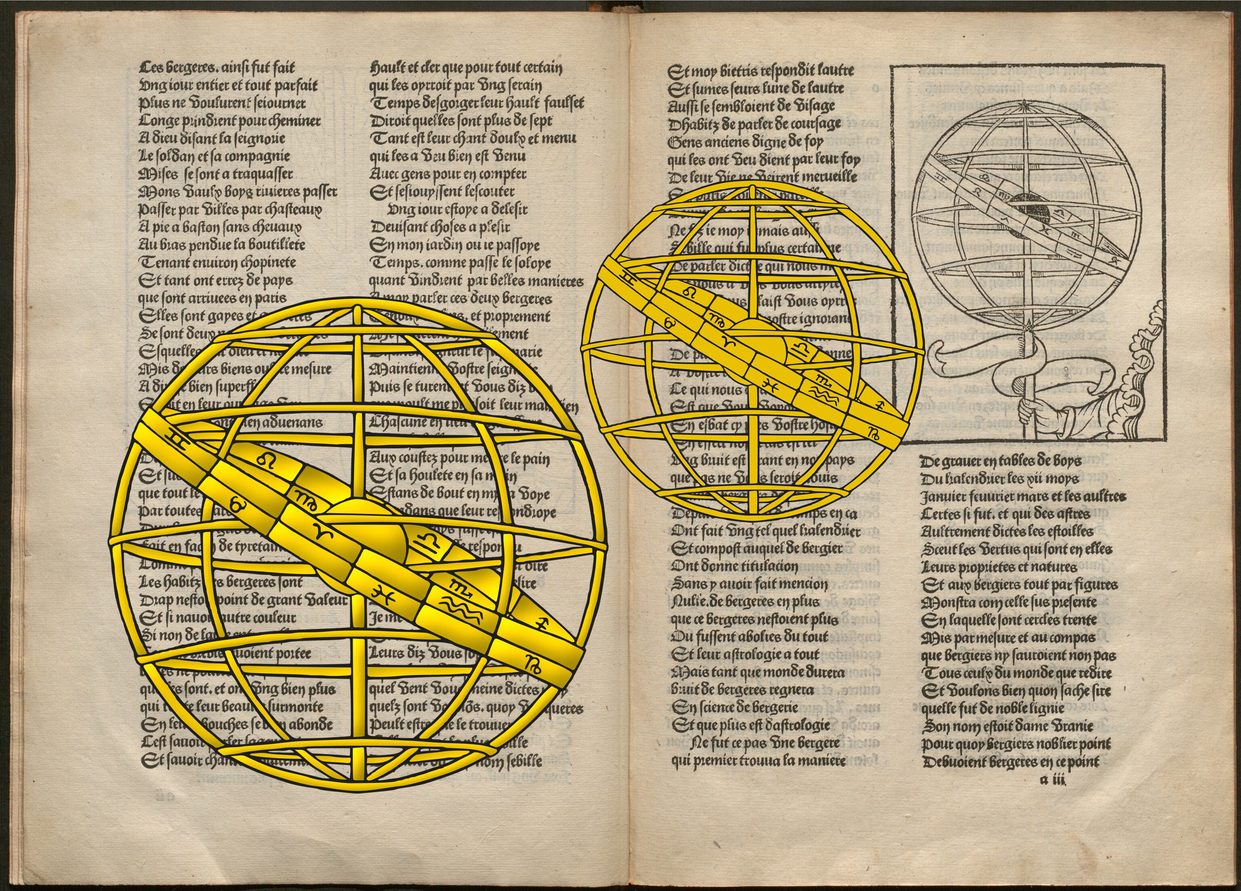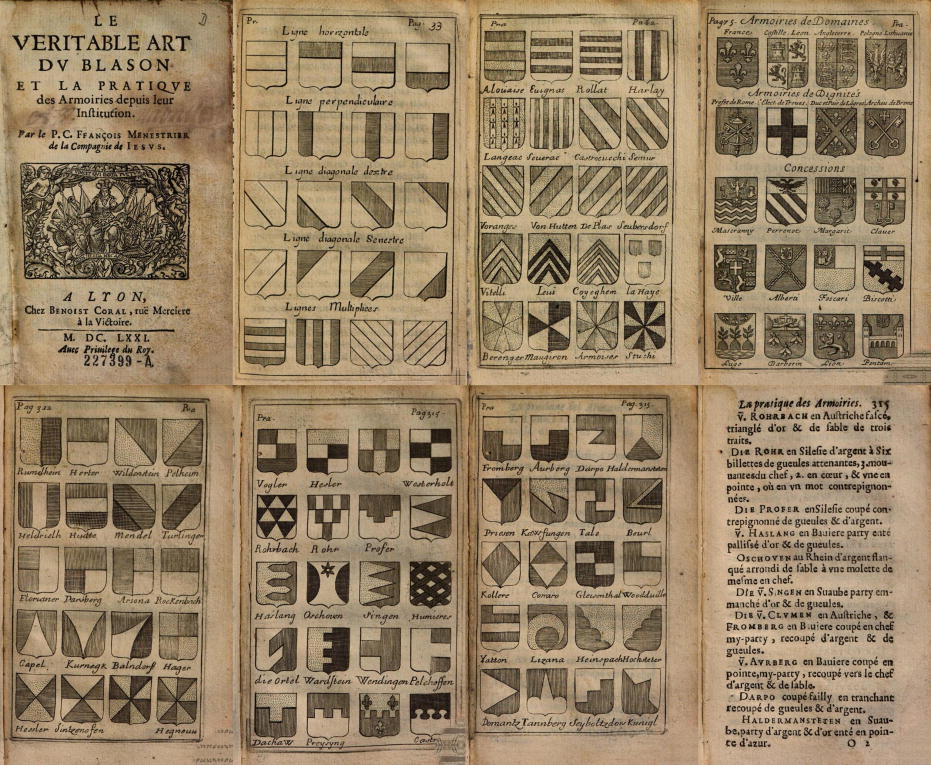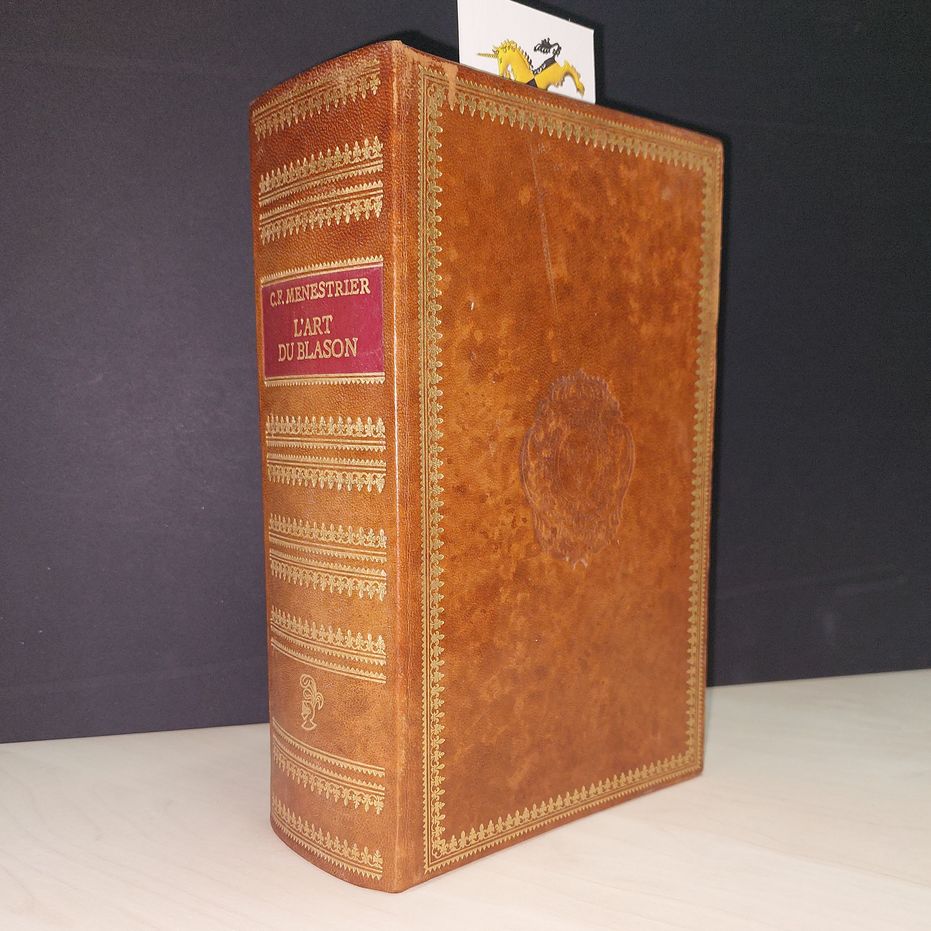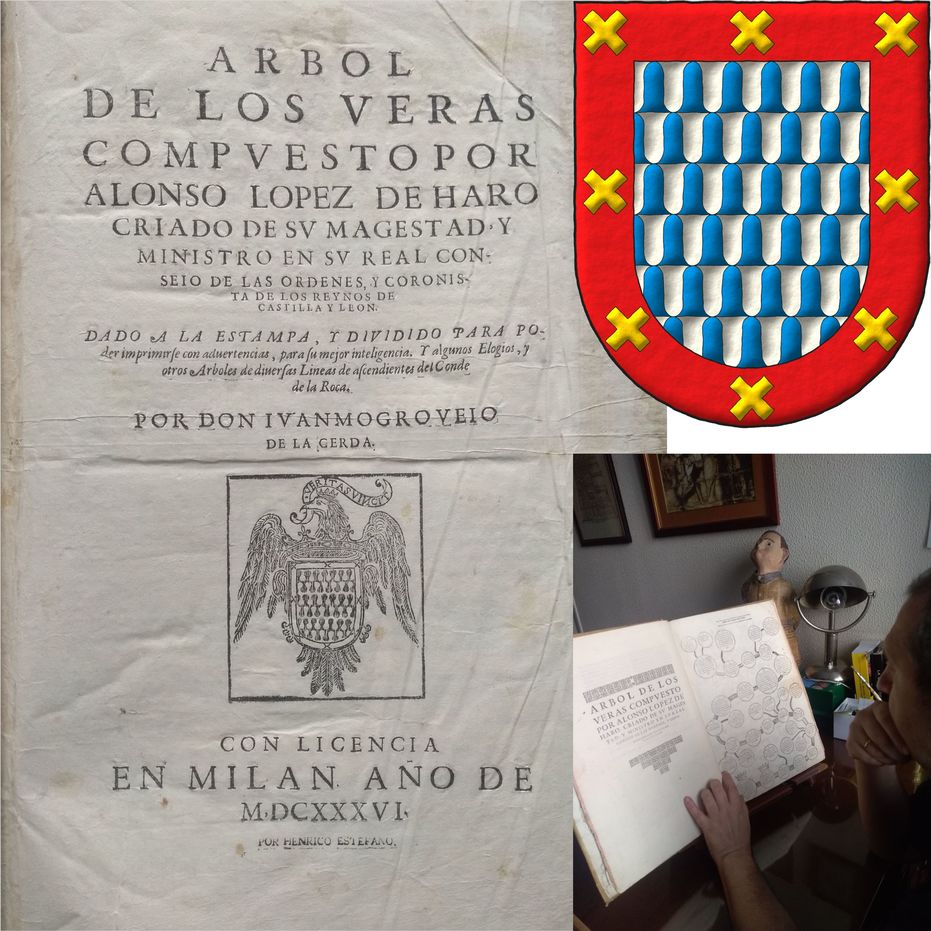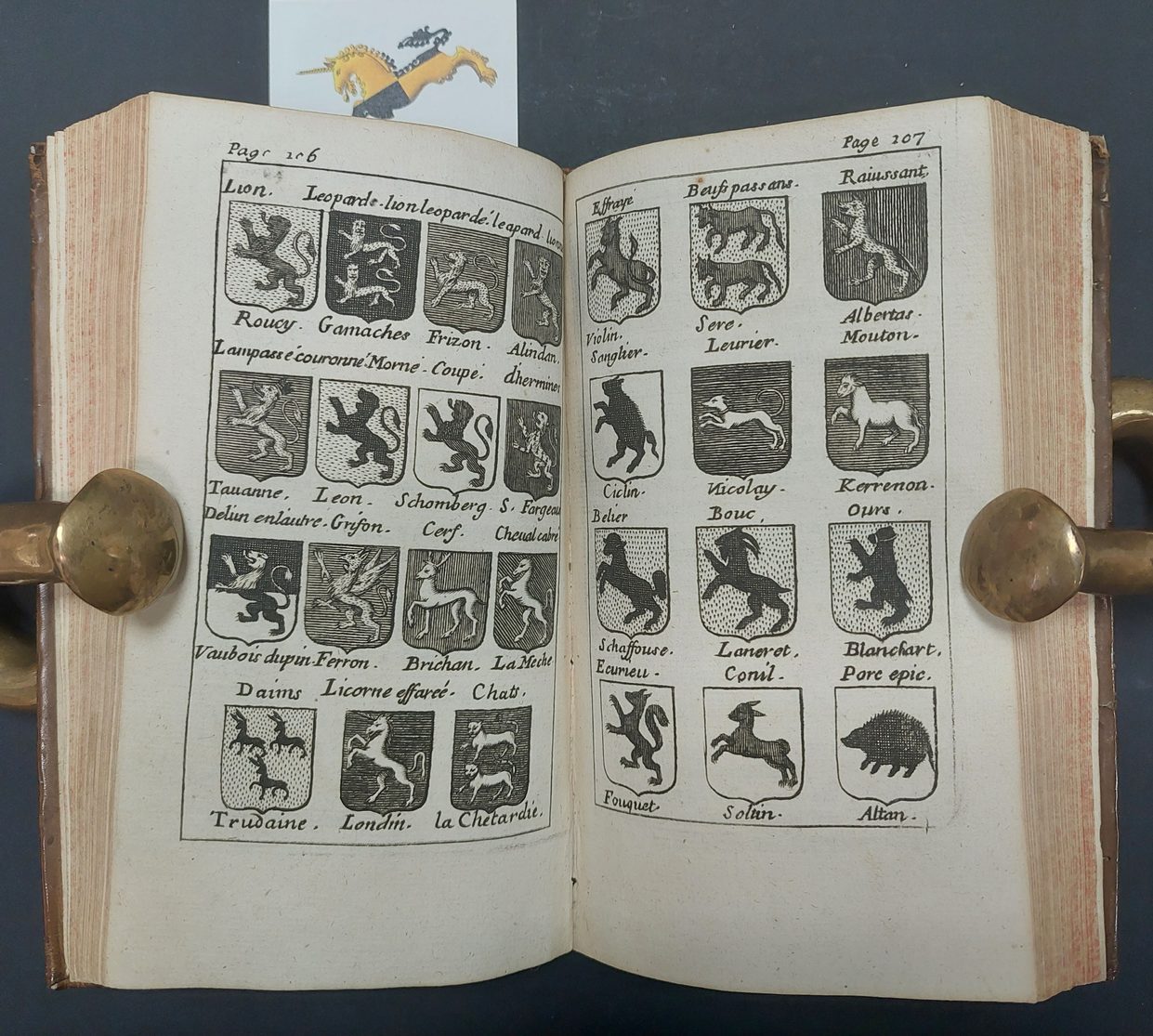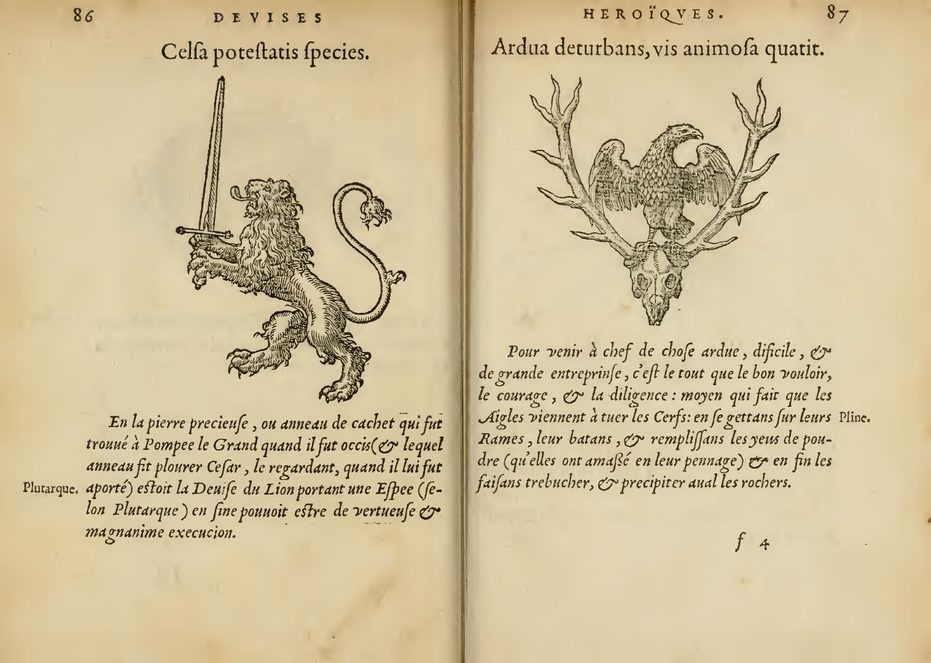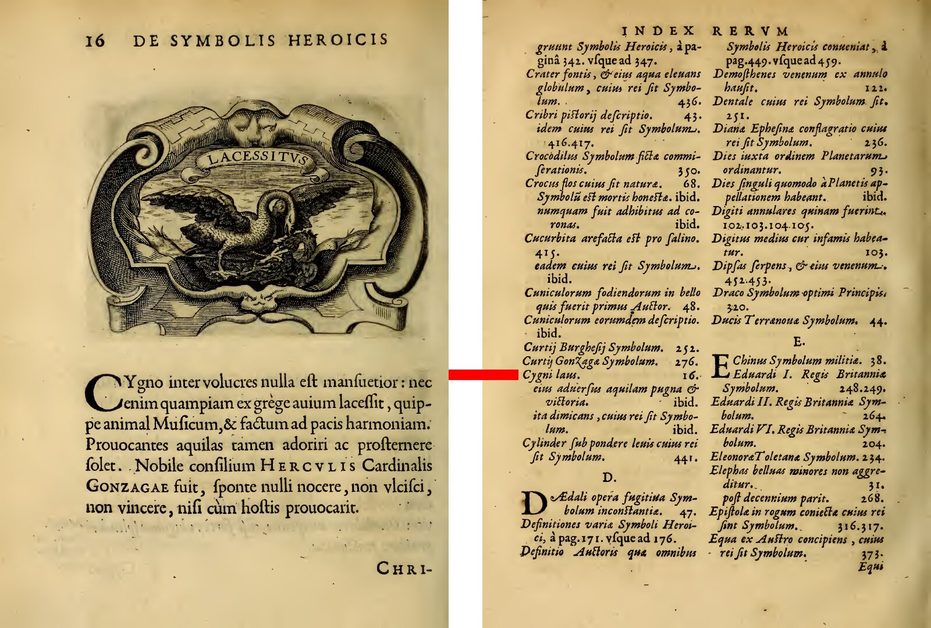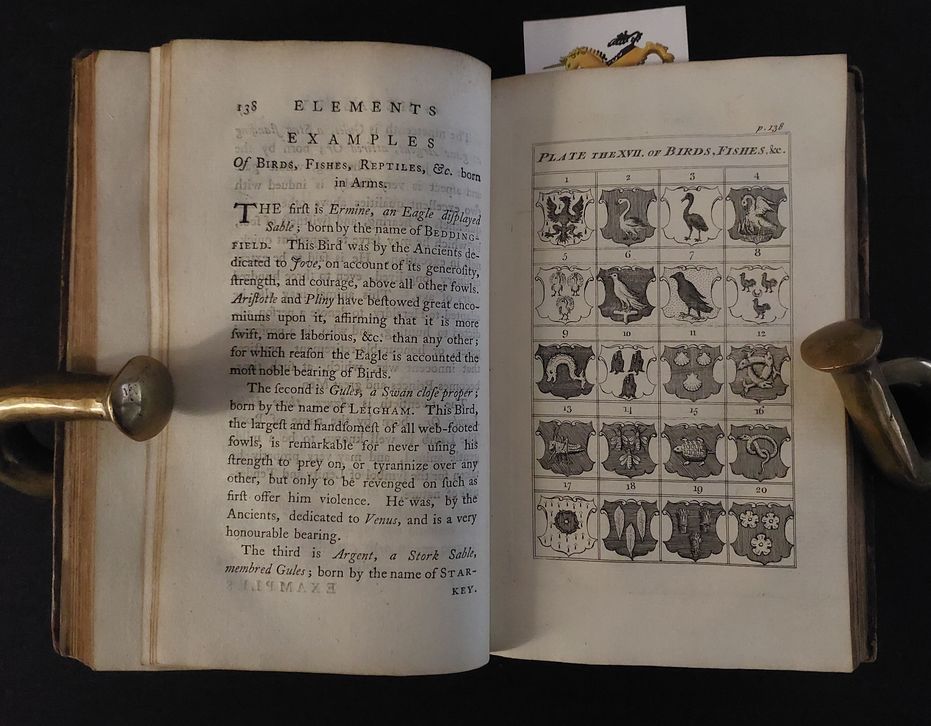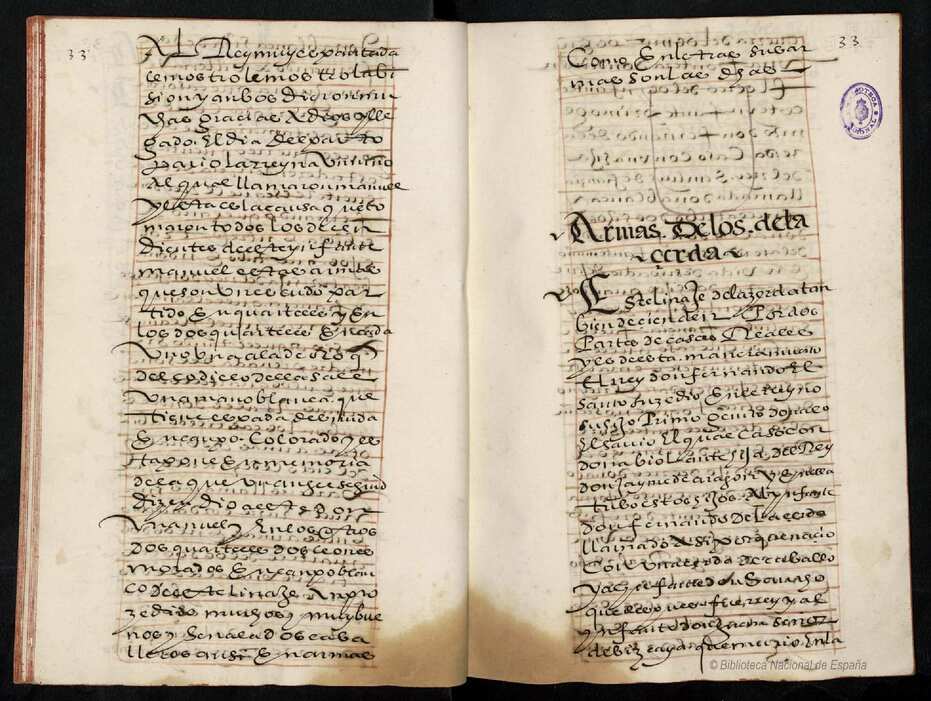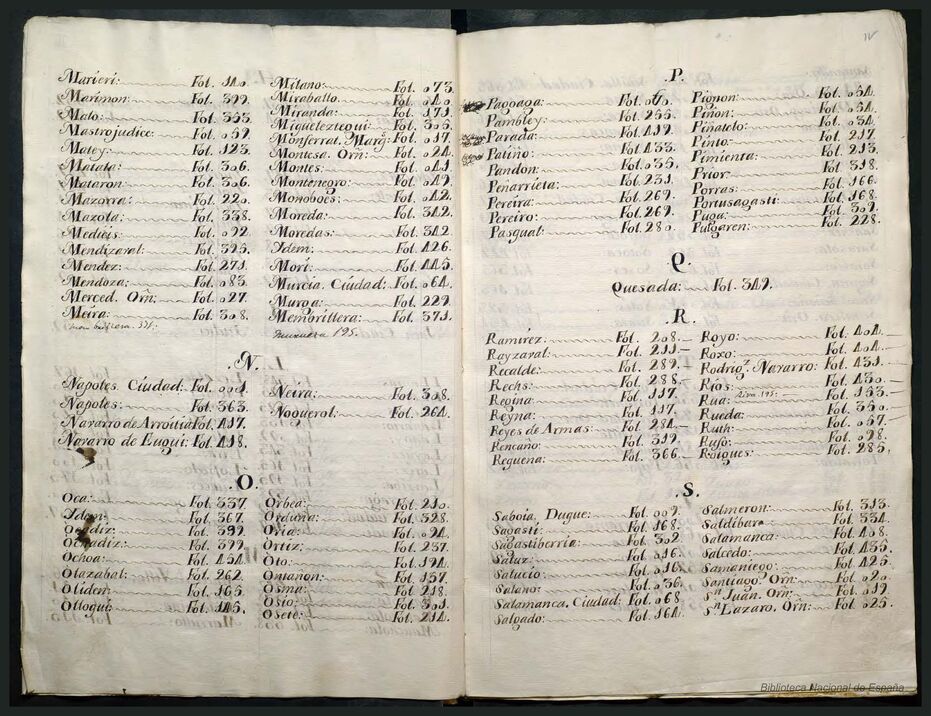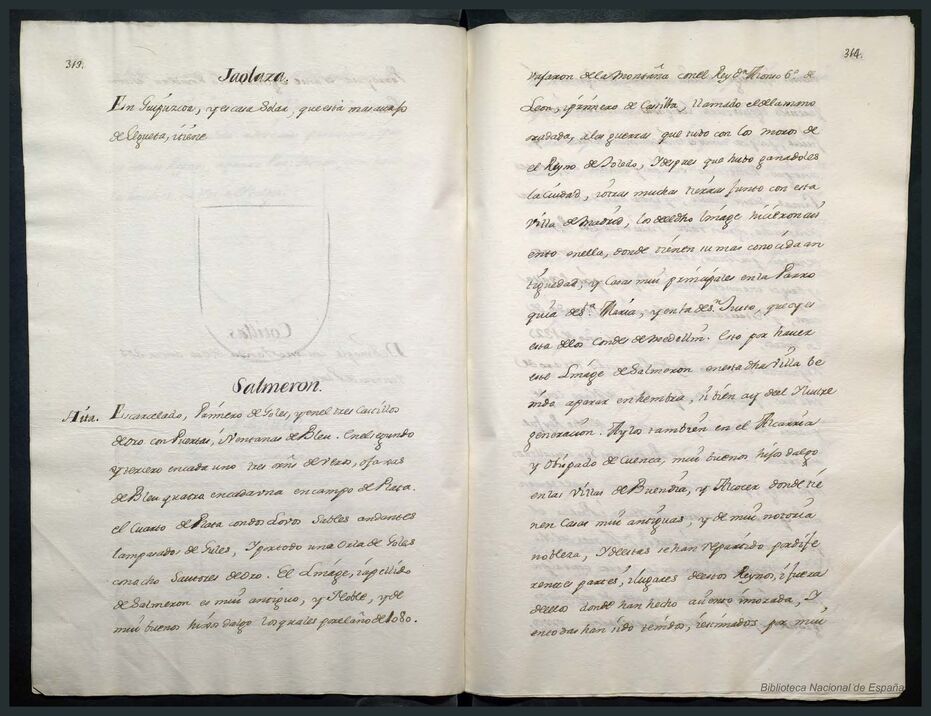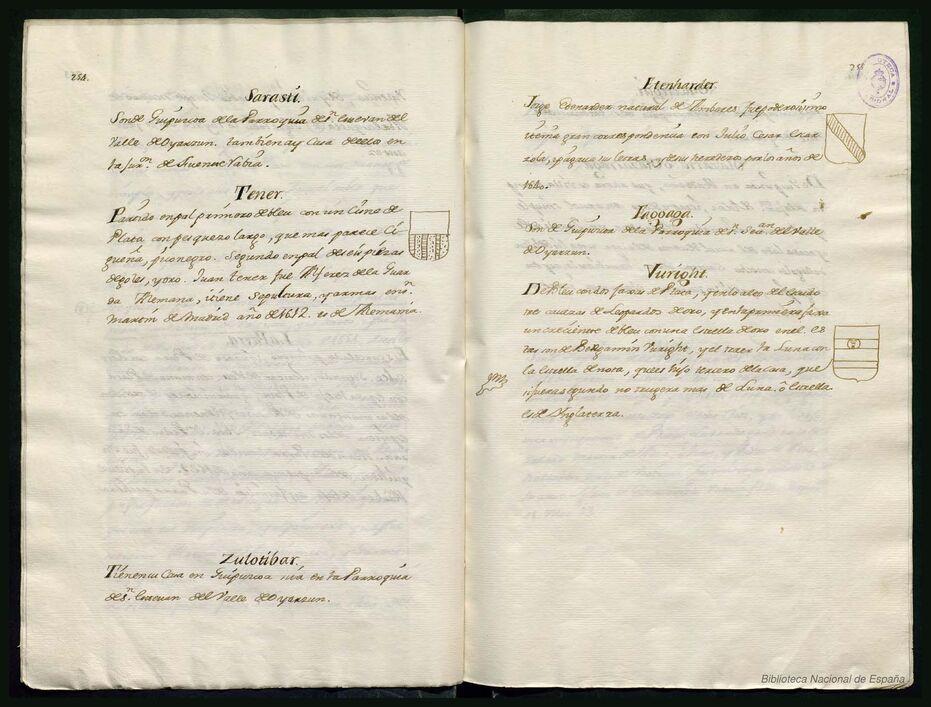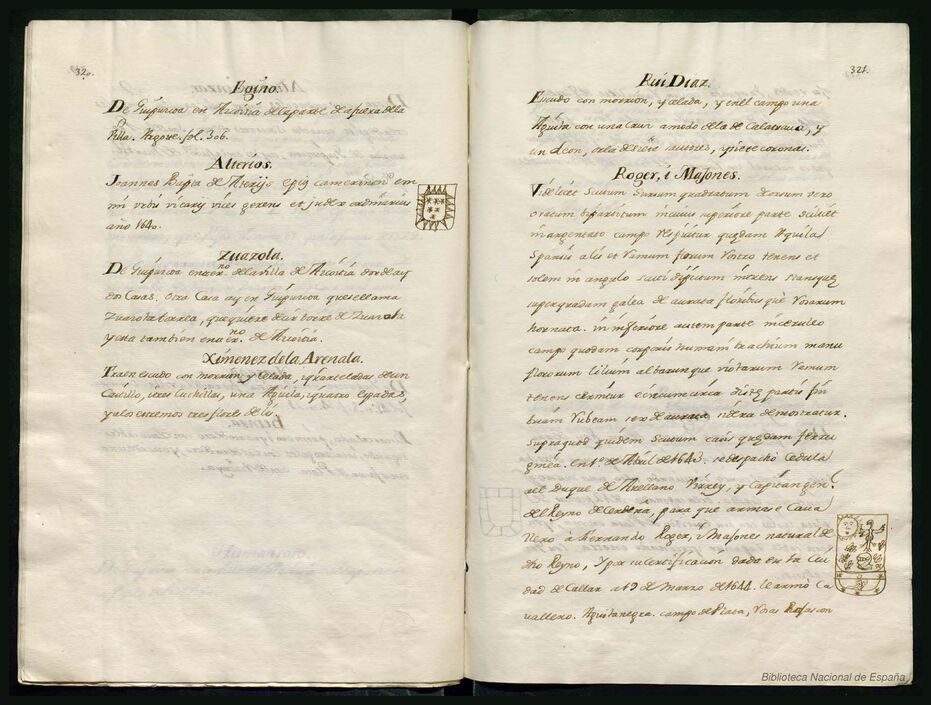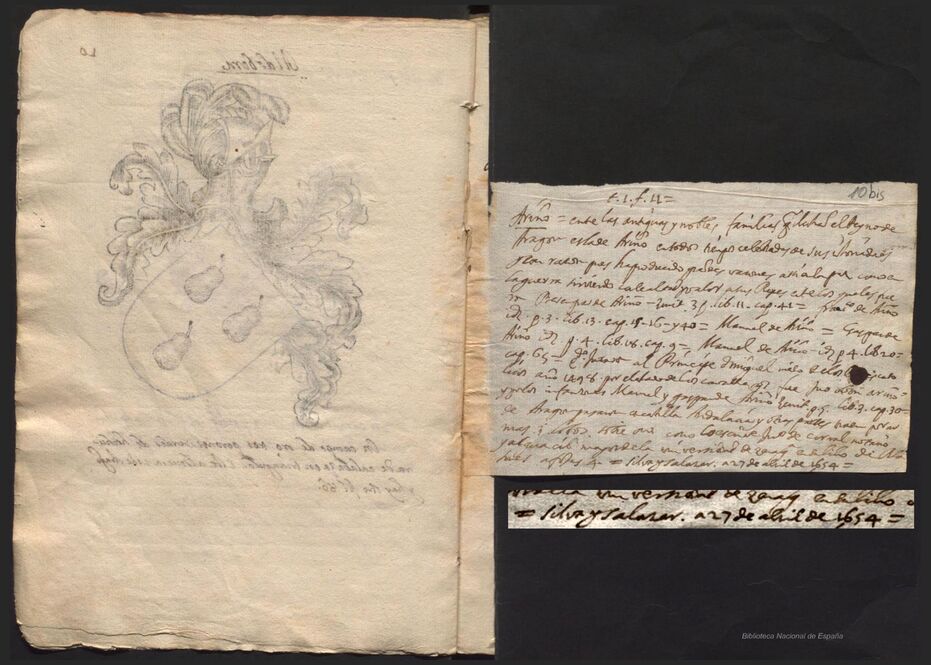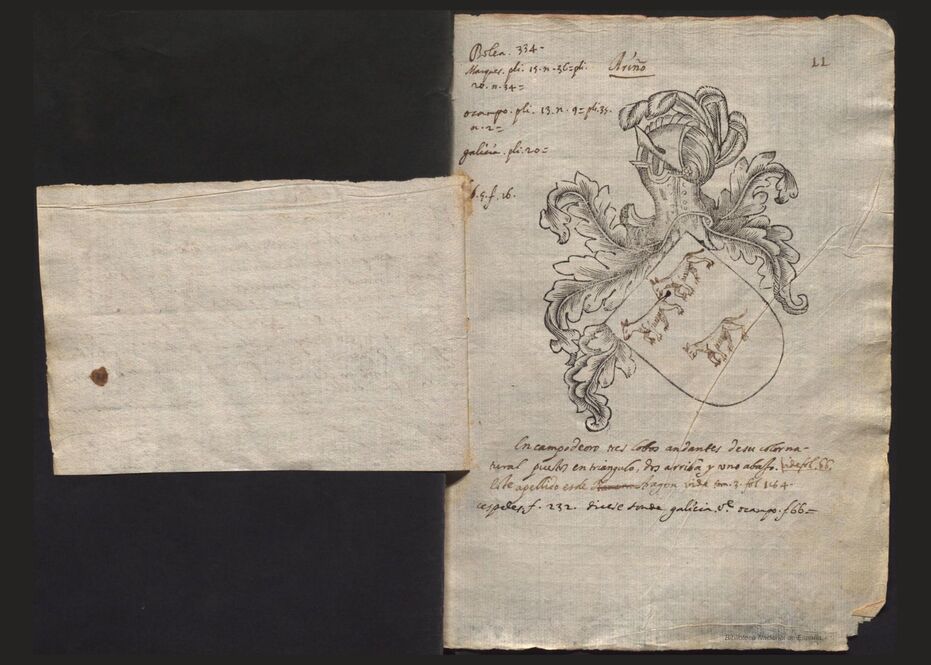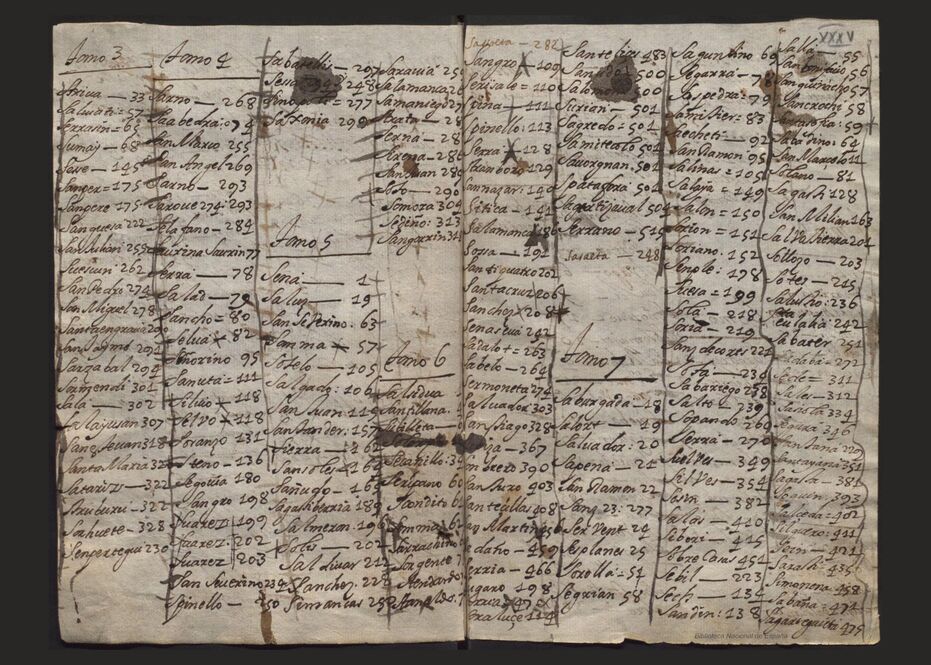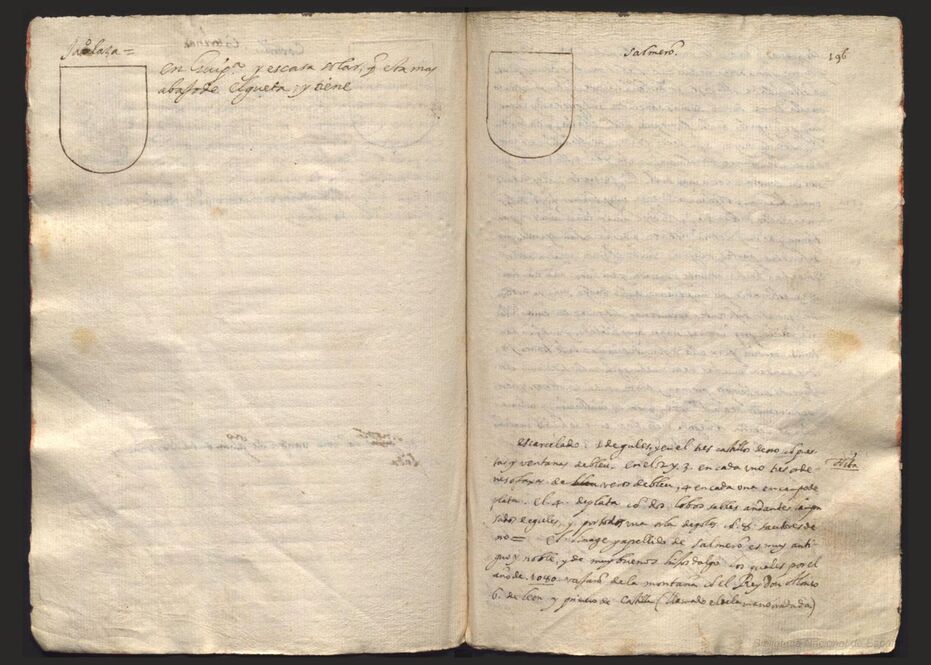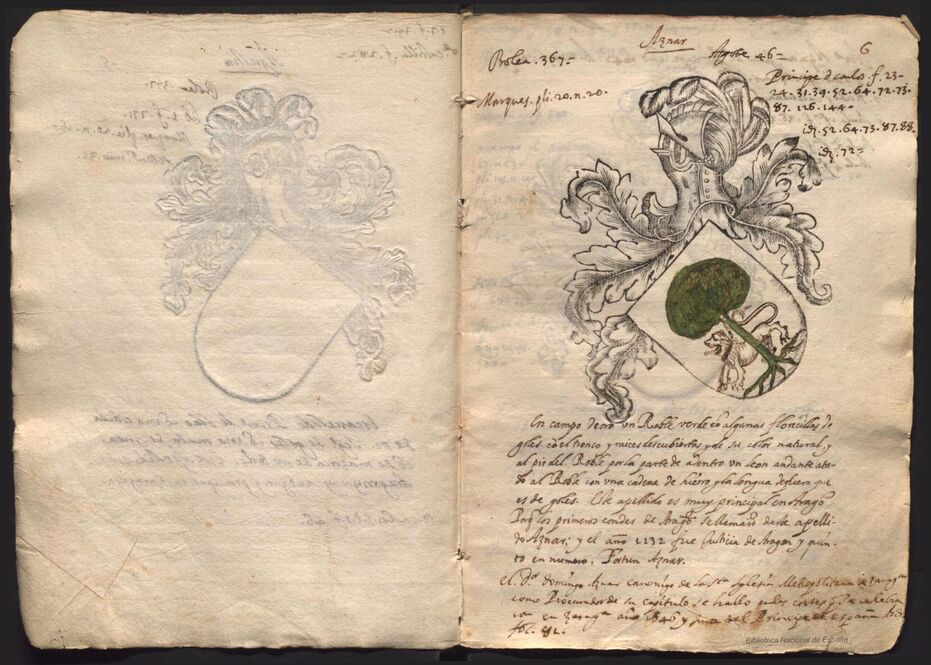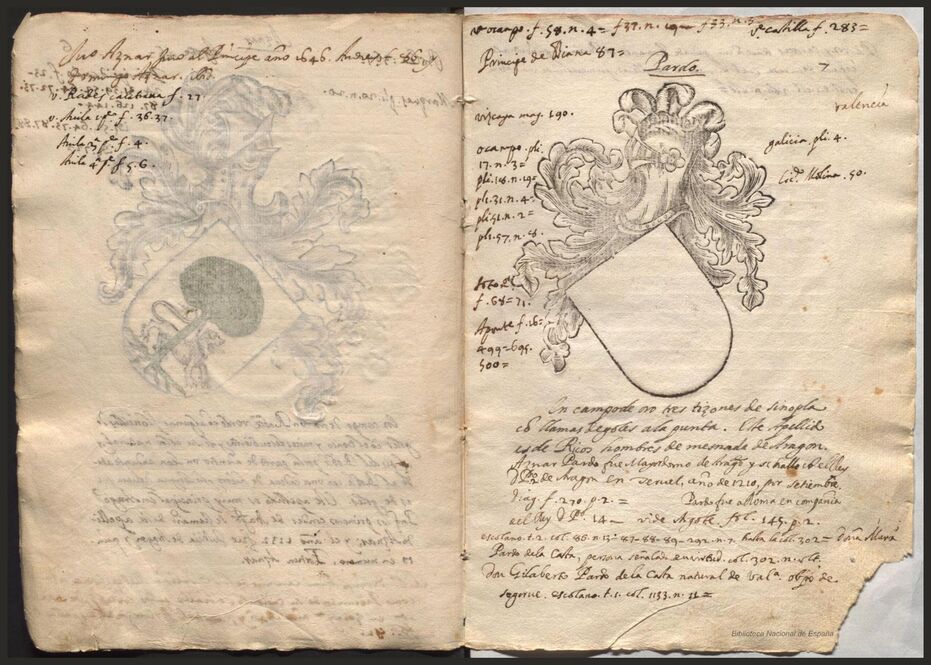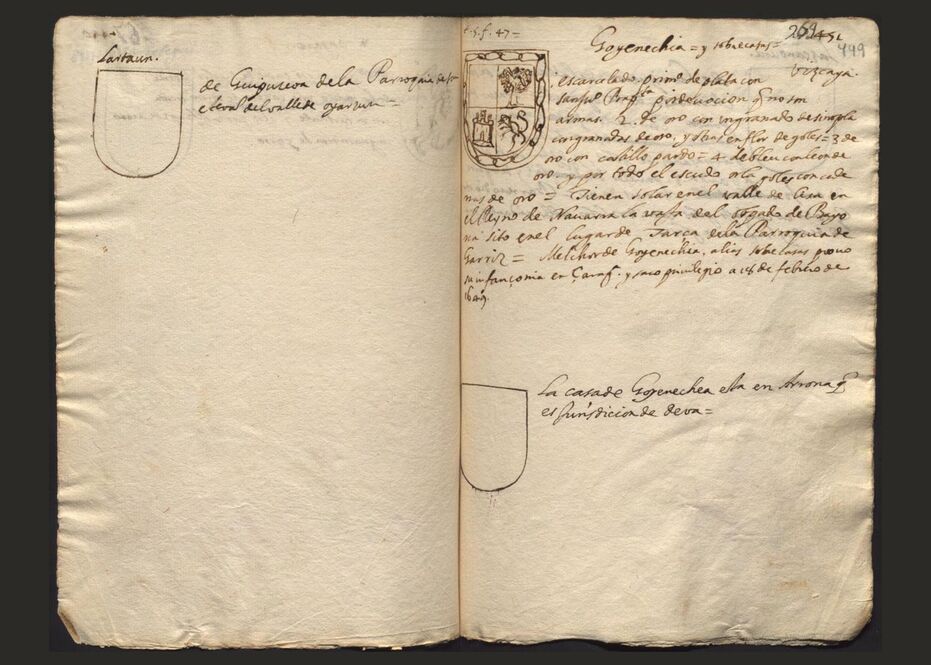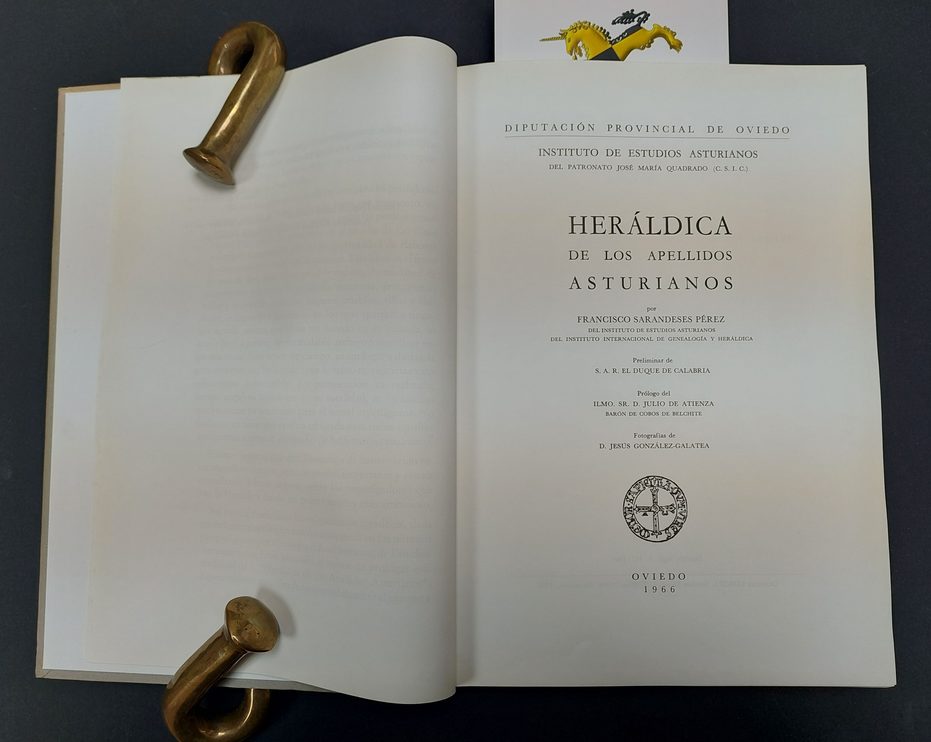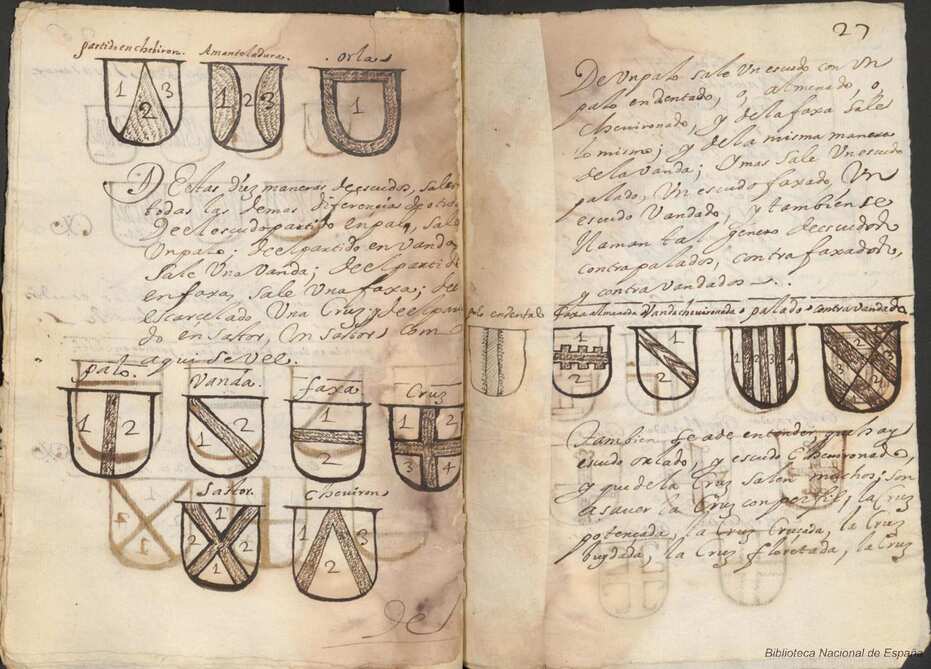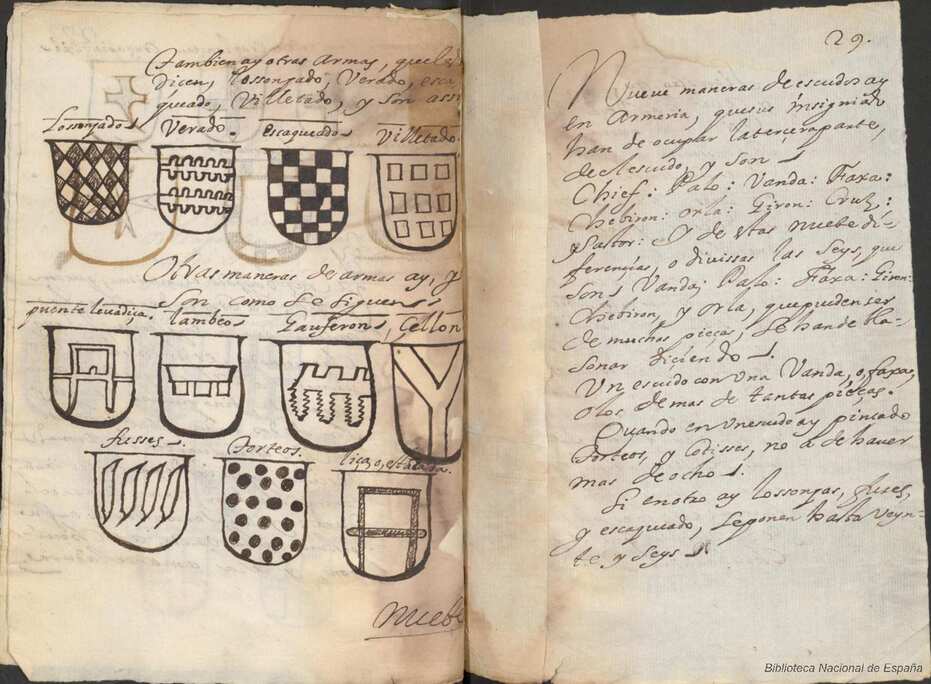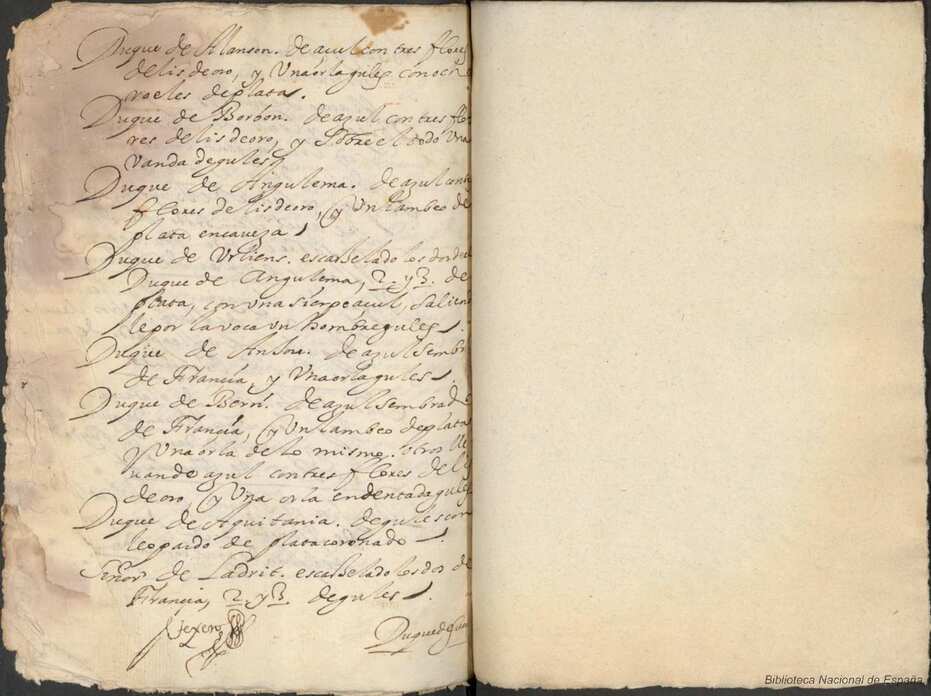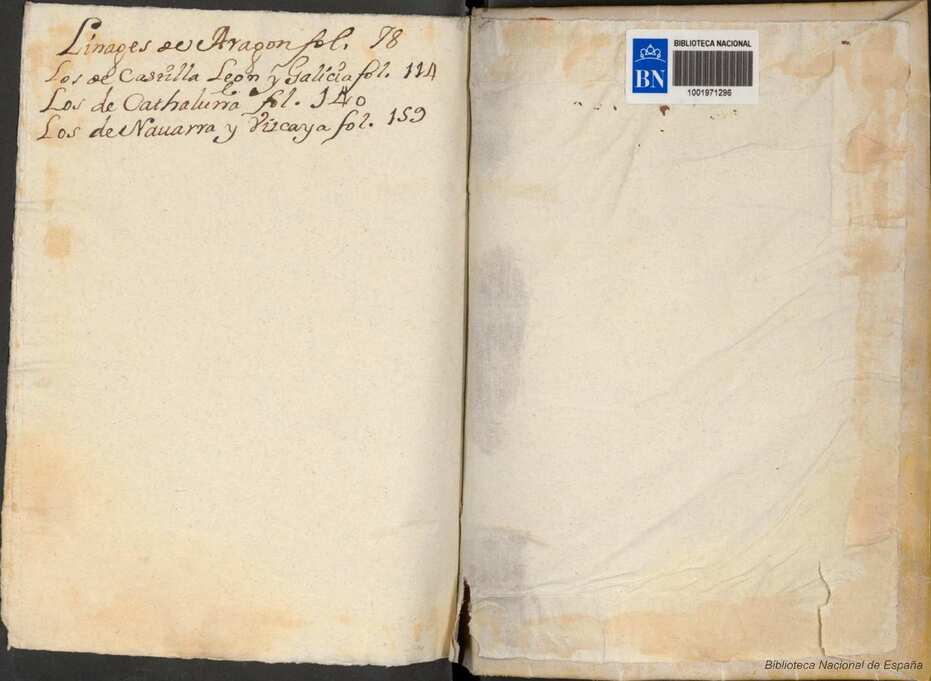In black and white


![Ver [Anonymous; 1800a] en referencias bibliográficas. Libro abierto, hojas de plata, filo de oro, guardas de gules, tapas de sable.](../css/Libro.Bibliografia.png)
Anonymous; 1800a
Anonymous, «Armerías de España», 124 double pages, title in the page 9, provenance Duke of Osuna and Infantado, 1800.
Content
The book has no index and its content, written by hand, is as follows:
- Pages 1 through 8 are blank.
- On page 9, title, the letter A begins and surnames Abarca, Abendaño, Abeo, Ablitas and Abrego in large handwritten and the blazon in small handwritten (except for the end of the book on page 123, the unknown author seems to write more about surnames than about lineages).
- On page 10, the surnames with the letter A continue and their blazon both in small handwritten.
- On page 23, the letter B begins, its surnames and their blazons, for example, the Barrasas, in the page 25, «Or, six Lions proper, combatant».
- On page 30, the letter C begins, it is followed by the letter Z on page 42, 29 surnames with Z was written before the letter D and Cocas and Cuacas, with the letter C, are inserted inside the letter Z.
- It follows in alphabetical order of surnames from page 46, where the letter D begins, to page 97 with the letter S, including in the S the surname Sánchez on page 99, as a lineage will be included at the end of the book, and it follows with the letter S until the page 104.
- On page 105 the letter T begins, surname Tabixas, Taboadas, Tafuxes, ...
- On page 109 jump from the letter T to the letter V, with the surnames Vacas, Vadillos,... and skipping the letter U.
- On page 119, it returns from letter V to U, in an unordered manner and without including the title with the capital letter U.
- On page 120, begins the letter X and also the letter Y.
- On page 122, the letter Z and only 3 additional surnames with Z, recall that the majority of the surnames with Z were included after the letter C.
- On page 123 he returns to the surname Sánchez by testimony of Pedro de Soto owner of the books of Armory of Spain of Andreas Heredia, King of Arms, and finally the unknown author copies the text for the surname Sánchez, those who were «hijosdalgos, en Cangas de Gobadonga» ~ Covadonga of Asturias and ends with a poem of 8 verses. Andreas Heredia, also known as Andrés Heredia, was King of Arms during the reign of Philip III of Spain, [Nieto y Cortadellas, R.; 1957a; Page 4]
- Beginning on page 124 are blank.
Bibliographical reference of century XVIII.
Classification: Manuscript, Armorial roll, In black and white and Castilian language.
Author: unknown.
Bibliographical reference mentioned in the following article:
External links:
- Detail of this Armorial in the National Library of Spain.
- Bibliographic record of the National Library of Spain.
- Scanned Armorial in the National Library of Spain.
Internal resources: Osuna1800.ArmeriaEspaña.Manuscrito.pdf.


![Ver [Arco y García, F. del; 1996a] en referencias bibliográficas. Libro abierto, hojas de plata, filo de oro, guardas de gules, tapas de sable.](../css/Libro.Bibliografia.png)
Arco y García, F. del; 1996a
Fernando del Arco y García, «Introducción a la Heráldica», 142 pages, Collection Burgundy Pursuivant, edited by Prensa y Ediciones Iberoamericanas SL, printed by Gráficas Joma, Legal deposit M-5240, ISBN 84-86568-64-1, Madrid, 22nd of february of 1996.
In the image, you can see two pages of this book regarding his criteria on the war cry, the motto, and the legend. These criteria do not align with mine, as I follow [Sevilla Gómez, A.; 2000] and describe in Lema, divisa, mote y grito de guerra.
Bibliographical reference of century XX.
Classification: De bibliotheca, In black and white and Castilian language.
Author: Arco y García, Fernando del.
The following article cites this bibliographic reference:
Internal resources: Physical book on paper.


![Ver [Arco y García, F. del; 1996b] en referencias bibliográficas. Libro abierto, hojas de plata, filo de oro, guardas de gules, tapas de sable.](../css/Libro.Bibliografia.png)
Arco y García, F. del; 1996b
Fernando del Arco y García, «Método de blasonar», 75 pages, Perseverant Burgundy Collection, edited by Ateneist Group of Vexilological, Heraldic and Genealogical Studies, printed by Gráficas Joma, Legal deposit M. M-5240, ISBN 84-606-2768-3, Madrid, 1996.
Bibliographical reference of century XX.
Classification: De bibliotheca, In black and white and Castilian language.
The author is Arco y García, Fernando del.
Bibliographical reference mentioned in the following article:
Internal resources: Physical book on paper.


![Ver [Argote de Molina, G.; 1588] en referencias bibliográficas. Libro abierto, hojas de plata, filo de oro, guardas de gules, tapas de sable.](../css/Libro.Bibliografia.png)
Argote de Molina, G.; 1588
Gonzalo Argote de Molina, «Nobleza de Andalucía», dedicated to King Philip II of Spain, with about 500 coat of arms engraved, printed by Fernando Díaz, Seville, 1588.
There are other editions, for example, the edition by Francisco López Vizcaíno, 799 pages, Jaen, 1867, or facsimile edition by Riquelme y Vargas Ediciones SL, Jaén, 1991, my copy is the number 1268.
Bibliographical reference of century XVI.
Classification: De bibliotheca, Castilian language and In black and white.
The author is Argote de Molina, Gonzalo.
The following articles cite this bibliographic reference:
- Alfonso IX of Leon
- Alfonso VIII of Castile
- Argote de Molina, Gonzalo
- James I of Aragon
- Álvaro de Zúñiga y Guzmán
External links:
- Virtual Library of Andalusia, 1867.
- Digital Library Madrid's memory, 1588 edition from page 6 missing cover and initial pages.
- National Library of Spain, bibliographic record, there are 2 copies of the edición of 1588.
- National Library of Spain, edition of 1588, cover of the first copy.
- National Library of Spain, edition of 1588, cover of the second copy, this has more resolution than the previous copy.
- Google Books, the second book and not complete.
Internal resources: ArgoteMolinaG1588.22.NoblezaAndalucia.Madrid.pdf is the edition of the year 1588 in PDF digital format, ArgoteMolinaG1588.23.Bne.Baja.resolucion.R10805.pdf is the edition of the year 1588 in PDF digital format and low resolution, ArgoteMolinaG1588.24.Bne.Alta.resolucion.R26842.pdf is the edition of the year 1588 in PDF digital format and hight resolution, ArgoteMolinaG1588.25.NoblezaAndalucia.1867.pdf is the edition of the year 1866 in PDF digital format for Adobe Reader only and a facsimile edition as a physical book on paper.


![Ver [Atienza y Navajas, J. de; 1959] en referencias bibliográficas. Libro abierto, hojas de plata, filo de oro, guardas de gules, tapas de sable.](../css/Libro.Bibliografia.png)
Atienza y Navajas, J. de; 1959
Julio de Atienza y Navajas, Baron of the Cobos de Belchite, «Nobiliario Español: Diccionario Heráldico de Apellidos y Títulos», 1st edition, edited by Aguilar, 1,712 pages, 2 volumes, Madrid, 1959.
It is a monumental work that includes a heraldic dictionary and blazons of Spanish lineages and noble titles, along with the history and genealogy of thousands of Spanish families.
Bibliographical reference of century XX.
Classification: Castilian language, In black and white and De bibliotheca.
Author: Atienza y Navajas, Julio de.
The following article cites this bibliographic reference:
Internal resources: Physical book on paper, 2 volumes.


![Ver [Avilés, J.; 1725a] en referencias bibliográficas. Libro abierto, hojas de plata, filo de oro, guardas de gules, tapas de sable.](../css/Libro.Bibliografia.png)
Avilés, J.; 1725a
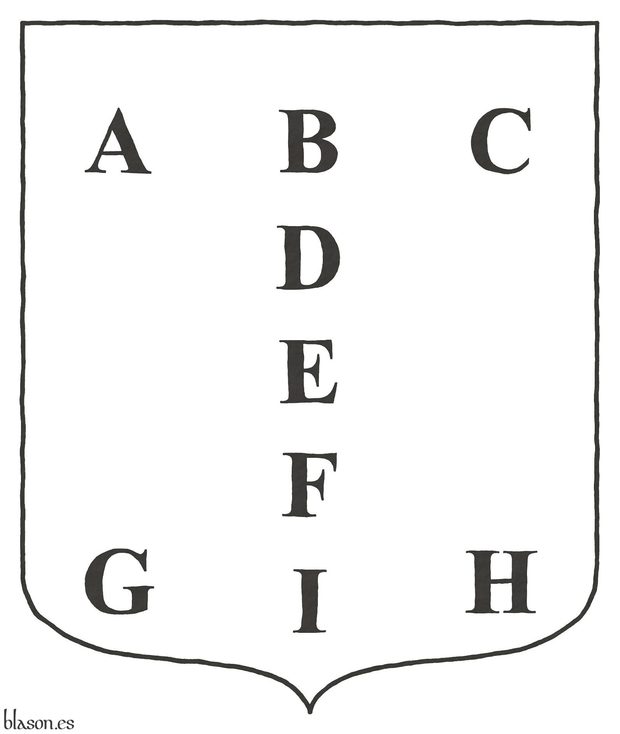
José de Avilés e Iturbide, Marquis of Aviles, member of the Supreme Council of War, «Ciencia heroyca, reducida a las leyes heráldicas del blasón: Ilustrada con exemplares de todas las piezas, figuras y ornamentos de que puede componerse un escudo de armas interior y exteriormente, Volume I», dedicated to Juan Bautista de Orendyn of His Majesty's Council, printed by Juan Piferrer of the Ángel's Square, 530 pages, Barcelona, 1725.
I also usually consult Volume I of the edition [Avilés, J.; 1780a].
Contents of Volume One
- Cover page.
- Dedication.
- Censor's review from 1724.
- Approval.
- To the reader.
- Epigram.
- Summary of privileges.
- Summary of the price.
- Plate index.
- Warnings.
- Errata sheet for each of the treatises.
- Additions.
- Table of the treatises.
- 378 pages for its 4 treatises: Treatise I with 3 chapters and a dictionary, Treatise II with 3 chapters, Treatise III with 3 chapters, and Treatise IV with 4 chapters.
- 34 plates with more than 650 coats of arms arranged at the end of each treatise, as follows: Plates 1 to 16 at the end of Treatise I, Plates 17 to 19 at the end of Treatise II, Plate 20 at the end of Treatise III, and Plates 21 to 34 at the end of Treatise IV.
- Index of terms, words, and figures specific to blazonry.
- Index of cities, titles, and families with coats of arms blazoned in this second volume.
Bordure compony
Bibliographical reference of century XVIII.
Classification: De bibliotheca, In black and white and Castilian language.
Author: Avilés e Iturbide, José.
The following articles cite this bibliographic reference:
- Adrian V
- Baudry in France
- Bourgeois, lineage of Burgundy
- Criteria used by its title
- Dancetty, ratio, points and blazon
- Edmund Plantagenet
- Enrique Fernández Marqués, two supporters
- Ferdinand II of Leon
- Flanched, schemaat one-fifth
- Hector of Troy
- Hector of Troy, Sable
- Hufflepuff House with 2 badgers
- Innocent IV
- Leonor de Aquitania
- Navarre
- Nhf, Norsk Heraldisk Forening
- Oschoven of the Rhin
- Pile issuant from the base in the Dictionary of the Spanish Language
- Richard I of England
- The Heraldry Society of Scotland
- Triangulation 1, contre-embrassés, chapé, embrassé, and chaussé
- Triangulation 2, chaussé, contre-embrassé, embrassé, and chapé
- Triangulation 6, embrassé, chaussé, chapé, and contre-embrassé
- Triangulation 7, chaussé, contre-embrassé, embrassé, and chapé
External resources:
- Valencian Digital Library, records for the Volumes I and II.
- Valencian Digital Library, content of Volume I.
Internal resources: AvilesJ1725.Tomo.I.pdf.


![Ver [Avilés, J.; 1725b] en referencias bibliográficas. Libro abierto, hojas de plata, filo de oro, guardas de gules, tapas de sable.](../css/Libro.Bibliografia.png)
Avilés, J.; 1725b
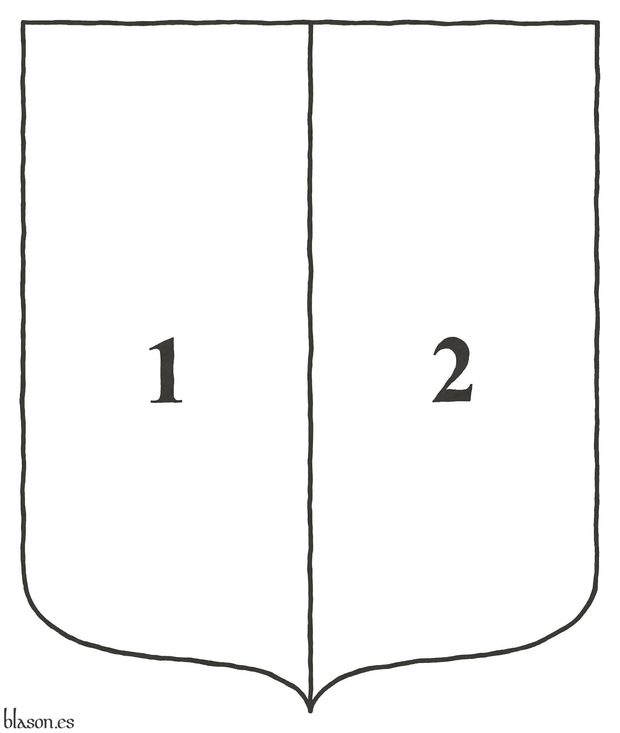
José de Avilés e Iturbide, Marquis of Aviles, member of the Supreme Council of War, «Ciencia heroyca, reducida a las leyes heráldicas del blasón: Ilustrada con exemplares de todas las piezas, figuras y ornamentos de que puede componerse un escudo de armas interior y exteriormente, Volume II», dedicated to Juan Bautista de Orendyn (Juan Bautista de Orendáin y Azpilicueta) of His Majesty's Council, printed by Juan Piferrer of the Ángel's Square, 404 pages, Barcelona, 1725.
I also usually consult Volume I of the edition [Avilés, J.; 1780b].
Contents of Volume Two
- Cover page.
- To the reader.
- Errata sheet for each of the treatises.
- Summary of the price.
- Table of the treatises.
- Plate index.
- Warnings.
- 319 pages for its 4 treatises: Treatise I with 6 chapters, Treatise II with 3 chapters, Treatise III with 4 chapters, and Treatise IV with 13 chapters.
- 25 plates with hundreds of coats of arms and illustrative figures arranged at the end of each treatise, as follows: Plates 1 to 16 at the end of Treatise I, Plates 17 to 19 at the end of Treatise II, Plates 20 to 24 at the end of Treatise III, and Plate 25 at the end of Treatise IV.
- Index of terms, words, and figures specific to blazonry.
- Index of cities, titles, and families with coats of arms blazoned in this second volume.
Crown of count
Infamed arms
Bibliographical reference of century XVIII.
Classification: De bibliotheca, In black and white and Castilian language.
Author: Avilés e Iturbide, José.
Here are the articles quoting this reference:
External resources:
- Valencian Digital Library, records for the Volumes I and II.
- Valencian Digital Library, content of Volume II.
Internal resources: AvilesJ1725.Tomo.II.pdf.


![Ver [Avilés, J.; 1780a] en referencias bibliográficas. Libro abierto, hojas de plata, filo de oro, guardas de gules, tapas de sable.](../css/Libro.Bibliografia.png)
Avilés, J.; 1780a
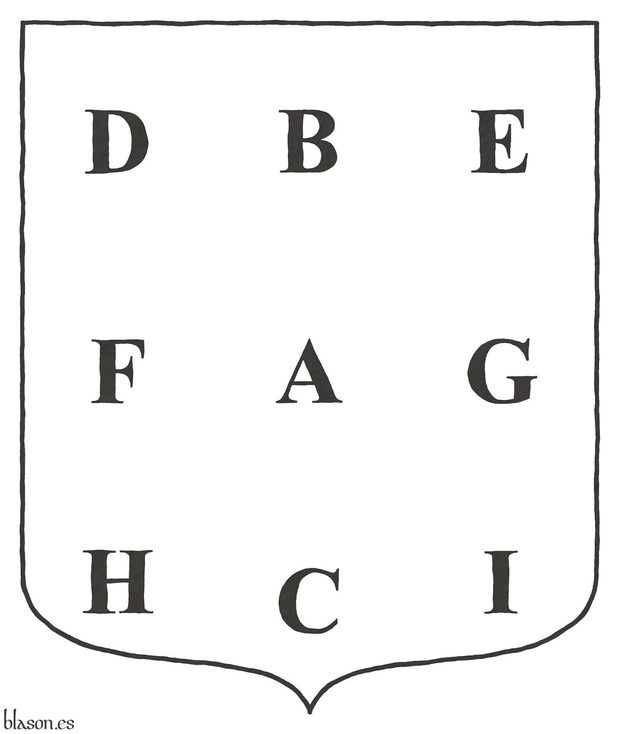
José de Avilés e Iturbide, Marquis of Aviles, member of the Supreme Council of War, «Ciencia heroyca, reducida a las leyes heráldicas del blasón: Ilustrada con exemplares de todas las piezas, figuras y ornamentos de que puede componerse un escudo de armas interior y exteriormente, Volume I», edition of Joaquín Ibarra, printer of his Majesty's Chamber, at the expense of the Company of Printers and Booksellers of the Kingdom, 526 pages, Madrid, 1780.
The first edition is [Avilés, J.; 1725a] and this edition is 14 years after the death of José de Avilés, that happened in 1766.
Page Examples
Bibliographical reference of century XVIII.
Classification: In black and white and Castilian language.
Author: Avilés e Iturbide, José.
The following articles cite this bibliographic reference:
- Adrian V
- Avilés, J.; 1725a
- Bourgeois, lineage of Burgundy
- Dancetty, ratio, points and blazon
- David B. Appleton, slipped and leaved
- Enrique Fernández Marqués, two supporters
- Ferdinand II of Leon
- Holy Trinity
- Hufflepuff House with 2 badgers
- Innocent IV
- Jesus Christ, preparation schema
- Jesus Christ, with bezants Or
- Kimon Andreou, contourné
- Kimon Andreou, eradicated
- Latidos Podencos, Azure and Argent version
- Latidos Podencos, Azure and Argent version with motto
- Latidos Podencos, seal of the animal protection organization
- Leonor de Aquitania
- Leonor de Aquitania y Enrique de Inglaterra
- Lozengy 5x6 and 6x7
- Navarra, chains Or
- Nhf, Norsk Heraldisk Forening
- Norsk Heraldisk Forening, coat of arms
- Pile issuant from the base in the Dictionary of the Spanish Language
- Ponce I of Urgell
- Royal Spanish Academy, coat of arms
- Sebastián González Montenegro en Doce Linajes
- Thomas de Warbleton
- Urgell, County of
External link:


![Ver [Avilés, J.; 1780b] en referencias bibliográficas. Libro abierto, hojas de plata, filo de oro, guardas de gules, tapas de sable.](../css/Libro.Bibliografia.png)
Avilés, J.; 1780b
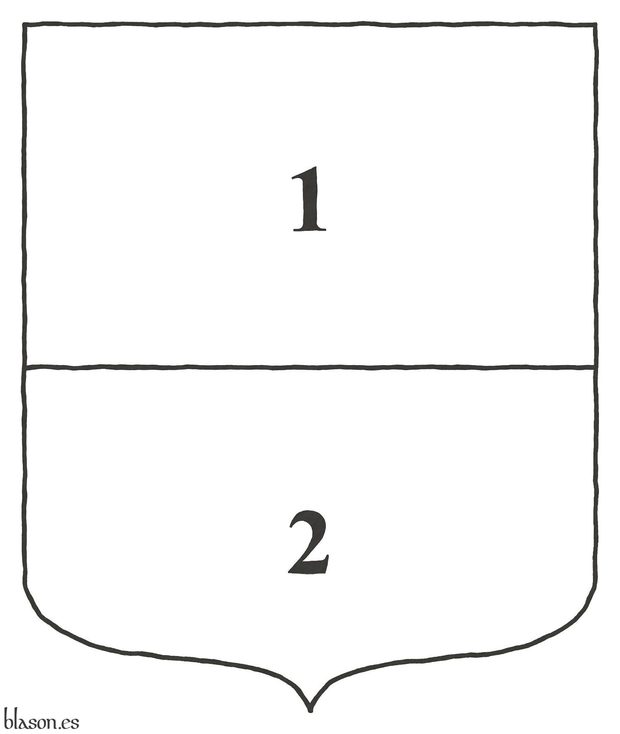
José de Avilés e Iturbide, Marquis of Aviles, member of the Supreme Council of War, «Ciencia heroyca, reducida a las leyes heráldicas del blasón: Ilustrada con exemplares de todas las piezas, figuras y ornamentos de que puede componerse un escudo de armas interior y exteriormente, Tomo II», edition of Joaquín Ibarra, printer of his Majesty's Chamber, at the expense of the Company of Printers and Booksellers of the Kingdom, 440 pages, Madrid, 1780.
The first edition is [Avilés, J.; 1725b] and this edition is 14 years after the death of José de Avilés, that happened in 1766.
Helm of squire, knight, 39, and hidalgo, 40
Bibliographical reference of century XVIII.
Classification: In black and white and Castilian language.
Author: Avilés e Iturbide, José.
Here are the articles quoting this reference:
- Alcantara, Order of
- Avilés, J.; 1725b
- Calatrava, Order of
- David B. Appleton, slipped and leaved
- Godfrey V, Count of Anjou
- Montesa, Order of
- Order of Alcantara, emblem
- Order of Calatrava, emblem
- Order of Montesa, emblem
- Order of Santiago, emblem
- Santiago, Order of
External resource:


![Ver [Bravo Guarida, C.; 1934] en referencias bibliográficas. Libro abierto, hojas de plata, filo de oro, guardas de gules, tapas de sable.](../css/Libro.Bibliografia.png)
Bravo Guarida, C.; 1934
Clemente Bravo Guarida, «El Paso Honroso de Don Suero de Quiñones: Célebre Caballero Leonés en el Puente de Órbigo, en 1434», second edition, published by «El Diario de León» to commemorate the fifth centenary of this famous feat of arms, 59 pages, printed by Imprenta Católica, León, 1934.
This edition, written by Clemente Bravo Guarida, provides an updated account of the famous «Passo Honroso», [Rodríguez de Lena, P.; Century XVI], undertaken by the renowned knight Suero de Quiñones in 1434 at the bridge of Órbigo.
The book includes the full list of the 10 maintainers on page 57, and the 68 challengers, or adventurers, on pages 67 and 68. It also reports the results of the jousts for all participants.
Please note a correction: on page 58, where it reads «Loque de la Torre, corrió 6, rompió 4» it should instead say «Lope de la Torre, corrió 6, rompió 4».
Bibliographical reference of century XX.
Classification: Castilian language and In black and white.
The author is Bravo Guarida, Clemente.
Bibliographical reference mentioned in the following article:
Internal resources: BravoGuaridaC1934.PasoHonroso.Ocr.pdf.


![Ver [Burke, B.; 1842] en referencias bibliográficas. Libro abierto, hojas de plata, filo de oro, guardas de gules, tapas de sable.](../css/Libro.Bibliografia.png)
Burke, B.; 1842
Sir Bernard Burke, C. B., LL. D., Ulster King of Arms, «The General Armory of England, Scotland, Ireland and Wales; Comprising a Registry of Armorial Bearings from the Earliest to the Present Time», Harrison, London, 1842.
Sir Bernard Burke, C. B., LL. D. (1814-1892), also cited as John Bernard Burke, was a British genealogist. He was son of the genealogist John Burke (1787–1848). In 1853, Sir Bernard Burke was appointed Ulster King of Arms.
I use to consult [Burke, B.; 1989] and [Burke, B.; 2009].
Bibliographical reference of century XIX.
Classification: In black and white and English language.
Author: Burke, Bernard.
The following articles cite this bibliographic reference:
External resource:


![Ver [Burke, B.; 1989] en referencias bibliográficas. Libro abierto, hojas de plata, filo de oro, guardas de gules, tapas de sable.](../css/Libro.Bibliografia.png)
Burke, B.; 1989
Sir Bernard Burke, C. B., LL. D., Ulster King of Arms, «The General Armory of England, Scotland, Ireland and Wales; Comprising a Registry of Armorial Bearings from the Earliest to the Present Time», edited by Heraldry Today, printed by Redwoods Books, 1185 pages and an initial supplement with 130 pages, Trowbridge, Wiltshire, 1989.
Its first edition was [Burke, B.; 1842].
Bibliographical reference of century XX.
Classification: De bibliotheca, In black and white and English language.
Author: Burke, Bernard.
The following articles cite this bibliographic reference:
Internal resources: Paper edition.


![Ver [Burke, B.; 2009] en referencias bibliográficas. Libro abierto, hojas de plata, filo de oro, guardas de gules, tapas de sable.](../css/Libro.Bibliografia.png)
Burke, B.; 2009
Sir Bernard Burke, C. B., LL. D., Ulster King of Arms, «The General Armory of England, Scotland, Ireland and Wales; Comprising a Registry of Armorial Bearings from the Earliest to the Present Time», Heritage Books, 496 pages, Berwyn Heights, Maryland, 2009.
In [Burke, B.; 1842] all editions of this book can be consulted.
Bibliographical reference of century XXI.
Classification: In black and white and English language.
The author is Burke, Bernard.
Bibliographic reference mentioned in the following articles:
External link:


![Ver [Burke, J.; 1836] en referencias bibliográficas. Libro abierto, hojas de plata, filo de oro, guardas de gules, tapas de sable.](../css/Libro.Bibliografia.png)
Burke, J.; 1836
John Burke, «A Genealogical and Heraldic History of the Commoners of Great Britain and Ireland: Enjoying Territorial Possessions or High Official Rank; but Uninvested with Heritable Honours», 4 volumes, volume 1 with 726 printed pages, volume 2 with 740 printed pages, volume 3 with 738 printed pages, volume 4 with 805 printed pages, published for Henry Colburn by R. Bentley, Bell and Bradfute, in Edinburgh, and J. Gumming in Dublin, London, 1836.
Overview
This extensive work spans four volumes, 726 + 740 + 738 + 805 = 2309 pages, and provides a detailed account of the genealogy and heraldry of commoners in Great Britain and Ireland who held territorial possessions or high official ranks, yet were not vested with heritable honors.
Coats of arms and blazons
Each volume contains black and white illustrations of coats of arms, typically including the crest and wreath, with some also featuring supporters. The illustrations do not utilize hatching or tricking for tinctures, the tinctures must be seen in the text of the written blazons. For each lineage, the coat of arms is illustrated at the beginning, followed by a genealogical account, and the blazon is provided at the end. For example, for the Talbot lineage, in the volume 3, page 359-360, the blazon is written as follows: «Arms - Gu. a lion rampant, within a bordure engr. or. Crest - On a chapeau gu. turned up ermine, a lion statant or, the tail extended. Motto - Prest d'accomplir.» where «gu» is Gules and «or» is Or.
Bibliographical reference of century XIX.
Classification: Armorial roll, English language and In black and white.
The author is Burke, John.
Bibliographical reference mentioned in the following article:
External links:
Internal resources: BurkeJ1836.Commoners.Volume.01.pdf 758 pages in PDF format, BurkeJ1836.Commoners.Volume.02.pdf 772 pages in PDF format, BurkeJ1836.Commoners.Volume.03.pdf 762 pages in PDF format and BurkeJ1836.Commoners.Volume.04.pdf 838 pages in PDF format.


![Ver [Cadenas y Vicent, V. de; 1975] en referencias bibliográficas. Libro abierto, hojas de plata, filo de oro, guardas de gules, tapas de sable.](../css/Libro.Bibliografia.png)
Cadenas y Vicent, V. de; 1975
Vicente de Cadenas y Vicent, Dean King of Arms, «Fundamentos de Heráldica (Ciencia del Blasón)», Instituto Salazar Castro (C. S. I. C. Higher Center for Scientific Research), edited by Ediciones Hidalguía, 212 pages, Madrid, 1975.
There is a 2nd edition from 1994, consisting of 224 pages and ISBN 84-87204-64-3, which is the edition I am able to consult, and which is the edition shown in the previous photograph. In this 2nd edition, the author explains that, when faced with the alternatives of expanding the work with new knowledge or leaving it as it was originally conceived, he chose the latter option, limiting himself to expanding and updating only the bibliography, as he was at that time engaged in the preparation of a new book.
Bibliographical reference of century XX.
Classification: De bibliotheca and In black and white.
The author is Cadenas y Vicent, Vicente de.
Bibliographic reference mentioned in the following articles:
- ANPC, shield with crest and motto
- Fernando Marán Bié, The Armorial Register
- Governance heraldry
- Holy Trinity
- Military heraldry
- Personal Heraldry
- Pile issuant from the base in the Dictionary of the Spanish Language
- Religious heraldry
- Socioeconomic heraldry
- Supporter
External resource:
Internal resources: CadenasVicentV1975.FundamentosHeraldica.txt and Physical book on paper.


![Ver [Cadenas y Vicent, V. de; 1987] en referencias bibliográficas. Libro abierto, hojas de plata, filo de oro, guardas de gules, tapas de sable.](../css/Libro.Bibliografia.png)
Cadenas y Vicent, V. de; 1987
Vicente de Cadenas y Vicent, Dean King of Arms, «Repertorio de blasones de la comunidad hispánica», Instituto Salazar Castro (C. S. I. C. Higher Center for Scientific Research), edited by Ediciones Hidalguía, printed by Gráficas Arias Montano, S. A., Móstoles, 2nd edition, ISBN of the complete work 84-00-06642-1, Legal deposit of the complete work M.31.950-1987, Madrid, 1987.
4 volumes and 1 apendix
- Volume I, contains the surnames that begin with the letters A, B, C & CH, and ISBN of this volume I 84-00-06643-X.
- Volume II, contains the surnames that begin with the letters D, E, F, G, H, I, J, K, L & LL, and ISBN of this volume II 84-00-06044-8.
- Volume III, contains the surnames that begin with the letters M, N, Ñ, O, P, Q & R, and ISBN of this volume III 84-00-06645-6.
- Volume IV, contains the surnames that begin with the letters S, T, U, V, W, X, Y & Z, and ISBN of this volume IV 84-00-06646-4.
- Apendix I, contains other surnames not included in the previous volumes, and ISBN of this apendix I I 84-00-05912-3.
Example, Uranzu in the volume VI
Volume IV has 454 pages numbered from 1,525 to 1,979. The author states on page 1,526 that in this volume IV, more than in the others, he wished to respect the original wording of the blazons used in his sources and that this volume contains a large number of coats of arms of «Basque and Navarrese surnames», many of which begin with the letter U.
Among those beginning with the letter U, I would like to present the example of «Uranzu», for which Vicente de Cadenas describes five blazons on pages 1,726 and 1,728. The fourth blazoned coat of arms is as follows; note that I have attempted to simplify the wording (the five original blazons can be seen in the previous figure):
Party per pale:
1 Gules,
the base,
wavy Argent and Azure, on them,
a Galleon with eight Cannons per band,
nine Galleys,
seven Galiots,
five Fustas, and
a Brigantine sailing,
the Ships, their Masts and Strings all Or,
the Galleon with Sails Argent,
the other Ships with Sails lowered Argent,
in chief,
an imperial eagle Sable, flying towards the galleon;
2 Argent,
a lion rampant Gules,
with its rear Paws on an Anchor Azure
lying to the sinister Flank,
holding in its fore Paws a Flagpole Vert with
three Flags,
Azure, three Fleurs de lis Or, ordered,
Azure, two Bends Or,
Gules, a plain Cross Argent,
between
four smalls Anchors Sable with Cables Gules.
Within a Bordure Or, sixteen Saltires Gules.
Although I am not sure of the reality of this coat of arms, I have made a) in Spanish a simplification and b) its translation in parallel to English. I assume that in the 2nd flag the Fleurs de lis in triangle are 3 and they are ordered. Although I am not sure of the reality of this busy coat of arms, I can't found a painted version, I have made a) a simplification of its Spanish blazon and b) its translation in parallel to English. I assume that in the 2nd flag the Fleurs de lis in triangle are 3 and they are ordered. The colors of the text in the images lets an easy reading and show the blazon structure. There are in this coat of arms 1+9+7+5+1 = 23 ships.
Currently the National Institute of Statistics of Spain (I. N. E.), about the surname «Uranzu» answer that «there are no inhabitants with the surname consulted», neither 1st nor 2nd surname, «or its frequency is less than 5 for the national total».
Bibliographical reference of century XX.
Classification: De bibliotheca and In black and white.
Author: Cadenas y Vicent, Vicente de.
Here are the articles quoting this reference:
- Albero, lineage of Aragon
- Argüello of Extremadura, lineage
- Burr, lineage
- Egado, lineage
- Gangoiti, lineage
- Laydin, lineage
- Lozengy 5x6 and 6x7
- Osona, lineage
- Pile issuant from the base in the Dictionary of the Spanish Language
- Poumola, lineage of Catalonia
External resources:
Internal resources: Physical book on paper.


![Ver [Cadenas y Vicent, V. de; 2002] en referencias bibliográficas. Libro abierto, hojas de plata, filo de oro, guardas de gules, tapas de sable.](../css/Libro.Bibliografia.png)
Cadenas y Vicent, V. de; 2002
Vicente de Cadenas y Vicent, Dean King of Arms, «Diccionario heráldico: Términos, Piezas y Figuras Usadas en la Ciencia del Blasón», Instituto Salazar Castro (C. S. I. C. Higher Center for Scientific Research), edited by Ediciones Hidalguía, 6th edition with more heraldic terms, 338 pages, Madrid, 2002.
In 1953, the 1st edition was awarded the Menestrier Prize, from the International Institute of Genealogy and Heraldry.
Bibliographical reference of century XXI.
Classification: De bibliotheca and In black and white.
Author: Cadenas y Vicent, Vicente de.
The following articles cite this bibliographic reference:
- Lopez Linares, Barbaro Jonathan
- Pile issuant from the base in the Dictionary of the Spanish Language
- Vilardi, lineage of Italy
External link:
Internal resources: Physical book on paper.


![Ver [Calvo, P.; 1501] en referencias bibliográficas. Libro abierto, hojas de plata, filo de oro, guardas de gules, tapas de sable.](../css/Libro.Bibliografia.png)
Calvo, P.; 1501
Pedro Calvo, notary and alderman of the city of Calatayud, «Libro de cuentas de la ciudad de Calatayud» ~ «Account book of the city of Calatayud», literal title, «Libro dela data fecha por pedro calvo notao Regidor dela ciutat de Calatayut enel anyo de mil Quinientos y uno», manuscript restored with cover, back cover and Mudejar style binding, 2 blank pages behind the cover and the back cover, 76 inner pages of 300 x 230 mm, of which 7 could be in white and in even position, 3 in white among the first 20 pages, 1 blank towards the middle of the book and another 3 blank between the last 20 pages, final annotation with the term «cabreo», Calatayud, 1501.
Bibliographical reference of century XVI.
Classification: Manuscript, In black and white and Castilian language.
Author: Calvo, Pedro.
External resources:
- Documents and archives of Aragon, DARA Medieval, registry of the book and link to the image included here.
- Name of the Latin written after the fall of the Roman Empire and during the Middle Ages.
Internal resources: CalvoP1501.CalatayudDataOriginal.pdf book as a sequence of available pages and CalvoP1501.CalatayudDataPaginado.pdf book recomposed in sequence of odd and even pages, with blank pages inserted to recover lost sequences.


![Ver [Cervantes Saavedra, M. de; 1605] en referencias bibliográficas. Libro abierto, hojas de plata, filo de oro, guardas de gules, tapas de sable.](../css/Libro.Bibliografia.png)
Cervantes Saavedra, M. de; 1605
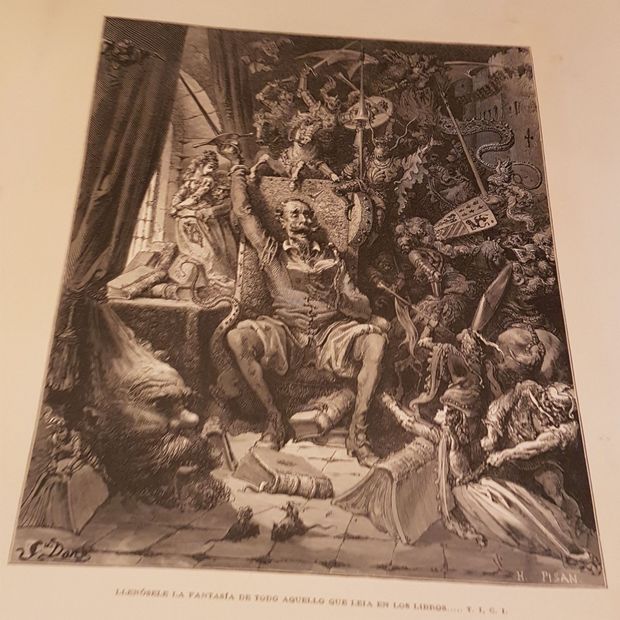
Miguel de Cervantes Saavedra, «El Ingenioso Hidalgo Don Quijote de la Mancha», edition with illustrations by Gustavo Doré, engravings by H. Pisan, in 2 volumes, printed by Imprenta y Librería Religiosa y Científica del Heredero de Don Pablo Riera, Robador Street, 24 and 26, Barcelona, 1875.
Original publication date
The original edition of «El Ingenioso Hidalgo Don Quijote de la Mancha» was published in 1605, with the second part released in 1615.
Illustrated edition details
This 1875 edition is notable for its elaborate illustrations by Gustavo Doré, a renowned French artist, and the detailed engravings by H. Pisan. The illustrations add a rich visual element to Cervantes' classic text, making this edition a significant artistic interpretation of the original work.
First Part, Chapter XVIII, excerpt
«—That knight you see over there with the yellow arms», Or,
«who bears on his shield a crowned lion,
bowed at the feet of a maiden,
is the valiant Laurcalco,
lord of the Silver Bridge;
the other with the golden flowered arms,
who bears on his shield three silver crowns on a blue field,
is the feared Micocolembo, grand duke of Quirocia;
the other with giant limbs,
who stands to his right hand,
is the never fearful Brandabarbarán de Boliche,
lord of the three Arabias,
who comes armed with that serpent's hide and
bears on his shield a door, which, according to legend,
is one of the doors of the temple that Samson destroyed when
he avenged himself on his enemies with his death.
But turn your eyes to the other side and
you will see before and in front
of the other army the always victorious and never defeated
Timonel of Carcajona, prince of New Biscay,
who comes armed with quartered arms,
blue, green, white, and yellow, and bears on his shield
a golden cat on a tawny field,
with an inscription that says «Miau»,
which is the beginning of his lady's name, who,
as they say, is the incomparable Miulina,
daughter of the duke Alfeñiquén of Algarve;
the other who presses down the back of that powerful steed,
who bears arms as white as snow and a shield white and
without any charges, is a novice knight, of French nation,
named Pierres Papín, lord of the baronies of Utrique;
the other who strikes the flanks with the iron-shod heels
of that painted and swift zebra and bears
the blue vair arms,
is the powerful duke of Nerbia, Espartafilardo del Bosque,
who bears as a charge on his shield an asparagus plant,
with an inscription in Castilian that says: «Tracks my fate».
And in this way, he went on naming many knights
from one and the other squadron that he imagined,
and to each of them, he gave
arms, colors, charges, and mottos on the spot,
driven by the imagination of his never-before-seen madness, and,
without stopping, he continued saying...».
Bibliographical reference of century XVII.
Classification: Castilian language and In black and white.
The author is Cervantes Saavedra, Miguel de.
Bibliographic reference mentioned in the following articles:


![Ver [Clemmensen, S.; 2012] en referencias bibliográficas. Libro abierto, hojas de plata, filo de oro, guardas de gules, tapas de sable.](../css/Libro.Bibliografia.png)
Clemmensen, S.; 2012
Steen Clemmensen, «The St. Gallen-Haggenberg Armorial: Introduction and Edition», published by www.armorial.dk, 258 pages, Farum, 2012.
This article is based on the manuscript from the St. Gallen Abbey Library, [St. Gallen; 1480] catalog number Cod. Sang. 1084, and includes a comprehensive introduction, analysis of the manuscript, and detailed indexes of the coats of arms and names.
Index
- Introduction and summary.
- Manuscript, authorship, and handicraft.
- Church and dioceses.
- Imaginary arms, Ternionen and Quaternionen.
- Imperial princes.
- German nobles and tournament societies.
- Later inserts.
- Segmentation, members of the Bodensee group, drawing styles, scripting hands.
- Bibliography, Index Armorum, Index Nominorum.
Bibliographical reference of century XXI.
Classification: Article, English language and In black and white.
Author: Clemmensen, Steen.
Bibliographical reference mentioned in the following article:
External resource:
Internal resources: ClemmensenS2012.SanktGallen.pdf This article in PDF format.


![Ver [Col, J. J. del; 2007] en referencias bibliográficas. Libro abierto, hojas de plata, filo de oro, guardas de gules, tapas de sable.](../css/Libro.Bibliografia.png)
Col, J. J. del; 2007
José Juan del Col, «Auxiliary Dictionary: Spanish-Latin for Modern Latin Use», Instituto Superior Juan XXIII, edited by Adrian Mandara, composition and layout by Zulma Iglesias and Daniel Cirio, 1250 pages, 23x17 centimeters, ISBN 978-950-9771-34-5, printed in Argentina by Sapienza Industria Gráfica, Undiano 84, Bahía Blanca, 2007.
Bibliographical reference of century XXI.
Classification: Dictionary, Castilian language and In black and white.
The author is Col, José Juan del.
Internal resources: ColJJdel2007.LatinDiccionario.pdf PDF format.


![Ver [Conway, D. J.; 2018] en referencias bibliográficas. Libro abierto, hojas de plata, filo de oro, guardas de gules, tapas de sable.](../css/Libro.Bibliografia.png)
Conway, D. J.; 2018
D. J. Conway, «Magickal, Mystical Creatures: Invite Their Powers into Your Life», 272 pages, published by Llewellyn Publications, Woodbury, 2018.
Index of fabulous beasts
- Unicorns, page 15, including Ki-Rin, Sin-You, Karkadann, Goat-Unicorns, Winged Sea-Unicorns;
- Flying Horses, page 29, including Pegasus, Winged Sea-Pegasus, Arabian-Burak, Sleipnir, Alsvidr, Arvakr;
- Centaurs, page 39;
- Satyrs and Fauns, page 51, including Jack in the Green, Pan, Urisk;
- Gigantic Birds, in the page 63 the part I begins and in the page 71 the part II begins;
- Human-Birds, page 79, including Garuda, Tengu, Egyptian Ba;
- Griffins, page 89, including Griffin-Demons, Hippogriff, Senmurv, Simurgh;
- Mystical Bulls and Bull-Men, page 99;
- Fabulous Lions, page 105;
- Magical Serpents, page 115;
- Riddling Sphinx, page 131;
- Mad Dogs and Hell Hounds, page 137;
- Water-Folk, page 153;
- Creatures of the Stony Stare, page 183;
- Gargoyles, page 189;
- Other Magical, Mythical Creatures, page 197.
Bibliographical reference of century XXI.
Classification: Symbolism, In black and white and English language.
Author: Conway, Deanna D. J..
External link:


![Ver [Costa y Turell, M.; 1858] en referencias bibliográficas. Libro abierto, hojas de plata, filo de oro, guardas de gules, tapas de sable.](../css/Libro.Bibliografia.png)
Costa y Turell, M.; 1858
Modesto Costa y Turell, «Tratado completo de la ciencia del blasón, o sea, Código heráldico-histórico; acompañado de una estensa noticia de todas las órdenes de caballería existentes y abolidas», Second edition corrected and augmented, 7 pages of prologue, 554 page, 26 pages with illustrations; size 25 centimeters, published by Libreria Española y Libreria de El Plus Ultra, Madrid, 1858.
Bibliographical reference of century XIX.
Classification: Castilian language and In black and white.
Author: Costa y Turell, Modesto.
The following article cites this bibliographic reference:
External resources:
Internal resources: CostaTurellM1858.33.paginas.597.pdf in PDF format for Adobe Reader.


![Ver [Cox, N.; 2009] en referencias bibliográficas. Libro abierto, hojas de plata, filo de oro, guardas de gules, tapas de sable.](../css/Libro.Bibliografia.png)
Cox, N.; 2009
Noel Cox, PhD, Professor of Law at the Auckland University of Technology, «The principles of international law governing the Sovereign authority for the creation and administration of Orders of Chivalry», edited by Rory Stanley, «Féil-Scríbhinn Liam Mhic Alasdair» ~ Essays Presented to Liam Mac Alasdair, Genealogical Society of Ireland, FGSI, pages 15-25, ISBN 9781898471677, Dublin, 2009.
Bibliographical reference of century XXI.
Classification: English language and In black and white.
The author is Cox, Noel.
Internal resources: CoxN2009.SovereignAuthorityOrdersChivalry.pdf PDF Format.


![Ver [Febrer, J.; Century XIII] en referencias bibliográficas. Libro abierto, hojas de plata, filo de oro, guardas de gules, tapas de sable.](../css/Libro.Bibliografia.png)
Febrer, J.; Century XIII
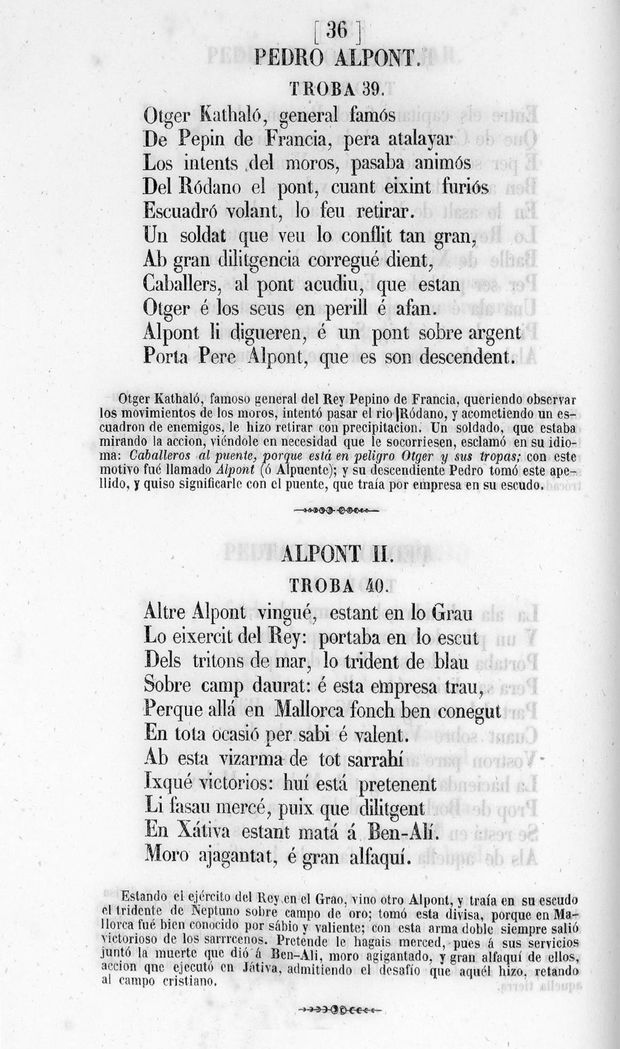
Jaime Febrer, «Trovas de Mossen Jaime Febrer: que tratan de los conquistadores de Valencia», edited by Joaquín María Bover, new edition made with reference to the first and an old manuscript, with notes, illustrated with portrait plates and heraldic plates, 312 pages, printed by Pedro José Gelabert, Palma, 1848.
Historical context and content
Jaime Febrer lived during the reigns of Jaime I El Conquistador, 1207-1276, and his son Pedro III El Grande of Aragon and I of Valencia, 1239-1285. Febrer is believed to have authored a manuscript detailing 278 knights who participated in the conquest of Valencia alongside Jaime I, forming the foundation of many noble lineages in the city and kingdom of Valencia.
The manuscript, dedicated to Pedro III and I of Valencia, is composed in short verses known as «trovas» ~ «trobas», written in the «Lemosín» language, an old form of Valencian. Each trova includes a description of the knights' coats of arms.
A re-edition of this manuscript was published by Joaquín María Bover in 1848 in Palma de Mallorca.
Illustrative example of trova 39, Alpont
The «trova 39» is dedicated to Pedro Alpont, whose ancestor helped the General Otger Kathaló and adopted the surname Alpont following an event involving a bridge. This poem «trova 39» serves as an illustrative example, describing the blazon of Pedro Alpont. The blazon described in this trova is simple: «Argent, a Bridge».
The story included in this trova tells how Otger Gotlant, also known as Oger Catalón or Catazlon, a general under King Pepin of France, was near the Rhône observing the Moors. He crossed the river by one of its bridges to better track the enemy’s movements. Suddenly, he was attacked by a squadron of Saracens, forcing him to retreat hastily. A soldier on the other side of the river saw this and began shouting in the Lemosín language, calling for reinforcements: «Al pont, caballers, al pont» ~ «To the bridge, knights, to the bridge», as Otger and his men were in danger. According to this «trova 39» by Jaime Febrer, from that moment on, this soldier was known by the surname Alpont. One of his descendants, named Pedro Alpont, participated in the conquest of Mallorca and later moved to Valencia, following King Jaime I El Conquistador, leaving behind the Alpont surname for his successors.
Another Alpont, referred to as Alpont II, appears in trova number 40, where his blazon is characterized by a trident.
Bibliographical reference of century XIII.
Classification: Valencian language and In black and white.
Author: Febrer, Jaime.
External resource:
Internal resources: FebrerJXIII.Trobas.BoverJM1848.Parcial.155.Paginas.pdf Partial PDF with the first 155 pages.


![Ver [Fernández de Enciso, M.; 1519] en referencias bibliográficas. Libro abierto, hojas de plata, filo de oro, guardas de gules, tapas de sable.](../css/Libro.Bibliografia.png)
Fernández de Enciso, M.; 1519
Martin Fernandez de Enciso, «Sum of Geography, which deals with all the parts and provinces of the world: especially the Indies. And deals extensively with the art of navigation, together with the sphere in the vernacular, with the regulation of the Sun and the North: newly made. With royal privilege.», 148 pages, House of Trade (Casa de la Contratación), Seville, 1519.
Preliminary note
Note that I try to use, even in these non-heraldic cases, the language of blazon, thus I speak of positions such as in chief, in base, dexter or sinister, arrangements such as in bend and in bend sinister and tinctures such as sable, azure or gules.
Zodiacal bands in armillary spheres: A comparative analysis of Marchant (1499) and Fernández de Enciso (1519) engravings
[Marchant, G.; 1499; page 15] and [Fernández de Enciso, M.; 1519; page 1] depict an armillary sphere with the zodiac signs, &Aries; Aries, &Taurus; Taurus, &Gemini; Gemini, &Cancer; Cancer, &Leo; Leo, &Virgo; Virgo, &Libra; Libra, &Scorpio; Scorpio, &Sagittarius; Sagittarius, &Capricorn; Capricorn, &Aquarius; Aquarius and &Pisces; Pisces, represented on a band around the sphere. I have compared both zodiacal bands by means of the composition of the previous image.
In this image I have made there are:
- In the 3rd row, the band of zodiac signs of the armillary sphere by [Marchant, G.; 1499].
- Above, in the 2nd row, the band of my interpretation of the same previous engraving.
- In chief, at the very top, in the 1st row, the zodiac signs in sable and azure, with those not visible, in the order of [Marchant, G.; 1499], that is, as read by the reader of the book, from his frontal perspective of the engraving, in counterclockwise direction, &Gemini;, &Taurus;, &Aries;, &Pisces;, &Aquarius;, &Capricorn;, &Sagittarius;, &Scorpio;, &Libra;, &Virgo;, &Leo; and &Cancer; which is not visible. Note that, for example, Taurus appears before Aries so the sequence is geocentric, that is, arranged from the point of view of an observer located at the center of the Earth, which is different from the book reader.
- Below, in the 4th row, the band of zodiac signs of the armillary sphere by [Fernández de Enciso, M.; 1519].
- In base, at the very bottom, in the 5th row, the zodiac signs in black and in cyan, with those not visible, in the order of [Fernández de Enciso, M.; 1519], that is, as read by the same reader of the book in counterclockwise direction, &Capricorn;, &Aquarius;, &Pisces;, &Aries;, &Taurus;, &Gemini;, &Cancer; which is not visible, &Leo;, &Virgo;, &Libra;, &Scorpio;, and &Sagittarius; which is also not visible. Note that in this case, for example, Aries appears before Taurus so the sequence is ecliptic, that is, from the point of view of an observer located in outer space, the point of view of the ecliptic sequence coinciding with the point of view of the book reader.
The 3 main differences observed are:
- [Marchant, G.; 1499], number 6 in the image, places at the top the zodiac signs that [Fernández de Enciso, M.; 1519], number 7 in the image, places at the bottom, as a curiosity it can be seen in my interpretation of [Marchant, G.; 1499] that for aesthetic reasons I placed at top and bottom the zodiac signs as [Fernández de Enciso, M.; 1519] does.
- They do not start in the same position, it is &Aries; Aries that has a more similar position in both but with one slot of difference.
- The signs in [Marchant, G.; 1499] and [Fernández de Enciso, M.; 1519] rotate in opposite directions.
The only important conceptual difference is the reverse rotation of the zodiac signs, that is, that [Marchant, G.; 1499] uses the geocentric sequence and [Fernández de Enciso, M.; 1519] uses the ecliptic sequence. In no case is it a printing error of an engraving in mirror, since neither of the two armillary spheres is engraved in mirror, as both have the zodiacal band in bend, and if they were engraved in mirror the zodiacal band would appear placed in bend sinister.
We could also study the few non-symmetrical signs that can be distinguished completely:
- For example, on the back side of the band of [Marchant, G.; 1499], &Scorpio; Scorpio has the scorpion’s stinger in the shape of an m pointing to sinister (the reader’s right), so it makes sense from the point of view of a geocentric observer.
- For example, on the back side of the band of [Fernández de Enciso, M.; 1519], &Leo; Leo seems to have the circle of its head to dexter (the reader’s left) and the curl of its tail to sinister (the left of a geocentric observer), while in &Scorpio; Scorpio, the stinger of the m-scorpion seems to point to dexter (the reader’s left) as if the sign were intended to be seen from the other side of the outside, piercing the band, so that the book reader sees the sign in mirror. Be that as it may, the arrangement of these 2 signs does not seem consistent with each other.
Although it is not a case of printing the engraving in mirror, such errors exist since, if we go beyond the armillary sphere of [Fernández de Enciso, M.; 1519] to study its outer decoration, we see that the SPQR, of «Senatus Populusque Romanus», is in mirror, I have marked it with a square of gules with the number 8 in the image, so that, although its armillary sphere is well printed, in the outer decoration the printer made a mistake and printed it the other way round.
Bibliographical reference of century XVI.
Classification: In black and white and Castilian language.
The author is Fernández de Enciso, Martín.
Bibliographic reference mentioned in the following articles:
External resources:
Internal resources: FernandezDeEncisoM1519.SumaDeGeographia.CatedraNaval.pdf in scanned PDF format at the Naval Chair, Spanish Navy, University of Murcia..


![Ver [Ferrer i Vives, F.; 1995] en referencias bibliográficas. Libro abierto, hojas de plata, filo de oro, guardas de gules, tapas de sable.](../css/Libro.Bibliografia.png)
Ferrer i Vives, F.; 1995
Francesc d'A Ferrer i Vives, «Heraldica Catalana», 3 volumes, Volume I A-F, Volume II G-P, Volume III Q-Z, ISBN of the complete work 84-7304-204-2, Legal Deposit B.20.464 - april 1995, Editorial Milla, Carrer de Sant Pau 21, Barcelona, 1995.
Bibliographical reference of century XX.
Classification: Catalan language and In black and white.
The author is Ferrer i Vives, Francesc d'A.
The following article cites this bibliographic reference:
Internal resources: Paper book.


![Ver [Fox-Davies, A. C.; 1909] en referencias bibliográficas. Libro abierto, hojas de plata, filo de oro, guardas de gules, tapas de sable.](../css/Libro.Bibliografia.png)
Fox-Davies, A. C.; 1909
Arthur Charles Fox-Davies of Lincoln's Inn, Barrister-at-Law, «A Complete Guide to Heraldry», author of «The Art of Heraldry», illustrated by nine plates in colour and nearly 800 other designs, mainly from drawings by Graham Johnston, Herald Painter to the Lyon Court, edited by T. C. & E. C. Jack, 16 Henrietta Street, W.C., and Edinburgh, editor of «Armorial Families», London, 1909.
Bibliographical reference of century XX.
Classification: De bibliotheca, In black and white and English language.
Author: Fox-Davies, Arthur Charles.
Here are the articles quoting this reference:
- Coat of arms of Alena Rehberger
- Design with a fess between 4 water-bougets
- Lloscós y Soldevilla, Guilaberto
- South Clifton, Lord of
Internal resources: FoxDaviesAC1909.CompleteGuideToHeraldry.712pages.pdf in PDF format 712 pages, FoxDaviesAC1909.CompleteGuideToHeraldry.387pages.pdf in PDF format 387 pages, FoxDaviesAC1909.CompleteGuideToHeraldry.353pages.pdf in PDF format 353 pages, FoxDaviesAC1909.CompleteGuideToHeraldry.epub in ePub format and Physical book on paper.


![Ver [González Echegaray, M. C.; 1969] en referencias bibliográficas. Libro abierto, hojas de plata, filo de oro, guardas de gules, tapas de sable.](../css/Libro.Bibliografia.png)
González Echegaray, M. C.; 1969
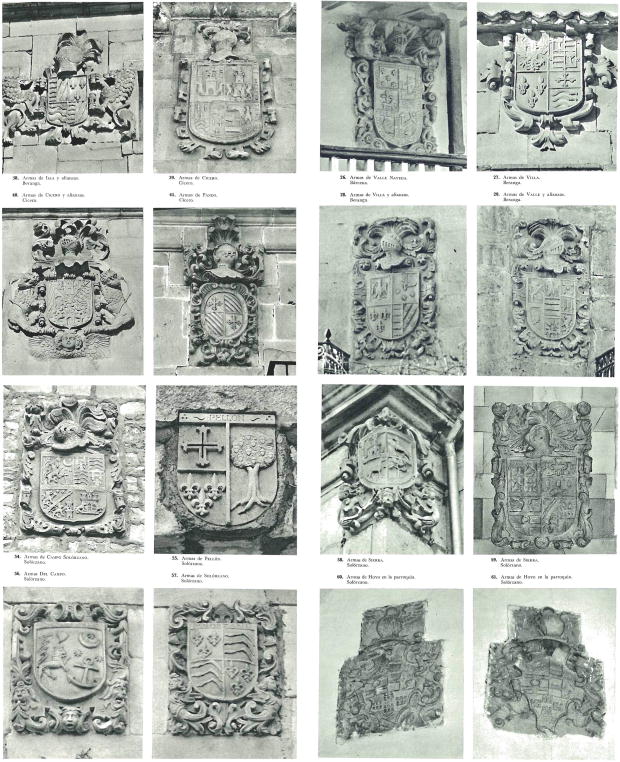
Maria del Carmen González Echegaray, «Escudos de Cantabria», 5 volumes, Volume I Merindad de Trasmiera, 376 pages, Volume II, Asturias de Santillana I, 474 pages, Volume III, Asturias de Santillana II, 388 pages, Volume IV, Asturias de Santillana y Bajo Asón, 434 pages, y Volume V, Valle de Sobra, Ruesga, Pas, Liendo, Guriezo y Provincia de Liébana, 314 pages, Legal deposit: Vi. 514-1969, edited by Joaquin Bedia Cano, Santander, printed by H. Fournier, Vitoria, 1969.
Bibliographical reference of century XX.
Classification: Castilian language and In black and white.
Author: González Echegaray, Maria del Carmen..
External links:
- Centro de Estudios Montañeses, Volume I Merindad de Trasmiera.
- Centro de Estudios Montañeses, Volume II, Asturias de Santillana I.
- Centro de Estudios Montañeses, Volume III, Asturias de Santillana II.
- Centro de Estudios Montañeses, Volume IV, Asturias de Santillana y Bajo Ason.
- Centro de Estudios Montañeses, Volume V, Valle de Sobra, Ruesga, Pas, Liendo, Guriezo y Provincia de Liebana.
Internal resources: GonzalezEchegarayMC1969.11.EscudosCantabria, Volume I Merindad de Trasmiera, 34 Mbytes, GonzalezEchegarayMC1969.12.EscudosCantabria, Volume II, Asturias de Santillana I, 31 Mbytes, GonzalezEchegarayMC1969.13.EscudosCantabria, Volume III, Asturias de Santillana II, 26 Mbytes, GonzalezEchegarayMC1969.14.EscudosCantabria, Volume IV, Asturias de Santillana y Bajo Ason, 22 Mbytes and and GonzalezEchegarayMC1969.15.EscudosCantabria, Volume V, Valle de Sobra, Ruesga, Pas, Liendo, Guriezo y Provincia de Liebana, 18 Mbytes.


![Ver [Gourdon de Genouillac, H.; 1889] en referencias bibliográficas. Libro abierto, hojas de plata, filo de oro, guardas de gules, tapas de sable.](../css/Libro.Bibliografia.png)
Gourdon de Genouillac, H.; 1889
Henri Gourdon de Genouillac, «L'Art Héraldique», part of the series Bibliothèque de l'enseignement des Beaux-arts, published under the direction of M. Jules Comte, Maison Quantin, 290 pages, 21 centimeters, Paris, 1889.
With some black and white small illustrations, it covers the art of heraldry, its history, rules, and applications, and serves as a comprehensive guide for artists, historians, and those interested in the heraldic art.
Contents
- Chapter I. The blazon - Pieces and figures that compose coats of arms, page 11.
- Chapter II. Repertoire of attributes, page 98.
- Chapter III. External ornaments of the shield, their use, and their misuse, page 145.
- Chapter IV. Municipal arms, page 188.
- Chapter V. The blazon in the arts, page 200.
- Chapter VI. Blazoned garments, page 207.
- Chapter VII. Seals, tokens, méreaux of corporations, communities, page 214.
- Chapter VIII. The fleur-de-lis, the eagle, the lion, the leopard, various figures, page 222.
- Chapter IX. The blazon in England, Germany, and other nations, page 230.
- Chapter X. Explanatory glossary, page 252.
- Chapter XI. Heraldic bibliography, page 275.
Bibliographical reference of century XIX.
Classification: French language and In black and white.
The author is Gourdon de Genouillac, Henri.
The following article cites this bibliographic reference:
External resource:
Internal resources: GourdonDeGenouillacH1889.LArtHeraldique.pdf PDF version..


![Ver [Herrera Casado, A.; 1993] en referencias bibliográficas. Libro abierto, hojas de plata, filo de oro, guardas de gules, tapas de sable.](../css/Libro.Bibliografia.png)
Herrera Casado, A.; 1993
Antonio Herrera Casado, «The Armorial of Aragon», Annals of the Royal Matritense Academy of Heraldry and Genealogy, pages 137-220, Madrid, 1992-1993.


![Ver [Iguiniz, J. B.; 1920] en referencias bibliográficas. Libro abierto, hojas de plata, filo de oro, guardas de gules, tapas de sable.](../css/Libro.Bibliografia.png)
Iguiniz, J. B.; 1920
Juan B. Iguiniz, «The National Coat of Arms: A Documented and Illustrated Historical Monograph», Member of the Royal Academy of History, 37 pages, Bouret Widow's Bookstore, Rue Visconti 53, Paris 23, Avenida Cinco de Mayo 45, Mexico 45, printed by Franco-Mexican Printing Company, S.A., calle de la Academia 10, Mexico, 1920.
A work focusing on the national arms of Mexico.
Bibliographical reference of century XX.
Classification: Castilian language and In black and white.
The author is Iguiniz, Juan B..
Internal resources: IguinizJB1920.Mexico.pdf PDF format.


![Ver [Lainé, P. L.; Lainé, J. J. L.; 1828] en referencias bibliográficas. Libro abierto, hojas de plata, filo de oro, guardas de gules, tapas de sable.](../css/Libro.Bibliografia.png)
Lainé, P. L.; Lainé, J. J. L.; 1828
P. Louis Lainé, J. J. L. Lainé, «Archives généalogiques et historiques de la noblesse de France, ou, Recueil de preuves, mémoires et notices généralogiques, servant à constater l'origine, la filiation, les alliances et lés illustrations religieuses, civiles et militaires de diverses maisons et familles nobles du royaume; Avec la collection des nobiliaires généraux des provinces de France», 11 volumes from 1828 to 1850, published by M. Lainé, printed by De Hauquelin et Dautriche, París, 1844.
Bibliographical reference of century XIX.
Classification: French language and In black and white.
The 2 authors are Lainé, P. Louis and Lainé, J. J. L..
External resources:
- Google books, Volume I, 1828.
- Google books, Volume II, 1829.
- Google books, Volume III, 1830.
- Google books, Volume IV, 1834.
- Google books, Volume V, 1836.
- Google books, Volume VI, 1839.
- Google books, Volume VII, 1841.
- Google books, Volume VIII, 1843.
- Google books, Volume IX, 1844.
- Google books, Volume X, 1846.
- Google books, Volume XI, 1850.


![Ver [Liñán y Eguizábal, J. de; 1911] en referencias bibliográficas. Libro abierto, hojas de plata, filo de oro, guardas de gules, tapas de sable.](../css/Libro.Bibliografia.png)
Liñán y Eguizábal, J. de; 1911
José de Liñán y Eguizábal, Count of Doña Marina, «Armorial of Aragon», printed by Establecimiento Tipográfico de L. Pérez, Huesca, 1911.
This book is part of a collection that also includes: «Heraldic Mottos» and «Heraldic Dictionary».
A facsimile edition exists, edited by Guillermo Redondo Veintemillas and Alberto Montaner Frutos, published by Institución Fernando el Católico, Zaragoza, 1994.
Bibliographical reference of century XX.
Classification: De bibliotheca, Armorial roll, Dictionary, In black and white and Castilian language.
Author: Liñán y Eguizábal, José de.
External resource:
Internal resources: LinanEguizabalJ1911.ArmorialDeAragon.Color.pdf PDF version scanned in color, although the book is in black and white, it looks more natural, LinanEguizabalJ1911.ArmorialDeAragon.BN.pdf PDF version scanned in black and white, it looks less natural and Facsimile edition in physical paper format.


![Ver [Ma, F.; Century XVI] en referencias bibliográficas. Libro abierto, hojas de plata, filo de oro, guardas de gules, tapas de sable.](../css/Libro.Bibliografia.png)
Ma, F.; Century XVI
Anonymous, «Genealogy of the Mǎ Family, 馬民家记», manuscript, from the late Ming to early Qing dynasty, 6 volumes, volume 1, 102 pages, volume 2, 304 pages, volume 3, 242 pages, volume 4, 202 pages, volume 5, 100 pages, and volume 6, 178 pages, total 1128 pages, dated between 1600 and 1735, circa 1735.
Disclaimer
These comments has been writen based on my limited knowledge of Classical Chinese. As such, it may contain inaccuracies or errors. I apologize for any errors and welcome corrections from those more knowledgeable in the subject. It is important to note that, although the manuscript is written in Classical Chinese, some characters in theses comments are in Simplified Chinese.
Cover
-
The title of the work on the cover is
«馬民家记», where:
- «民家记» means Genealogy, and
- «馬» is Mǎ in pīnyīn, it is the family name, literally meaning Horse.
-
The character «馬» is an ideogram, representing a galloping horse:
- the head faces left,
- three horizontal lines to the right of the head represent the mane blowing in the wind,
- the four vertical strokes below represent the legs, and
- the curved stroke at the bottom right symbolizes the tail.
-
Beneath the title on the cover,
we read, from top to bottom and right to left,
as is typical in traditional Chinese:
«六写全» where:
- «六» means six,
- «写» means book, it hasn't plural, books for us, and
- «全» can be translated as complete.
Four generations
The title might suggest it is just the family tree of the Mǎ family, but it is actually a chronicle of the history of a lineage over four generations. Therefore, although it is dated between 1600 and 1735, it is likely written closer to 1735.
The manuscript narrates the deeds and actions of four generations of the Mǎ family from the city of Liáoyáng in northeastern China:
- Great-grandfather: Mǎ Mingpei (1600–1666),
- Grandfather: Mǎ Xiongzhen (1634–1677),
- Father: Mǎ Shiji (1650–1714),
- Son: Mǎ Guozhen (1666–1720).
It seems to be a story of ascent and descent:
- The great-grandfather was a significant figure.
- The grandfather was even more prominent, eventually assassinated, and posthumously awarded titles and an honorary name, «Wenyi».
- The father and son, though important, did not reach the heights of their predecessors.
This manuscript contains official titles, title grants, imperial praises for their actions, historical events, and also the poetic and literary works of the four generations.
Scanned for readability by Westerners
The correspondence between these 6 volumes and the 9 scaned PDF files is as follows:
- Volume 1: PDF 1.
- Volume 2: PDF 2 and PDF 3.
- Volume 3: PDF 4 and PDF 5.
- Volume 4: PDF 6 and PDF 7.
- Volume 5: PDF 8.
- Volume 6: PDF 9.
The Chinese books are read: from back to front, from right to left, and from top to bottom.
The scanning process was done so that what would be the last pages of the book for us, and the first for the Chinese, are at the beginning of the PDF. The pages are scanned in pairs to be readable by Westerners: starting from page 2-1, read from right to left, with 1 blank, and continuing 4-3, 6-5, 8-9... until the end of the PDF file.
The Chinese script used in this manuscript is clear and legible compared to other documents from that era.
Pages
6 volumes:
- volume 1, 51*2 = 102 pages,
- volume 2, 65*2+87*2 = 304 pages,
- volume 3, 66*2+55*2 = 242 pages,
- volume 4, 48*2+53*2 = 202 pages,
- volume 5, 50*2 = 100 pages, and
- volume 6, 89*2 = 178 pages,
Bibliographical reference of century XVI.
Classification: Manuscript, Classical Chinese language and In black and white.
Author: unknown.
External links:
- Library of the Congress.
- Volume 2, initial part.
- Volume 2, final part.
- Volume 3, initial part.
- Volume 3, final part.
- Volume 4, initial part.
- Volume 4, final part.
- Volume 5.
- Volume 6.
Internal resources: MaFamiliaXVIII.01a.tapas.pdf Volume 1 PDF format, MaFamiliaXVIII.02a.tapas.pdf Volume 2, initial part, PDF format, MaFamiliaXVIII.02b.pdf Volume 2, final part, PDF format, MaFamiliaXVIII.03a.tapas.pdf Volume 3, initial part, PDF format, MaFamiliaXVIII.03b.pdf Volume 3, final part, PDF format, MaFamiliaXVIII.04a.tapas.pdf Volume 4, initial part, PDF format, MaFamiliaXVIII.04b.pdf Volume 4, final part, PDF format, MaFamiliaXVIII.05a.tapas.pdf Volume 5 PDF format and MaFamiliaXVIII.06a.tapas.pdf Volume 6 PDF format.
Bibliographical reference of century XVI.
Classification: Manuscript, Classical Chinese language and In black and white.
Author: unknown.
External links:
- Library of the Congress.
- Volume 2, initial part.
- Volume 2, final part.
- Volume 3, initial part.
- Volume 3, final part.
- Volume 4, initial part.
- Volume 4, final part.
- Volume 5.
- Volume 6.
Internal resources: MaFamiliaXVIII.01a.tapas.pdf Volume 1 PDF format, MaFamiliaXVIII.02a.tapas.pdf Volume 2, initial part, PDF format, MaFamiliaXVIII.02b.pdf Volume 2, final part, PDF format, MaFamiliaXVIII.03a.tapas.pdf Volume 3, initial part, PDF format, MaFamiliaXVIII.03b.pdf Volume 3, final part, PDF format, MaFamiliaXVIII.04a.tapas.pdf Volume 4, initial part, PDF format, MaFamiliaXVIII.04b.pdf Volume 4, final part, PDF format, MaFamiliaXVIII.05a.tapas.pdf Volume 5 PDF format and MaFamiliaXVIII.06a.tapas.pdf Volume 6 PDF format.


![Ver [Marchant, G.; 1499] en referencias bibliográficas. Libro abierto, hojas de plata, filo de oro, guardas de gules, tapas de sable.](../css/Libro.Bibliografia.png)
Marchant, G.; 1499
Guy Marchant, printer, «Compost et Kalendrier des Bergères», 68 folio leaves, more than 80 woodcut illustrations, Paris, August 17th, 1499.
This work complements the «Kalendrier des Bergiers» (1491), intended for a male audience, while this «Compost» is aimed at women readers, «Calendar of the Shepherdesses». Both books combine astrology, medicine, Christian morality, and practical advice. It includes numerous didactic woodcuts.
The image shows a golden armillary sphere, to be used in one of the versions of the coat of arms of Jean-Christophe Loubet del Bayle, extracted by me from one of the astrological pages of this book, page 15, «a iii».
In [Fernández de Enciso, M.; 1519; page 1] there is also an armillary sphere that bears certain similarities to the one appearing in [Marchant, G.; 1499; page 15]. A comparison of the bands with zodiac symbols of both spheres can be seen in [Fernández de Enciso, M.; 1519].
Bibliographical reference of century XV.
Classification: In black and white, French language and Incunabulum.
The author is Marchant, Guy.
Here are the articles quoting this reference:
External resources:
- Historical Library of Marquis of Valdecilla.
- Catalogue entry and full text.
- In the Digital Heritage of the Complutense University of Madrid.
Internal resources: MarchantG1499.CompostEtKalendrierDesBergeres.UCM.pdf, scanned PDF version from the Historical Library of the Complutense University of Madrid.


![Ver [Marecki, J.; 2012] en referencias bibliográficas. Libro abierto, hojas de plata, filo de oro, guardas de gules, tapas de sable.](../css/Libro.Bibliografia.png)
Marecki, J.; 2012
Józef Marecki, «Barwa w heraldyce» ~ «Color in heraldry», [Redakcja, P.; Mareckiego, J.; Rotter, L.; 2012; páginas 65-81], edited by Wydawnictwo Naukowe ~ Scientific Editorial of la Uniwersytet Papieski Jana Pawla II, 17 pages, Cracow, 2012.
Bibliographical reference of century XXI.
Classification: Symbolism, In black and white, Polish language and Article.
Author: Marecki, Józef.
The following article cites this bibliographic reference:


![Ver [Mayer, L. A.; 1933] en referencias bibliográficas. Libro abierto, hojas de plata, filo de oro, guardas de gules, tapas de sable.](../css/Libro.Bibliografia.png)
Mayer, L. A.; 1933
Leo Aryeh Mayer, «Saracenic Heraldry: A Survey», published by the University of Oxford at the Clarendon Press, Oxford, 1933.
The work provides a fully documented armorial roll of Saracenic sultans, princes, and knights, designed to meet the frequently expressed wish of students of Muslim archaeology. It is a fundamental reference work and remains as one of the most authoritative works on this subject.


![Ver [Menestrier, C. F.; 1659] en referencias bibliográficas. Libro abierto, hojas de plata, filo de oro, guardas de gules, tapas de sable.](../css/Libro.Bibliografia.png)
Menestrier, C. F.; 1659
Claude-François Menestrier, member of the Society of Jesus, «Le veritable art du blason et la pratique des Armoiries depuis leur Institution», «Auec Privilege du Roy»~avec le privilège du roi, 10 pages of introduction, 415 pages of content, 14 pages of indexes and 339 pages in total, Chez Benoît Coral, ruë Merciere à la Victoire, Lyon, 1659.
Bibliographical reference of century XVII.
Classification: In black and white and French language.
Author: Menestrier, Claude-François.
The following article cites this bibliographic reference:
External resource:


![Ver [Menestrier, C. F.; 1750] en referencias bibliográficas. Libro abierto, hojas de plata, filo de oro, guardas de gules, tapas de sable.](../css/Libro.Bibliografia.png)
Menestrier, C. F.; 1750
Claude-François Menestrier, member of the Society of Jesus, «La Nouvelle Methode Raisonnée du Blason pour l'Aprendre d'une Maniere Aisée: Reduite en Leçons par Demandes, Et par Réponses», «Auec Privilege du Roy» ~ with the privilege of the king, 298 pages accompanied by additional tables, Lyon, 1750.
Method
The central part of the book functions primarily as a dictionary, where heraldic terms are presented with the text of a blazon that contains them and the drawing of the blazon that illustrates them. The blazon illustrations are grouped on plates organized in a format of 5 rows and 5 columns, displaying 20 coats of arms per plate.
Facsimile edition details
This volume, produced by Vernoy for Arnaud de Vesgre, features a faithful and complete reproduction of the text and illustrations from the 1750 edition of the work by C. F. Menestrier. It was printed on 160-gram laid paper and bound in genuine hand-marbled leather as done in the past. The front cover and spine were stamped using a balance press with 22-carat fine gold. Printed in Switzerland by Idégraf, production by I.C.E.D., Arnaud de Vesgre, edition number 516, Legal deposit 1979 - 06.79.
Bibliographical reference of century XVIII.
Classification: In black and white, Dictionary and French language.
The author is Menestrier, Claude-François.
Internal resources: A facsimile edition as a physical book on paper.


![Ver [Mogrovejo de la Cerda, J.; 1636] en referencias bibliográficas. Libro abierto, hojas de plata, filo de oro, guardas de gules, tapas de sable.](../css/Libro.Bibliografia.png)
Mogrovejo de la Cerda, J.; 1636
Juan Mogrovejo de la Cerda, «Árbol de los Veras compuesto por Alonso López de Haro, Criado de Su Majestad y Ministro de su Real Consejo de las Órdenes y Cronista de los Reinos de Castilla y León», bound in original parchment, Milan, 1636.
Contents
The book contains a total of 66 main genealogical trees, each with an average of 28 nodes/persons, totaling over 1700 nodes. Additionally, it includes 41 lines of descent with approximately 1150 individuals. The content is composed of:
- Title page with the coat of arms of the Veras.
- Errata and additions.
- Dedication.
- Warnings and introduction by Juan Mogrovejo de la Cerda, folios 1 to 4.
- Tree of the Veras, folios 6 to 66, with 61 genealogical trees.
- Eulogies of five Christian princes known for their virtue and valor, with trees of their descendants up to the Count of La Roca, folios 67 to 72.
- Linear trees of descent from Don Fernando Carlos Antonio de Vera, Doña María Antonia de Vera y Tovar, and Doña Catalina de Vera, folios 73 to 114, with 41 trees.
- Limitations of the work on folio 115.
- Indexes with handwritten corrections, folios 116 to 122.
- Additions to the edition, including a genealogical tree of Don Luis Francisco de la Cerda Sandobal y Rojas, Marqués de Alcalá.
- Additional handwritten documents attached but not bound.
In the previous image, The canting arms of Juan Antonio de Vera y Zúñiga, Count of La Roca, in this book about his genealogy, are canting because «vair~veros~Vera».
The motto in the beak of his sable eagle is «Veritas Vincit», although some authors claim that not all his trees honor this motto [Vera-Ortiz, J.A.; 2009].
The colored version of the coat of arms in this image was painted by me. Blazon: Vair ancient, a bordure gules charged with eight saltires couped Or.
Bibliographical reference of century XVII.
Classification: De bibliotheca, In black and white and Castilian language.
The author is Mogrovejo de la Cerda, Juan.
Here are the articles quoting this reference:
External link:
Internal resources: Physical book..


![Ver [Moreno de Vargas, B.; 1795] en referencias bibliográficas. Libro abierto, hojas de plata, filo de oro, guardas de gules, tapas de sable.](../css/Libro.Bibliografia.png)
Moreno de Vargas, B.; 1795
Bernabé Moreno de Vargas, Perpetual councilor of the City of Mérida, «Discourse on the Nobility of Spain», corrected and added by the same author, A.E., Madrid, printed in the printing house of Antonio Espinosa, year of M. DCC. XCV. 1795. available at Escribano's Bookstore, Carretas street, Madrid, 1795
Bibliographical reference of century XVIII.
Classification: Castilian language and In black and white.
Author: Moreno de Vargas, Bernabé.
Internal resources: MorenoDeVargasB1795.DiscursosDeLaNobleza.pdf.


![Ver [Osmont, C.; 1858] en referencias bibliográficas. Libro abierto, hojas de plata, filo de oro, guardas de gules, tapas de sable.](../css/Libro.Bibliografia.png)
Osmont, C.; 1858
Charles Osmont, «L'Art Heraldique Contenant La Maniere d ' Apprendre Facillement Le Blason, Enrichy Des Figures Necessaires Pour L' Intelligence Des Termes», bound in leather, raised bands, title label, 8 preliminary leaves, 291 pages, and 35 plates, Paris, 1715.
Bibliographical reference of century XIX.
Classification: French language and In black and white.
The author is Osmont, Charles.
Internal resources: Physical book on paper.

![Ver [Paradin, C.; 1557] en referencias bibliográficas. Libro abierto, hojas de plata, filo de oro, guardas de gules, tapas de sable.](../css/Libro.Bibliografia.png)
Paradin, C.; 1557
Claude Paradin, «Devises heroïqves», with woodcuts attributed to Bernard Salomon, published by Jean de Tournes and Guillaume Gazeau, second edition, first edition published in 1551, dedication dated January 15, 1556, 261 pages, Lyon, 1557.
Description
The book includes emblems that consist of a motto, mostly in Latin, with a few in French or Greek, a woodcut illustration, and an explanation in French. The emblems feature devices of kings and rulers, symbols from the Bible, classical history, and other sources.
The title page is framed within a grotesque ornamental border. The copy includes the signature of C.F. Lüdorf, handwritten, on the lower left corner of the title page verso. There is irregular pagination with misprinted page numbers, foxing, and narrow margins. The book does not include a table of contents.
Examples of the first mottos
- Nullis praefentior aether, page 7.
- Manet insontem grauis exitus, page 9.
- Secum seret omina mords, page 11.
- Hîc ratio tentandi aditus, page 12.
- Pignora cara sui, page 13.
- Animis illabere nostris, page 14.
- Fortuna fidem mutata nouauir, page 15.
- Nutrisco & extinguo, page 16.
- Monstrant Regibus astra viam, page 18.
- Donec totum impleat orbem, page 20.
- Immensi tremor Oceani, page 22.
- Vlcus auos Troix, page 25.
- Non sine causa, page 27.
- Plus outre, page 29.
- Imperium sine fine dedi, page 32.
- Inextricabilis error, page 34.
- Securitas altera, page 36.
- Dederit'ne viam casus'ue Deus'ue, page 38.
- Fortitudo eius Rhodum tenuit, page 39.
- Non inferiora secutus, page 41.
- Ance ferit, quam flamma micet, page 43.
- Precium non vile laborum, page 44.
Bibliographical reference of century XVI.
Classification: Symbolism, In black and white and French language.
The author is Paradin, Claude.
External resource:
Internal resources: ParadinC1557.DevisesHeroiqves.pdf PDF format.

![Ver [Petra Sancta, S.; 1634] en referencias bibliográficas. Libro abierto, hojas de plata, filo de oro, guardas de gules, tapas de sable.](../css/Libro.Bibliografia.png)
Petra Sancta, S.; 1634
Silvester Petra Sancta, «De symbolis heroicis», a work consisting of 9 books, published by Antuerpiae, Ex officina Plantiniana Balthasaris Moreti, 480 pages with an additional 35 unnumbered pages, measuring 21 centimeters, Liège, 1634.
Description
The title page features an engraved pictorial border, signed by Peter Paul Rubens as the painter and Cornelis Galle as the engraver. The preface is signed by Silvester Petra Sancta, a member of the Society of Jesus, dated March 1634, specifically noted as «Leodij Kal. Mart. M.DC.XXXIV», indicating that the preface was signed in Liège on March 1, 1634.
The book includes the section titled «Elogium gentis Carafaeae ac stemma procerum eius» on pages XVII-LXXX, covering topics related to the Carafa family, including 7 genealogical trees with the family's coat of arms, «Gules, three bars Argent» repeated with or without cadency marks.
This work is notable for its engravings and symbolic content, including mottos and figures. It consists of nine books, with page 479 incorrectly numbered as 749, followed by page 780, and then 5 indexes that assist in finding specific symbols, such as the symbolism of the swan on page 16.
Petra Sancta's hatching code
in the engraving on page XVI is where Silvester Petra Sancta's hatching code is best appreciated, which is the most widely used in heraldry today, with the color Gules of the field represented by vertical lines and the metal Argent of the three bars in white.
Bibliographical reference of century XVII.
Classification: Symbolism, In black and white and Latin language.
Author: Petra Sancta, Silvester.
External links:
Internal resources: PietrasantaS1634.SymbolisHeroicis.00.pdf version 00, PDF format and PietrasantaS1634.SymbolisHeroicis.01.pdf version 01, PDF format.


![Ver [Piferrer, F.; 1858] en referencias bibliográficas. Libro abierto, hojas de plata, filo de oro, guardas de gules, tapas de sable.](../css/Libro.Bibliografia.png)
Piferrer, F.; 1858
Francisco Piferrer, «Treatise on Heraldry and Blazonry», illustrated by José Asensio y Torres, 292 pages, revised, corrected, and expanded by the same author, printed by Antonio Espinosa, Madrid, 1858.
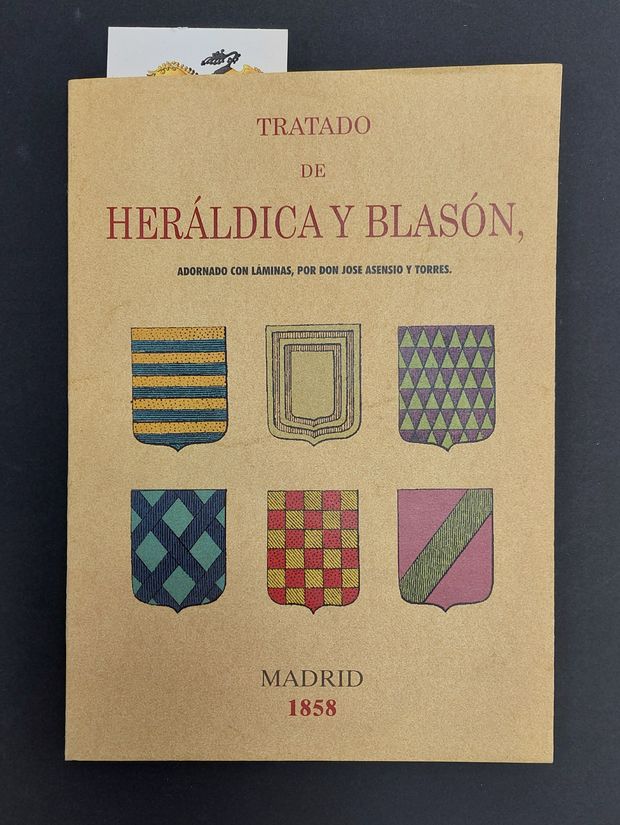
Francisco Piferrer was a 19th-century Spanish writer and historian, specialized in heraldry and genealogy. He was a prominent figure in the dissemination of nobiliary and heraldic history in Spain. Among his most notable works is this «Treatise on Heraldry and Blazon» published in 1858, a fundamental work that is still considered a reference in the field today. His work is valued for its meticulous documentation and for laying the foundations for other heraldic studies in Spain.
Bibliographical reference of century XIX.
Classification: De bibliotheca, Castilian language and In black and white.
The author is Piferrer, Francisco.
External resources:
- University of Granada, book record.
- University of Granada, original scanned PDF, under a Creative Commons Attribution-NonCommercial-NoDerivs 3.0 License.
Internal resources: PiferrerF1858.22.TratadoHeraldicaBlason.UGr.B-014-074_2.pdf is the 1858 edition scanned into a digital PDF format by the University of Granada and A facsimile edition as a physical book on paper.


![Ver [Pineda, Juan d.; 1783] en referencias bibliográficas. Libro abierto, hojas de plata, filo de oro, guardas de gules, tapas de sable.](../css/Libro.Bibliografia.png)
Pineda, Juan d.; 1783
Fray Juan de Pineda, «Libro del Passo Honroso, defendido por el excelente caballero Suero de Quiñones», compiled from an old handwritten book, second edition, 68 pages. printed by Antonio de Sancha, Madrid, 1783.
Fray Juan de Pineda, a Franciscan monk, compiled and abbreviated the original work by [Rodríguez de Lena, P.; Century XVI], in this edition, which is printed in a double-column format.
The book begins with the title «Comiénzase el libro del Passo Honroso: abreviado por fr. Juan de Pineda», which refers to the original work by Rodríguez de Lena. The main text recounts the heroic acts of Suero de Quiñones and his companions, detailing their 30-day defense of the Órbigo bridge against all challengers.
The book includes the full list of the 10 defenders, or maintainers, on page 67, and the 68 conquerors, or adventurers, on pages 67 and 68, and reports the results of the jousts for all of them.
Bibliographical reference of century XVIII.
Classification: Castilian language and In black and white.
The author is Pineda, Juan de.
Bibliographical reference mentioned in the following article:
External resource:
Internal resources: PinedaJ1783.PassoHonroso.pdf PDF Format.


![Ver [Porny, M. A.; 1765] en referencias bibliográficas. Libro abierto, hojas de plata, filo de oro, guardas de gules, tapas de sable.](../css/Libro.Bibliografia.png)
Porny, M. A.; 1765
Mark Anthony Porny, French Master at Eton College, «The Elements of Heraldry», 198 numbered pages and an unnumbered dictionary of 38 pages, illustrated with 23 plates, 8vo, octavo, printed for J. Newbery, in Saint Paul's Church-Yard, London, 1765.
Contents according to the author's description
- A clear definition and concise historical account of that ancient, useful, and entertaining science.
- The origin, antiquity, and diverse kinds of coats of arms, with their essential and integral parts considered separately.
- The several sorts of escutcheons, tinctures, charges, and ornaments used for coats of arms.
- The marks whereby bearers of the same coat of arms are distinguished from each other.
- Charges formed of ordinaries, celestial figures, animals, birds, fishes, vegetables, artificial, and chimerical figures.
- The laws of heraldry, practical directions for marshalling coats of arms, and the order of precedence.
- To which is annexed, a dictionary of the technical terms made use of in heraldry.
Bibliographical reference of century XVIII.
Classification: De bibliotheca, English language and In black and white.
Author: Porny, Mark Anthony.
Internal resources: Physical book on paper.


![Ver [Redakcja, P.; Mareckiego, J.; Rotter, L.; 2012] en referencias bibliográficas. Libro abierto, hojas de plata, filo de oro, guardas de gules, tapas de sable.](../css/Libro.Bibliografia.png)
Redakcja, P.; Mareckiego, J.; Rotter, L.; 2012
Pod Redakcja, Józefa Mareckiego y Lucyny Rotter, «Symbol - Snak - Przeslanie: Barwy i Ksztalty» ~ «Symbol - Sign - Message: Color and Shape», edited by Wydawnictwo Naukowe ~ Scientific Editorial of the Uniwersytet Papieski Jana Pawla II, 179 pages, ISBN 978-83-7438-321-9 Cracow, 2012.
Bibliographical reference of century XXI.
Classification: Symbolism, In black and white and Polish language.
The names of the authors are:
Bibliographical reference mentioned in the following article:
External resources:
Internal resources: RedakcjaPMareckiegoJRotterL2012.33.SymbolSignMessageColorShape.pdf PDF document in Polish.


![Ver [Rodríguez de la Vega, A.; XVI] en referencias bibliográficas. Libro abierto, hojas de plata, filo de oro, guardas de gules, tapas de sable.](../css/Libro.Bibliografia.png)
Rodríguez de la Vega, A.; XVI
Alonso Rodríguez de la Vega, «Roll of arms of Spain», 377 hand-numbered pages in Arabic numerals, all coat of arms illustrations are only partially outlined and without tinctures, written according to the title page in the time of Emperor Charles V, in the National Library of Spain, signatures Mss/3330, it is estimated from the XVI century.
Bibliographical reference of century XVI.
Classification: Manuscript, Armorial roll, In black and white and Castilian language.
The author is Rodríguez de la Vega, Alonso.
External resources:
- Detail of this armorial in the National Library of Spain.
- Bibliographic record of the National Library of Spain.
- Scanned Armorial in the National Library of Spain.
Internal resources: RodriguezDeLaVegaAXVI.11.Paginas.001.129, RodriguezDeLaVegaAXVI.12.Paginas.130.258.pdf and RodriguezDeLaVegaAXVI.13.Paginas.259.387.pdf.
Credits: This book belongs to the Biblioteca Nacional de España. License Creative Commons CC-BY. You may share, transform and create from images in the public domain that are accessible in the Hispanic Digital Library.


![Ver [Salazar y Mendoza, M. de; 1640] en referencias bibliográficas. Libro abierto, hojas de plata, filo de oro, guardas de gules, tapas de sable.](../css/Libro.Bibliografia.png)
Salazar y Mendoza, M. de; 1640
Miguel de Salazar y Mendoza, chronicler and chaplain of honor to Philip IV, «Formulario de armas», copied by Manuel Antonio Brochero in 1730, manuscript in the National Library of Spain, 11 volumes, volume 1 with 876 pages, call number MSS/11442, volume 2 with 378 pages, call number MSS/11443, volume 3 with 455 pages, call number MSS/11444, volume 4 with 392 pages, call number MSS/11445, volume 5 with 543 pages, call number MSS/11446, volume 6 with 455 pages, call number MSS/11447, volume 7 with 484 pages, call number MSS/11448, volume 8 with 309 pages, call number MSS/11449, volume 9 with 325 pages, call number MSS/11450, volume 10 with 302 pages, call number MSS/11451, volume 11 with 467 pages, call number MSS/11452, totaling approximately 5986 pages, 31 x 21 centimeters, circa 1640.
Dates of the original and copies
In Una Modesta Aportación Española, Juan Cartaya Baños writes that the original «Formulario de Armería» by Miguel de Salazar y Mendoza can be dated to around 1640, and that is the year I use to catalog it. He mentions that there is a 1739 copy that belonged to the King of Arms Zazo y Rosillo. In the National Library of Spain, there are three copies: this copy made by Manuel Antonio Brochero, titled «Formulario de Armería», in 11 volumes, dated by the BNE to the year 1730; another smaller copy made by Tomás Francisco Monleón y Ramiro, titled «Nobiliario o Formulario de Armería», with 980 pages, dated by the BNE to the year 1739; and another even smaller copy, titled «Formulario de Armería», with 404 pages, dated by the BNE to the 18th century.
Indexes and searches
There are indexes in all the volumes, these indexes are alphabetically ordered by the initial letter of the lineage name, but within each letter, the lineages are not strictly ordered, that is, they attempt to follow the order but there are some discrepancies, so you have to go through the entire letter to find the sought lineage. Next to the lineage name on the right, a number appears to locate it within that volume. Therefore, to ensure a thorough search, you need to review the indexes of all 11 volumes. For example, the Salazar lineage can be found in volume 1, in volume 2, in volume 4, etc. This mechanism, though somewhat challenging, allows for searches.
In the 2 images above, which are at the beginning of this section, you can see an example of a search, first, a page from the index of volume 3, dedicated to the letter S, where at the beginning of its second column, you can see the name of the Salmerón lineage, with the number 313 to its right. In the second image, you can see, from volume 3, the page with the number 313 at the top left, with the coat of arms of the Salmerón lineage described but not painted, which is similar to the one that appears in [Salazar y Mendoza, M. de; 1654; volume 5, page 196].
Coat of arms drawings
This armorial contains in volume 1, after the index, an introduction to the organization of coats of arms in quarters, spanning 12 pages and 7 black and white drawings.
Among the lineage descriptions, blank spaces are left, seemingly intended for drawing the coat of arms, many of these spaces are only outlined with the outer edge of a shield ending in a semicircular arch. The most complete coats of arms are those smaller ones that illustrate some lineages in black and white, mainly in the margins, as shown in the previous images. The spaces seem to be more systematically placed in the first volumes, with an average of 2 spaces per page, than in the later volumes.
Bibliographical reference of century XVII.
Classification: Manuscript, Armorial roll, Castilian language and In black and white.
Author: Salazar y Mendoza, Miguel de.
The following article cites this bibliographic reference:
External resources:
- National Library of Spain, Formulario de Armeria, 11 volumes, copy from 1730.
- National Library of Spain, Nobiliario o Formulario de Armeria, 980 pages, copy from 1739.
- National Library of Spain, Formulario de Armeria, 404 pages, copy from the 18th century.
Internal resources: SalazarMendozaM1640.Tomo.01.pdf volume 1 in PDF format, SalazarMendozaM1640.Tomo.02.pdf volume 2 in PDF format, SalazarMendozaM1640.Tomo.03.pdf volume 3 in PDF format, SalazarMendozaM1640.Tomo.04.pdf volume 4 in PDF format, SalazarMendozaM1640.Tomo.05.pdf volume 5 in PDF format, SalazarMendozaM1640.Tomo.06.pdf volume 6 in PDF format, SalazarMendozaM1640.Tomo.07.pdf volume 7 in PDF format, SalazarMendozaM1640.Tomo.08.pdf volume 8 in PDF format, SalazarMendozaM1640.Tomo.09.pdf volume 9 in PDF format, SalazarMendozaM1640.Tomo.10.pdf volume 10 in PDF format and SalazarMendozaM1640.Tomo.11.pdf volume 11 in PDF format.


![Ver [Salazar y Mendoza, M. de; 1654] en referencias bibliográficas. Libro abierto, hojas de plata, filo de oro, guardas de gules, tapas de sable.](../css/Libro.Bibliografia.png)
Salazar y Mendoza, M. de; 1654
Miguel de Salazar y Mendoza, chronicler and chaplain of honor to Philip IV, «Nobiliario de armas», with contributions from Lázaro Díez del Valle and others, manuscript in the National Library of Spain, 7 volumes, volume 1 with 1084 pages, call number MSS/12599, volume 2 with 926 pages, call number MSS/12600, volume 3 with 762 pages, call number MSS/12601, volume 4 with 614 pages, call number MSS/12602, volume 5 with 784 pages, call number MSS/12603, volume 6 with 1106 pages, call number MSS/12604, and volume 7 with 998 pages, call number MSS/12605, total approximately 6274 pages, 22 x 16 centimeters, by various authors with handwriting from different hands, 1654.
Dates and years
In volume 1, page 66, the year 1498 appears first, there are many years written on many pages, often related to events or positions held by the bearers of the described coats of arms. These are years from the 14th century onward. In the different volumes, there are also, though much less frequently, some dates with day, month, and year.
It is notable that, on that same page 66 of volume 1, on the last written line on the right, there appears what seems to be a signature, followed by the preposition «a» which is used in a formal sense to indicate the date on which a document is drafted or signed, and a specific date. It can be seen in the first image at the beginning of this section where « = Silva y Salazar. a 27 de abril de 1654 = » is highlighted in larger and darker font. However, only the second surname in «Silva y Salazar» matches that of the author «Miguel de Salazar y Mendoza», so it would be the signature of a different person or possibly a relative who worked for the author.
As I have mentioned, throughout this volume and the entire armorial, there are other years, generally earlier and some later than 1654. For example, in the 17th century, and specifically in this volume 1, on page 222, midway down on the right, the years 1697 and 1698 appear; on page 334, at the bottom right, I believe the year 1644 can be seen; on page 343, at the bottom right, the year 1638 appears.
To establish a reference year, I set it as 1654, only to have a temporal reference, even though this date appears signed by someone other than the author, on a note of paper smaller in size than the rest of the pages, this note talks about Ariño and is inserted just before the page dedicated to the coat of arms of the Ariño lineage. In any case, as can be observed and given the large number of pages, its writing must have extended over decades, and by several hands and authors, hence the appearance of later annotations such as 1697 and 1698.
The National Library of Spain dates it between 1601 and 1800, which is a very broad range of years.
Miguel de Salazar y Mendoza, was a chronicler and chaplain of honor to Philip IV who reigned from 1621 to 1665, he was the author of the «Formulario de Armeria» which some date to circa 1640, and of which there is a copy from 1739 that belonged to the King of Arms Zazo y Rosillo, also in the National Library of Spain.
Indexes and searches
There is a deteriorated index of all volumes at the beginning of volume 1, this index is alphabetically ordered by the initial letter of the lineage, but within each letter, the lineages are not strictly ordered, so one must read through the entire letter to find the sought lineage. Within each letter, there is an organization by volumes from 1 to 7, next to the name of the lineage on the right appears a number, and with that volume and number, the written coat of arms can be located. This mechanism, with some difficulty, allows for searches.
For example, in the 2 previous images, which are at the beginning of this section, you can see, first, a page from the index which is one of the pages dedicated to the letter S, in its section dedicated to volume 5, at the end of the 3rd column, you can see the name of the Salmerón lineage, with the number 196 to its right. In the second image, you can see, from volume 5, the page with the number 196 at the top right, with the coat of arms of the Salmerón lineage described, but not painted, and is similar to the description in [Salazar y Mendoza, M. de; 1640; volume 3, page 313].
Drawings of coats of arms
This armorial contains, in the first 43% of volume 1, coats of arms with a crest, helmet, mantling, and plume, in the final 57% of volume 1 and in the rest of the volumes from 2 to 7, only the coats of arms without a crest.
The drawn coats of arms are always finished with a rounded arch. The coats of arms without a crest are always in a vertical position. The coats of arms with a crest are tilted toward the dexter (heraldic right), which is the left from the observer’s point of view, and both the coat of arms and the helmet, the mantling, and the plume, these arms with its crest are pre-printed, for this, 2 different plates were used, which can be distinguished because one has a plume of 4 feathers and the other has a plume of 5 feathers, as can be seen in the 2 first images before this section.
The external shape of the arms without a crest and the interior of all the coat of arms arms in this armorial, are drawn in pen. As illustrated in the third image before this section: most of the coats of arms drawings are blank; some are only sketched; others have incomplete quarters; and some are more advanced; but none have tinctures. Only the tree in the Aznar lineage coat of arms in volume 1, page 66, is painted in vert (green), so I categorize this armorial as created in black and white. At the beginning of volume 1, it is noteworthy that among the initiated arms, there frequently appears a tree as the main charge.
Bibliographical reference of century XVII.
Classification: Manuscript, Armorial roll, Castilian language and In black and white.
The author is Salazar y Mendoza, Miguel de.
Bibliographical reference mentioned in the following article:
External resource:
Internal resources: 7 volumes in PDF format. SalazarMendozaM1654.Tomo.1.pdf tomo 1 in PDF format, SalazarMendozaM1654.Tomo.2.pdf tomo 2 in PDF format, SalazarMendozaM1654.Tomo.3.pdf tomo 3 in PDF format, SalazarMendozaM1654.Tomo.4.pdf tomo 4 in PDF format, SalazarMendozaM1654.Tomo.5.pdf tomo 5 in PDF format, SalazarMendozaM1654.Tomo.6.pdf tomo 6 in PDF format and SalazarMendozaM1654.Tomo.7.pdf tomo 7 in PDF format.


![Ver [Sarandeses Pérez, F.; 1966] en referencias bibliográficas. Libro abierto, hojas de plata, filo de oro, guardas de gules, tapas de sable.](../css/Libro.Bibliografia.png)
Sarandeses Pérez, F.; 1966
Francisco Sarandeses Pérez, of the Institute of Asturian Studies and of the International Institute of Genealogy and Heraldry, «Heraldry of Asturian Surnames», 408 pages, black and white illustrations, 27 centimeters, includes bibliography and indexes, foreword by H.R.H. The Duke of Calabria, prologue by The Hon. Mr. Julio de Atienza, Baron of Cobos de Belchite, photographs by Mr. Jesús González-Galatea, published by the Asturian Studies Institute of the José María Quadrado Trust, Superior Center for Scientific Research, Provincial Council of Oviedo, printed by Gráficas Europa. Legal Deposit S. 137-1966, Oviedo, 1966.
Cover of the original 1966 edition reproduced in the second facsimile edition of 1994.
Bibliographical reference of century XX.
Classification: Castilian language and In black and white.
Author: Sarandeses Pérez, Francisco.
Bibliographical reference mentioned in the following article:


![Ver [Tejero de Rojas y Sandoval, J. F.; XVII] en referencias bibliográficas. Libro abierto, hojas de plata, filo de oro, guardas de gules, tapas de sable.](../css/Libro.Bibliografia.png)
Tejero de Rojas y Sandoval, J. F.; XVII
Juan Francisco Tejero de Rojas y Sandoval, «Linajes de Aragón, Castilla, León, Galicia, Cataluña, Navarra y Vizcaya», 198 hand-numbered pages, each 2, in Arabic numerals, with numerous blank pages not numbered at the beginning and end, hand index on the back of the last page before the back cover, 22 x 17 centimeters, illustrations in the pages 26-29, in the National Library of Spain, signatures Mss/12617, it is estimated from the XVII century.
Unfinished
Although the last page 198 is signed on the back, the book seems unfinished because at the end of the last page there is a last line with a few loose words «Duke of...» which are a sign that it continues on the next page, but the next page is blank.
Bibliographical reference of century XVII.
Classification: Manuscript, In black and white and Castilian language.
The author is Tejero de Rojas y Sandoval, Juan Francisco.
External links:
- Detail of this manuscript in the National Library of Spain.
- Bibliographic record of the National Library of Spain.
- Scanned manuscript in the National Library of Spain.
Internal resources: TejeroRojasSandovalJFXVII.Pagina.11.Linajes.pdf.
Credits: This book belongs to the Biblioteca Nacional de España. License Creative Commons CC-BY. You may share, transform and create from images in the public domain that are accessible in the Hispanic Digital Library.


![Ver [Toral y Fernández de Peñaranda, E.; 1970] en referencias bibliográficas. Libro abierto, hojas de plata, filo de oro, guardas de gules, tapas de sable.](../css/Libro.Bibliografia.png)
Toral y Fernández de Peñaranda, E.; 1970
Enrique de Toral y Fernández de Peñaranda, «The Coat of Arms of the City of Úbeda: Notes for a Historical Study», Boletín del Instituto de Estudios Giennenses, pages 33-38 plus 10 illustrations, total 22 pages, number 66, ISSN 0561-3590, Jaen, 1970.
Bibliographical reference of century XX.
Classification: Article, Castilian language and In black and white.
The author is Toral y Fernández de Peñaranda, Enrique.
Internal resources: Provincial Council of Jaén https://www.dipujaen.es/boletinieg/pdf.raw?query=id:0000443974&page=38&lang=es&view=bieg and Rioja University https://dialnet.unirioja.es/descarga/articulo/2070193.pdf.


![Ver [Uhagón y Guardamino, F. R.; 1904] en referencias bibliográficas. Libro abierto, hojas de plata, filo de oro, guardas de gules, tapas de sable.](../css/Libro.Bibliografia.png)
Uhagón y Guardamino, F. R.; 1904
Francisco Rafael Uhagón y Guardamino, I Marqués de Laurencín, Director de la Real Academia de la Historia, Caballero de la Orden de Calatrava, «Libro de la Cofradía de Caballeros de Santiago de la Fuente, Fundada por los Burgaleses en Tiempo de Don Alfonso XI» noticia bibliográfica, publicada en la Revista de Archivos, Bibliotecas y Museos, impresa por la Tipográfica de la Revista de Archivos, Bibliotecas y Museos, calle de Olid 8, Madrid, 1904.
This article provides a bibliographical account of the illuminated manuscript [Cofradía de Santiago; Century XIV].
Bibliographical reference of century XX.
Classification: Article, Castilian language and In black and white.
Author: Uhagón y Guardamino, Francisco Rafael.
External link:


![Ver [Urfe; Century XV] en referencias bibliográficas. Libro abierto, hojas de plata, filo de oro, guardas de gules, tapas de sable.](../css/Libro.Bibliografia.png)
Urfe; Century XV
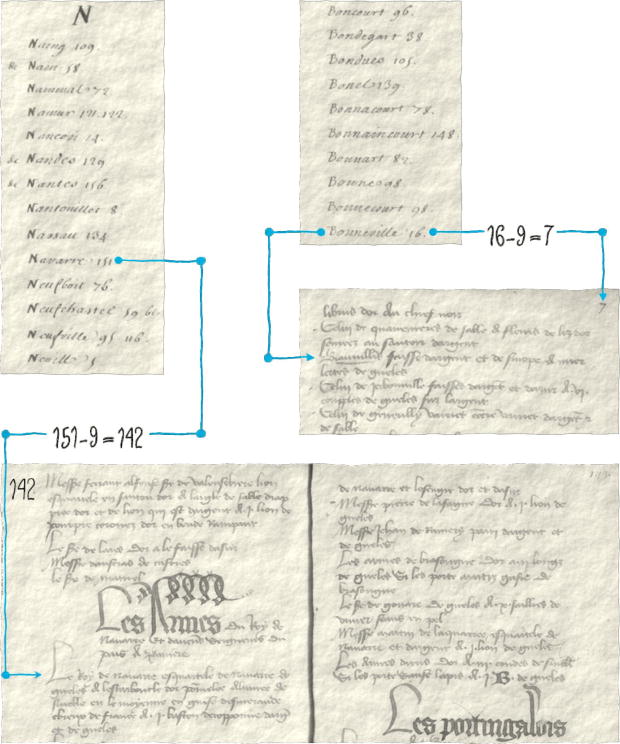
Urfé, unknown authors, «Urfe's Armorial», is currently in National Library of France (BnF, Bibliothèque nationale de France), in Paris, «Cabinet des titres» 927 as indicated on page I, cataloged with the code ms. fr. 32753, it is estimated from the XV century.
This armorial is written in French, on parchment measuring 19.5 x 14 centimeters, its compilation is believed to have been done in the 15th century, it presents 2,855 blazons in written form, but without illustrations, its blazons are organized into 54 sections, with an average of 17 blazons per page, the densest pages with about 20 blazons of 1, 2, or 3 lines per blazon, although some are longer. This Urfé armorial has served as a source for later armorials.
This manuscript contains a preliminary index, written later, of 61 pages, foliated the odd pages in consecutive Roman numerals from folio I to folio XXX. That is, 30 folios of 2 pages plus a final page, totaling 30 x 2 + 1 = 61 pages. This preliminary index consists of a name and a page number where the «theoretically», as will be explained below, corresponding blazon appears.
Next comes the true body of the Urfé armorial, of 162 pages, foliated only the odd pages, dated later than the compilation of the manuscript, in Arabic numerals, 2 by 2, from folio 1 to 161. That is, 1, 3, 5, 7, ..., 159, 161, and the last existing unnumbered page, as it is the 162nd which is even. I say that the 162nd is the last existing page because the National Library of France classifies it as an incomplete manuscript at the end.
It is a bit difficult to understand the relationship between the numbers that appear in the preliminary index, accompanying the names, and the numbering of the pages of the Urfé armorial. For example:
- Bouneville, which in the index appears with the number 16, is blazoned on page 7 (16 - 9 = 7).
- Navarre, for Navarra, in the index appears with the number 151, while the blazon of "Le Roy de Navarre" appears on page 142 (151 - 9 = 142).
This rule of subtracting 9, which has worked for me, but may not be of general use as, for example, Castille~Castile, on page VIII of the index, refers to page 140 of the content and it is there where it is actually found.
The Urfé armorial is in the public domain and the National Library of France, since February 23, 2012, has it published online with identification key ark:/12148/btv1b9063217v.
In this online version, as of today and until corrected, I believe that after page XIX, XVIII and XIX are repeated, just as folio 5 is repeated twice.
Bibliographical reference of century XV.
Classification: Armorial roll, Manuscript, In black and white and French language.
Author: unknown.
Bibliographical reference mentioned in the following article:
External resources:
- Urfe in Gallica BnF.
- Bouneville indexed in the page 16.
- although it is really on the page 7 (16-9=7).
- Navarra indexed in the page 151.
- although it is really on the page 142 (151-9=142).
- Castilla indexed in the page 140.
- is effectively, in this case, on the same page 140.


![Ver [Wade, W. C.; 1898] en referencias bibliográficas. Libro abierto, hojas de plata, filo de oro, guardas de gules, tapas de sable.](../css/Libro.Bibliografia.png)
Wade, W. C.; 1898
William Cecil Wade, «The symbolisms of heraldry or A treatise on the meanings and derivations of armorial bearings», 186 pages, 95 black and white pictures, Robert Holmes Collection, published by George Redway, London, 1898.
Although Romanticism sought the symbolism of the heraldic elements, I believe that the meaning of the elements of the coat of arms, if they have it, is provided by its creator or first bearer. In any case, the content of this symbolic book is the following:
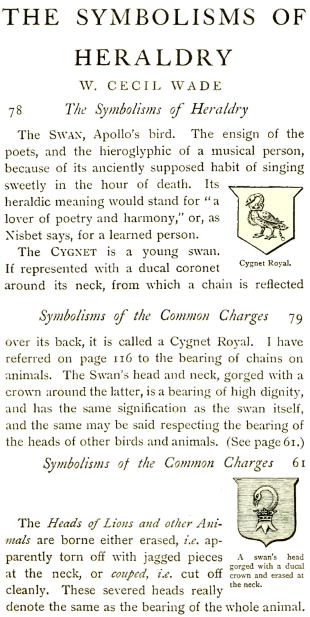
- The origin of armorial bearings; page 11.
- The symbolic side of heraldry; page 13.
- Heraldic colors and metals; page 35.
- The furs of heraldry; page 38.
- The meaning of heraldic lines; page 40.
- The symbolisms of the ordinaries; page 43.
- The division lines of the shield; page 55.
- The colors of the common charges not symbolical, chapter with 2 paragraphs only; page 57.
- Symbolisms of the common charges; page 59.
- Crowns, mitres, episcopal hats, etc.; page 138.
- Examples of symbolisms of colors and armorial bearings; page 149.
- Cadency and differencing; page 154.
- Alphabetic index; page 162.
Bibliographical reference of century XIX.
Classification: Symbolism, In black and white and English language.
The author is Wade, William Cecil.
The following article cites this bibliographic reference:
External resource:
Internal resources: WadeWC1898.SymbolismsHeraldry.pdf.


![Ver [Winkler, P. P. von; 1892] en referencias bibliográficas. Libro abierto, hojas de plata, filo de oro, guardas de gules, tapas de sable.](../css/Libro.Bibliografia.png)
Winkler, P. P. von; 1892
Pavel Pavlovich von Winkler, «Russian Heraldry: History and Description of Russian Coats of Arms with Illustrations of All the Coats of Arms of the Nobility, included in the General Armorial of the Russian Empire», printed by Typography and Lithography of I. A. Efron, Prachechny Passage, Building 6, 3 volumes, Volume 1, year 1892, 59 pages, 275 illustrations, includes a preface to the first volume, an index, basics of heraldry, and an armorial, Volume 2, year 1894, 71 pages, 302 illustrations, includes a preface to the second volume, an index, and an armorial, Volume 3, year 1894, 71 pages, 326 illustrations, includes a preface to the third volume, an index, and an armorial, St. Petersburg, 1892, 1894.
Description
This work by Pavel Pavlovich von Winkler is a comprehensive three-volume series on Russian heraldry, exploring the history and detailed descriptions of Russian coats of arms.
The first volume includes an introduction to heraldry, making it accessible to readers new to the subject. Each volume expands on specific aspects of Russian heraldry, providing an analysis and cataloging of various coats of arms throughout Russia's history.
Bibliographical reference of century XIX.
Classification: Armorial roll, Russian language and In black and white.
Author: Winkler, Pavel Pavlovich von.
Internal resources: WinklerPvon1892.Tomo.01 Pdf format, WinklerPvon1894.Tomo.02 Pdf format and WinklerPvon1894.Tomo.03 Pdf format.
-
Language
-
Categories of heraldry
-
Divisions of the field
- Without divisions
- Party per pale
- Party per fess
- Party per bend
- Party per bend sinister
- Tierce
- Tierce sinister
- Tierced per pale
- Tierced per fess
- Tierced per bend
- Tierced pallwise inverted
- Quarterly
- Quarterly per saltire
- Gyronny
- Party per fess, the chief per pale
- Party per pale, the sinister per fess
- Party per fess, the base per pale
- Party per pale, the dexter per fess
- Chapé
- Chaussé
- Embrassé
- Contre-embrassé
- Party per chevron
- Enté
- Enté en point
- Flanched
-
Metals
-
Colours
-
Furs
-
Other tinctures
-
Ordinaries and sub-ordinaries
-
Diminutives of the ordinaries
-
Geometric charges
-
Composite ordinaries
-
Inanimate charges from Nature
Atom, Crescent, Diamond, Emerald, Estoile, Increscent, Lightning flash, Moon, Mount, Mullet, Mullet of four points, Orbital, Plough of Ursa Major, Rainbow, Ray of the sun, River, Sea, Snowflake, Sun, Sun in splendour, Sun of May, Trimount, Water and Wave.
-
Vegetal charges from Nature
Acorn, Apple, Apple tree, Ash, Bluebonnet, Camellia, Chrysanthemum, Cinquefoil, Cornflower, Dogwood flower, Double rose, Elm, Fleur de lis, Flower, Gourd, Holm oak, Hop cone, Kapok tree, Laurel, Lily, Linden, Lotus flower, Madonna lily, Mexican cedar tree, Oak, Olive tree, Palm tree, Plantain plant, Pomegranate, Poplar leaf, Rose, Shamrock, Sunflower, Thistle, Tree, Tulip, Vine and Wheat.
-
Animal charges from Nature
Badger, Bald eagle, Barbel, Barn owl, Bear, Beaver, Beetle, Bighorn sheep, Blackbird, Boar, Brach hound, Bull, Doe, Dog, Dolphin, Dove, Eagle, Elephant, Falcon, Female figure, Fish, Flame, Fly, Fox, Frog, Goat, Goldfinch, Goose, Heron, Horse, Hummingbird, Jaguar, Lark, Leopard, Lion, Lion passant, Lion rampant guardant, Lioness, Lynx, Male figure, Martlet, Merino ram, Owl, Panther, Parrot, Peacock, Pelican, Pelican in her piety, Puffin, Quetzal, Raven, Roe deer, Rooster, Savage, Seagull, Serpent, She-wolf, Stag, Starling, Talbot, Tyger, Vulture, Warren hound and Wolf.
-
Parts of natural charges
Arm, Beak, Branch, Caboshed, Chest, Claw, Covert, Dorsal fin, Eagle claw, Ermine spot, Escallop, Feather, Foot (palmiped), Foreleg, Forepaw, Hand, Head, Heart, Hoof, Leaf, Neck, Ostrich feather, Palm frond, Paw, Roe deers' attires, Shoulder, Sprig, Stags' attires, Stem, Swallow-tail, Tail, Tail addorsed, Tail fin, Talon, Tooth, Trunk, Trunk (elephant), Two hands clasped, Two wings in vol, Udder, Wheat spike, Wing and Wrist.
-
Artificial charges
Ace of spades, Anchor, Anvil, Arch, Arm vambraced, Armillary sphere, Arrow, Axe, Bell, Bell tower, Beret, Bonfire, Book, Bookmark, Bow, Branding iron, Bridge, Broken, Buckle, Cannon, Cannon dismounted, Cannon port, Canopy roof, Carbuncle, Castle, Celtic Trinity knot, Chain, Chess rooks, Church, Clarion, Clay pot, Closed book, Club, Column, Comb, Compass rose, Conductor's baton, Cord, Covered cup, Crozier, Crucible, Cuffed, Cup, Cyclamor, Dagger, Double vajra, Drum, Ecclesiastical cap, Fanon, Federschwert, Fleam, Four crescents joined millsailwise, Galician granary, Garb, Gauntlet, Geometric solid, Grenade, Halberd, Hammer, Harp, Host, Hourglass, Key, Key ward, Knight, Knot, Lantern, Letter, Line, Loincloth, Menorah, Millrind, Millstone, Millwheel, Monstrance, Mortar, Mullet of six points pierced, Nail, Non-classic artifact, Norman ship, Number, Oar, Oil lamp, Open book, Page, Pair of scales, Parchment, Pestle, Piano, Pilgrim's staff, Plough share, Polish winged hussar, Port, Portcullis, Potent, Quill, Ribbon, Rosette of acanthus leaves, Sabre, Sackbut, Sail, Scroll, Scythe, Sheaf of tobacco, Ship, Skirt, Spear, Spear's head, Stairway, Star of David, Step, Sword, Symbol, Tetrahedron, Torch, Tower, Trident, Trumpet, Turret, Two-handed sword, Wagon-wheel, Water-bouget, Wheel, Winnowing fan and With a turret.
-
Immaterial charges
Angel, Archangel, Basilisk, Dragon, Dragon's head, Garuda, Golden fleece, Griffin, Heart enflamed, Justice, Mermaid, Our Lady of Mercy, Ouroboros, Paschal lamb, Pegasus, Phoenix, Sacred Heart of Jesus, Saint George, Sea-griffin, Trinity, Triton, Unicorn, Winged hand and Wyvern.
-
External elements
-
Heraldic creations
-
References
-
Formats
-
Keywords on this page
Armorial roll, Article, Azure, Bibliography, Bordure, Charged, Five, Crown, Crown of Count, Party per fess, De bibliotheca, Dictionary, In black and white, Armillary sphere, Schema, Mullet, Genealogy, War cry, Gules, Incunabulum, Infamed, Motto, Castilian language, Catalan language, Classical Chinese language, French language, English language, Latin language, Polish language, Russian language, Valencian language, Arab language, Lineage, Manuscript, Eight, Or, Party per pale, Millstone, Argent, Without divisions, Kingdom of Aragon, Century XIX, Century XV, Century XVI, Century XVII, Century XVIII, Century XX, Century XXI, Symbolism and One.

